
The ERA-NET promoting European research on biodiversity
STAKEHOLDER
ENGAGEMENT
Handbook
BiodivERsA

© BiodivERsA, Paris, 2014
BiodivERsA2 (2010-2014), ERA-Net funded under the
EU’s 7th Framework Programme for Research.
BiodivERsA is the network of national funding organisations
promoting pan-European research that oers innovative
opportunities for the conservation and sustainable manage-
ment of biodiversity and ecosystem services.
For further information on the ERA-NET BiodivERsA2,
please contact:
Coordinator
Xavier Le Roux
BiodivERsA Secretariat
Executive Manager: Frédéric Lemaître
frederic.lemaitr[email protected]
Fondation pour la Recherche sur la Biodiversité
195, rue St Jacques
75005 Paris
France
Tel: +33 (0)1 80 05 89 37
Fax: +33 (0)1 80 05 89 59
www.biodiversa.org

Acknowledgements:
BiodivERsA would like to thank everyone who contributed to the development of this Handbook.
The main authors were Emma Durham, Helen Baker, Matt Smith, Elizabeth Moore and Vicky Morgan of the Joint
Nature Conservation Committee UK (JNCC).
Xavier Le Roux, Frédéric Lemaître, Claire Freour and Claire Blery of the Fondation pour la Recherche sur la Biodiver-
sité (FRB, France), Hilde Eggermont of the Belgian Biodiversity Platform/ BELSPO (Belgium) and Henrik Lange of the
Swedish Research Council FORMAS (Sweden) provided contributions and support.
The Partners in BiodivERsA2 contributed information on national practices.
Additional material and review was provided by Ros Bryce (Perth College, University of the Highlands and Islands, UK),
Mark Reed (Birmingham City University, UK) and Anna Everly (Project Maya).
Representatives from 21 of the BiodivERsA research projects, along with Peter Bridgewater and Richard Ferris (JNCC,
UK), Marie Vandewalle (Biodiversity Knowledge), Juliette Young (SPIRAL), Cathy Jolibert (University of Barcelona,
Spain), Mark Reed (Birmingham City University, UK) and Anna Evely (Project Maya), made important contributions at
a workshop in April 2013.
The Handbook was copy edited by Neil Ellis (JNCC, UK) and the design and layout completed by Angélique Berhault
(Belgian Biodiversity Platform/ BELSPO, Belgium).
BiodivERsA is also grateful to all those who kindly contributed to the development of the Handbook through response
to the public consultation process.
This publication should be cited as:
Durham E., Baker H., Smith M., Moore E. & Morgan V. (2014). The BiodivERsA Stakeholder Engagement Hand-
book. BiodivERsA, Paris (108 pp).
For further information on this report, contact:
Helen Baker ([email protected].uk) or Matt Smith ([email protected].uk)
© BiodivERsA, Paris, 2014
BiodivERsA2 (2010-2014), ERA-Net funded under the
EU’s 7th Framework Programme for Research.
BiodivERsA Stakeholder Engagement Handbook
Best practice guidelines for stakeholder engagement
in research projects

Contents
Foreword: why does BiodivERsA promote stakeholder engagement in research projects? ................. 1
Part 1 ...................................................................................................................................................... 3
Introduction ............................................................................................................................................ 3
Background ............................................................................................................................................ 3
How does the Handbook work?............................................................................................................. 4
What do we mean by engagement? ...................................................................................................... 5
What is a stakeholder? ........................................................................................................................... 5
Why is stakeholder engagement benecial? .......................................................................................... 5
Challenges and limits to engagement .................................................................................................... 9
Key points to consider for eective stakeholder engagement ............................................................. 13
How BiodivERsA can help in stakeholder engagement ....................................................................... 15
General information and advice ........................................................................................................... 15
Information from other researchers and projects ................................................................................. 15
References ........................................................................................................................................... 16
Part 2 .................................................................................................................................................... 20
Why engage with stakeholders ............................................................................................................ 20
Scope and context ............................................................................................................................... 21
References ........................................................................................................................................... 25
Part 3 .................................................................................................................................................... 28
How to identify stakeholders ................................................................................................................ 28
Stage 1: Who are your stakeholders? .................................................................................................. 28
Stage 2: Assess, analyse and prioritise stakeholders .......................................................................... 33
Stage 3: Understand your stakeholders ............................................................................................... 39
Summary of the three stages of stakeholder identication .................................................................. 42
References ........................................................................................................................................... 43
Part 4 .................................................................................................................................................... 46
When to engage with stakeholders ...................................................................................................... 46
Mapping stakeholder roles to dierent stages of the project lifecycle................................................. 47
References ........................................................................................................................................... 50
Part 5 .................................................................................................................................................... 51
Methods for engagement ..................................................................................................................... 51
Types of engagement method .............................................................................................................. 51
Practical methods notes ...................................................................................................................... 56
Engagement skills ................................................................................................................................ 56
Matching methods to levels of engagement ........................................................................................ 57
n CONTENTS-
FOREWORD: Why does BiodivERsA promote stakeholder engagement in research projects? 6
PART 1: INTRODUCTION 8
Background 10
How does the handbook work? 11
What do we mean by engagement? 11
What is a stakeholder? 12
Why is stakeholder engagement benecial? 12
Challenges and limits to engagement 15
Key points to consider for eective stakeholder engagement 19
How BiodivERsA can help in stakeholder engagement 21
General information and advice 21
Information from other researchers and projects 21
References 22
PART 2: WHY ENGAGE WITH STAKEHOLDERS 24
Why engage with stakeholders 26
Scope and context 28
References 32
PART 3: HOW TO IDENTIFY STAKEHOLDERS 34
How to identify stakeholders 36
Stage 1: Who are your stakeholders? 36
Stage 2: Assess, analyse and prioritise 40
Stage 3: Understand your stakeholders 46
Summary of the three stages of stakeholder identication 49
References 51
PART 4: WHEN TO ENGAGE WITH STAKEHOLDERS 52
When to engage with stakeholders 54
Mapping stakeholder roles to dierent stages of the project lifecycle 55
References 59
PART 5: METHODS FOR ENGAGEMENT 60
Methods for engagement 62
Types of engagement method 62
Practical methods notes 67
Engagement skills 67

Matching methods to levels of engagement 68
References 69
PART 6: PLANNING THE DETAIL OF THE ENGAGEMENT 70
Planning the detail of the engagement 72
The engagement planning table 73
Practicalities, feasibility and implementation 75
The engagement table: share, adapt and update 76
References 77
PART 7: MANAGING STAKEHOLDER CONFLICT 78
Managing stakeholder conict 80
Conicts with and between stakeholders: types and causes 80
Stakeholder perspectives on conict 81
Analysing conict 83
Conict management tools 85
Constructing a conict timeline 85
References 89
PART 8: MONITORING AND EVALUATING THE ENGAGEMENT 90
Monitoring and evaluating the engagement 92
Benets of evaluation 93
What to evaluate? 93
When to evaluate? 93
Stages of evaluation 94
Stage 1: From the outset 94
Stage 2: Throughout the process – on-going evaluation 94
Stage 3: Final evaluation 95
Evaluating the process 95
Evaluating the outcomes 96
References 97
APPENDIX 1: Approach used to develop case studies to demonstrate the dierent stages 100
in stakeholder engagement in biodiversity research
Aims 100
Methods 100
COPYRIGHTS 104
ANNEXES: available online at http://www.biodiversa.org/577

biodiversa stakeholder engagement handbook
6
n FOREWORD-
WHY DOES BIODIVERSA PROMOTE STAKEHOLDER ENGAGEMENT IN RESEARCH PROJECTS?
BiodivERsA is the network of national funding agen-
cies in Europe that aims to build a dynamic plat-
form for encouraging excellent and policy-relevant
biodiversity research at a pan-European scale.
Between 2008 and 2014, it launched ve major
calls for proposals on prioritised topics that corre-
spond to the most pressing strategic issues that
biodiversity and ecosystem services currently face.
BiodivERsA aims to launch annual calls in future.
BiodivERsA partners recognise that research on biodi-
versity and associated ecosystem services is not only
an environmental issue, but as much an economic,
political, food-security and energy-security one. Being
a cross-cutting subject, biodiversity research needs to
promote interdisciplinarity, integrate a range of actors,
reach academic excellence, and have a clear soci-
etal impact. Biodiversity scientists have already been
involved in the provision of knowledge to stakehold-
ers, including policy makers, adopting new ways of
disseminating and explaining their ndings. Still, for
researchers it is not always clear how to eectively
engage with stakeholders as exemplied by a recent
statement from the principal investigator of one of the
BiodivERsA-funded projects: “A key point for me is
understanding who are the key persons to be involved
in research and what is the best way of communicating
research results while having an impact; which is the
lever we need to activate in order to make our results
be used and change the course for the foreseeable
future”.
In this context, BiodivERsA is promoting science-
society and science-policy interfacing along the whole
research process, from inception onwards (Figure F1).
BiodivERsA recognizes that it is particularly challeng-
ing for researchers to ensure academic excellence
and societal impact at the same time. In particular,
it appears that biodiversity scientists (probably as
scientists from many other domains) are very strong in
developing and using scientic frameworks and meth-
odologies, but often lack such clear frameworks and
methodologies when engaging with stakeholders. A
selection of frameworks and methodologies designed
to ensure a balanced representation of relevant stake-
holders in research activities are available, but are
often not applied in biodiversity research.
In this context, BiodivERsA has developed this best
practice handbook on stakeholder engagement
in research projects, providing practical guidance
to researchers to better plan and engage with non-
academic stakeholders, including policy makers. The
development of this handbook has been led by the
Joint Nature Conservation Committee (JNCC), one
of the UK partners in BiodivERsA and an established
authority in the eld of stakeholder engagement prac-
tices. The objective of this BiodivERsA handbook is
not to provide a detailed and prescriptive methodol-
ogy; the handbook provides a framework and selec-
tion of tools so that each research consortium can
determine which types of stakeholder engagement are
the most protable for their research project.
Making the engagement process more inclusive and
enhancing the legitimacy and societal relevance of
scientic research is considered a crucial aspect of
BiodivERsA’s activities to reinforce the European
research community in the eld for reaching excel-
lence in terms of both academic outputs and societal
relevance. We hope this handbook will further pave the
way to knowledge provision and illuminate solutions
for better protecting, managing and using biodiversity
to tackle key environmental and societal challenges at
the European level.
Xavier Le Roux
FRB, BiodivERsA coordinator and CEO
Hilde Eggermont
BELSPO, BiodivERsA WP5 leader
Helen Baker
JNCC, leader of the Task for stakeholder
engagement in BiodivERsA
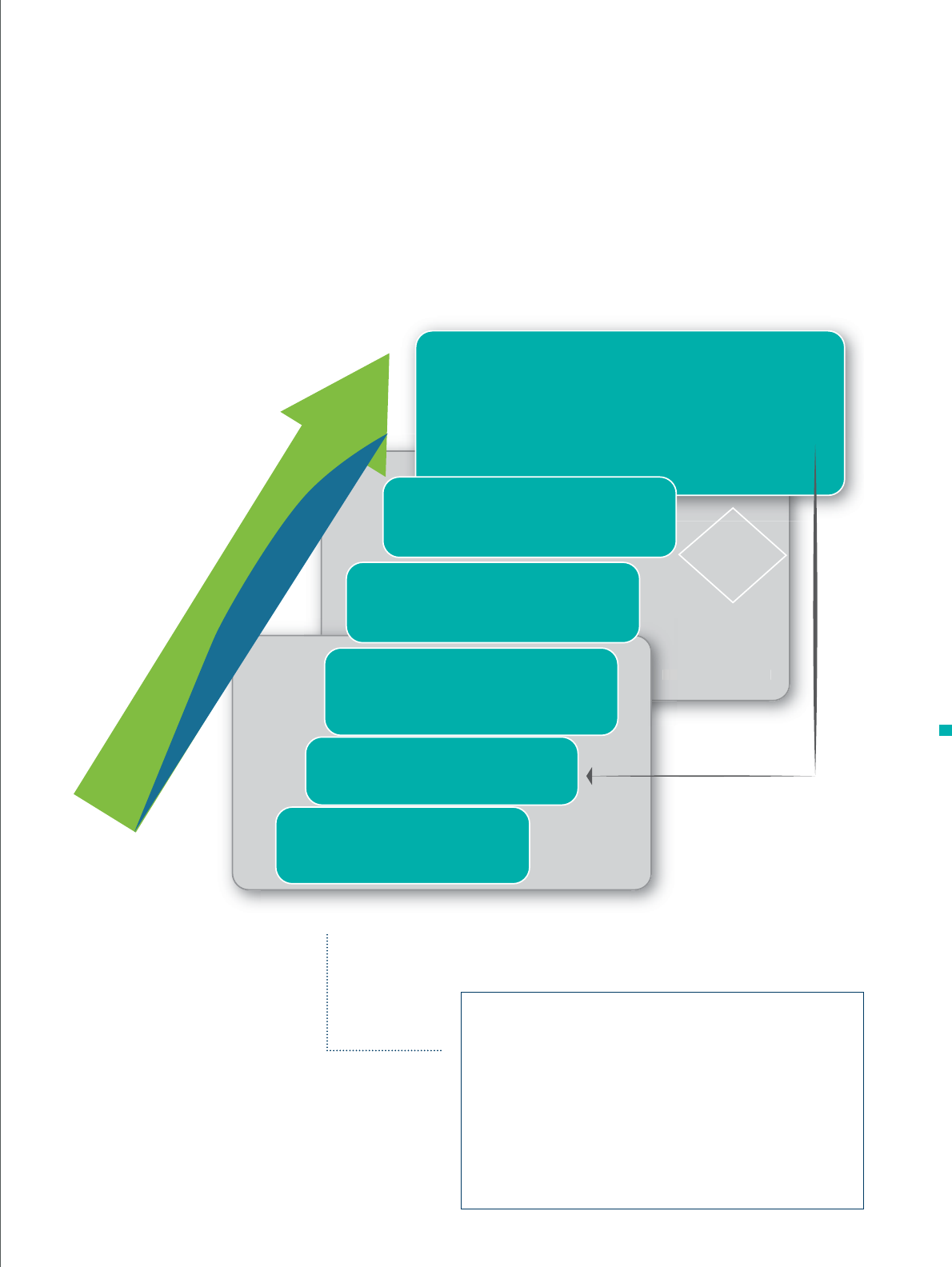
biodiversa stakeholder engagement handbook
7
CO-PRODUCTION
O
-PRODUCTIO
N
C
O
CO-DESIGN
DISSEMINATION OF RESULTS AND PROMOTION
OF FUNDED PROJECT IMPACT
Results dissemination to stakeholders and policy
makers
-By the project leaders themselves
-By BiodivERsA through specific materials
(e.g. policy briefs)
Evaluation of funded project outcomes and impacts
Assessments of both academic excellence &
societal impact
Survey & monitoring of funded projects
Societal impacts assessment by the
stakeholder advisory board
Transdisciplinarity
stakeholder
engagement
Identification of topics for joint calls
& programmes alignment
Use of specific evaluation criteria (policy relevance; societal
impact; stakeholder engagement)
Establishment of a common roadmap
Priorities and topics depend on societal
challenges
Mapping
Involvement of funding agencies and ministries +
stakeholder & scientific advisory boards
Stakeholder involvement
Academic involvement
Figure F1. Approach and methodology used to engage
stakeholders and promote the science-policy and
science-society dialogue in BiodivERsA throughout
the research (development) process. While academic
excellence is a major criterion for evaluating research
to be supported in BiodivERsA, innovative approaches
are used (from co-design of programmes to promotion
of research results) to increase the societal impact of
the funded research.

biodiversa stakeholder engagement handbook
8
› Background
› How does the Handbook work?
› What do we mean by engagement?
› What is a stakeholder?
› Why is stakeholder engagement benecial?
› Challenges and limits to engagement
› Key points to consider for eective stakeholder engagement
› How BiodivERsA can help in stakeholder engagement
›› Case studies
Benets of stakeholder engagement
Barriers to successful engagement: Science to policy
Allow time for scoping and pilot studies
What will the outputs of the stakeholder engagement process be?
Introduction

biodiversa stakeholder engagement handbook
9
Part 1

biodiversa stakeholder engagement handbook
10
n BACKGROUND-
The BiodivERsA Stakeholder Engagement Handbook
has been created for researchers planning and carry-
ing out research projects on biodiversity and ecosys-
tem services, and may be a useful resource for the
wider environmental science community. It is designed
to assist research teams identify relevant stakeholders
to engage with in order to enhance the impact of their
work, and select appropriate methods of stakeholder
engagement. It may also be useful for those evaluating
applications to BiodivERsA research calls as context
for the specic approaches taken by research teams.
Biodiversity and ecosystems research can have wide
ranging applications and benets; it is a cross-cutting
subject, which has economic, social and political
impacts. Thus, to be eective and comprehensive
biodiversity research needs to take a trans-disciplin-
ary approach and to involve a wide range of dierent
researchers and scientists from dierent disciplines
1
,
from ecologists to social scientists and economists,
as well as other stakeholders, from engineers to policy
makers, land-owners, businesses, NGOs, the media,
and the general public. A trans-disciplinary approach
has its own complications; those involved may well
have dierent ways of approaching and undertaking
the research, as well as diering views on the desired
aims and outcomes of the research. The ndings
from research need to be communicated eectively
2
and acted upon, in order to bring about a change in
attitudes and behaviour which ultimately may deliver
better outcomes for biodiversity and society. However,
the complex nature of biodiversity issues means that
agreement on concepts and solutions from such a
diverse range of stakeholders is rarely straightforward,
and can be dicult to achieve.
BiodivERsA is a pan-European biodiversity research
funding mechanism that generates new knowledge
for the conservation and sustainable management
of biodiversity. It follows that the main users of this
research, and therefore critical stakeholder groups,
include:
✶ policy makers
✶ research funders
✶ non-governmental organisations
✶ natural resource managers (practitioners),
including businesses and industry.
However, policy and managerial decisions can also
aect the public and so it may be important to consider
a wider range of stakeholders in the research process.
Several previous studies have assessed stakeholder
engagement in biodiversity research
3-5
, including
approaches to social learning
6
, and some guidance
is available, for example the SPIRAL Handbook on
science-policy interfacing
2
, the UK programme ‘Living
With Environmental Change’ knowledge-exchange
guidelines
7
. These studies demonstrate that no single
approach to stakeholder engagement can be applied
to all projects and generally that the engagement
carried out is considered to be ‘too little, too late’.
Additionally, existing literature outlines the importance
of managing the expectations of both the researchers
and the stakeholders – not only regarding desirable
outcomes of a project that result from the engagement
activities, but also what stakeholders can realistically
expect to achieve and/or receive from engaging with a
project
8,9
. The existing literature provides a clear set of
generally agreed engagement rules, which this Hand-
book follows.
In determining the approach to take, previous stud-
ies demonstrate that it is important to consider, at a
minimum
10
:
✴ the aims and objectives of the engagement
✴ the expectations of the stakeholders regard-
ing the outcomes of the engagement
✴ the available resources (in particular time
and money).
The Handbook aims to address these requirements,
by providing a clear, simple guidance, which considers
‘why’, ‘who’, ‘when’ and ‘how’ to engage, as well as
guidance on planning engagement activities, manag-
ing conict and monitoring outcomes.

biodiversa stakeholder engagement handbook
11
n HOW DOES THE HANDBOOK WORK?-
The Handbook is designed to provide advice to
researchers on how to plan or manage the way that
they engage with stakeholders. Exactly which stake-
holders are engaged, how many there are, and the
most successful methods of engagement, will depend
on the type of research.
The Handbook covers topics such as: identifying the
benets of engagement; identifying appropriate stake-
holders; when and how to work with stakeholders to
inform the scope of research and share knowledge;
and choosing the best techniques for engagement.
It provides guidance on planning, carrying out, and
following-up on stakeholder engagement. The Hand-
book should not be viewed as prescriptive; it provides
suggestions to help users ensure that they:
✶ account for all factors necessary for
conducting eective engagement,
✶ consider what tools are available for engag-
ing stakeholders, and
✶ communicate decisions and outcomes
(within the project team, with funders, and
with stakeholders).
The Handbook demonstrates that there is a wide
range of stakeholder engagement methods and tools
available, each with their own advantages and limita-
tions
10
. Additionally, it describes how dierent stake-
holders are likely to make diering contributions and
require dierent levels of communication at each key
stage of a project
11
. Not all stakeholders will need to
be engaged all of the time, or in the same way so the
degree of engagement is likely to vary throughout the
project
12, 13
.
The Handbook comprises seven main sections:
✶ Dening the outcomes desired from the
engagement (why)
✶ Identifying the stakeholders to be involved
(who), including assessing, analysing, prior-
itising and understanding their motivations
✶ Identifying the best times to engage with
stakeholders (when)
✶ Choosing the best methods for engagement
(how), including information on the most
frequently used approaches
✶ Planning the detail of the engagement
✶ Dealing with conict in stakeholder engage-
ment
✶ Reviewing and assessing the process to
demonstrate achievements and to identify
lessons learned for informing future engage-
ment exercises.
Whilst each of these sections can be used sepa-
rately, they can also be used in sequence to ensure
a comprehensive and well-designed engagement
process is developed. Case studies and templates,
along with references for further reading, are provided.
n WHAT DO WE MEAN BY ENGAGEMENT?-
Engagement means the active involvement and
participation of others in some aspect of a research
project. Dierent levels of stakeholder engagement
can be identied, depending on the ultimate aims
of engagement activities and the project. Within the
Handbook, four levels of engagement have been
dened for simplicity. At the highest level, fully active
engagement is undertaken, where stakeholders are
eectively partners with the research team, driving the
research direction, and/or contributing resources and
perspective (dened as ‘collaboration’). At the lowest
level, communication with more-passive stakeholders
might be designed to simply share information about
the project or deliver the outcomes to those whom it

biodiversa stakeholder engagement handbook
12
may aect (dened as ‘inform’). Informing is typically a
one-way ow of information, but is included as a form
of engagement because it still requires the research
team to communicate in a way that suits the stake-
holder. The middle levels of engagement are designed
to meet the needs of stakeholders who are ‘consulted’
(e.g. they are asked for opinions or information); and
those with whom ‘involvement’ occurs (e.g. they are
more fully engaged, and may also provide resources
or data).
Individual projects may, and often do, engage stake-
holders at more than one level. Most research proj-
ects require at least the rst level of engagement (i.e.
‘inform’), but dierent levels are likely to be appropri-
ate for dierent projects and situations. Many projects
will include a mix of all four levels of engagement.
n WHAT IS A STAKEHOLDER?-
The Handbook uses the following denition of stakeholder
14
:
❝ A stakeholder is any person or group
who inuences or is inuenced by the research ❞
This broad, inclusive denition covers anyone, or any
group, directly or indirectly aected by a project, as
well as those who may have interests in a project and/
or the ability to inuence its outcome, either positively
or negatively. A stakeholder does not have to be a
direct user of, or directly aected by, project outcomes
to be inuenced by them.
It should be noted that there is a distinction between
those undertaking or participating in research in a
project, either other academics or non-academics as
subjects of study, and those who are not. The scope
of this Handbook is focussed on engaging with those
individuals or groups who are not undertaking the
research as part of a research team or are not them-
selves the subject of research. In other words, it is not
a handbook of research methods in social science.
Stakeholders are often broadly grouped, for example
‘policy-makers’ might be identied as an important
stakeholder group for a project, but there is likely to
be much variation in the interests and motivations of
dierent stakeholders in a grouping. Such variation
might be aected by factors such as the geographical
scale at which they make decisions or operate, and
resource availability. For this reason, it is important to
recognise that not all stakeholders in one broad group
are likely to have the same interests and motivations,
and so the engagement levels may vary for dierent
individuals or organisations in a group.
n WHY IS STAKEHOLDER ENGAGEMENT BENEFICIAL?-
There are a number of reasons for undertaking stake-
holder engagement within research. These include:
promoting links between science and society; gain-
ing access to additional information or resources, and
improving the relevance or utility of the research to
users and beneciaries (see Table 1.1 for a summary).
For example, by engaging with stakeholders, the
research outcomes can become tailored more eec-
tively to local contexts, increasing the likelihood that
outcomes are adopted and applied, and leading to
benecial impacts for all
15-17
.
Additionally, engagement can lead to learning and
empowerment. By engaging with researchers, stake-
holders can learn and assist in the generation of
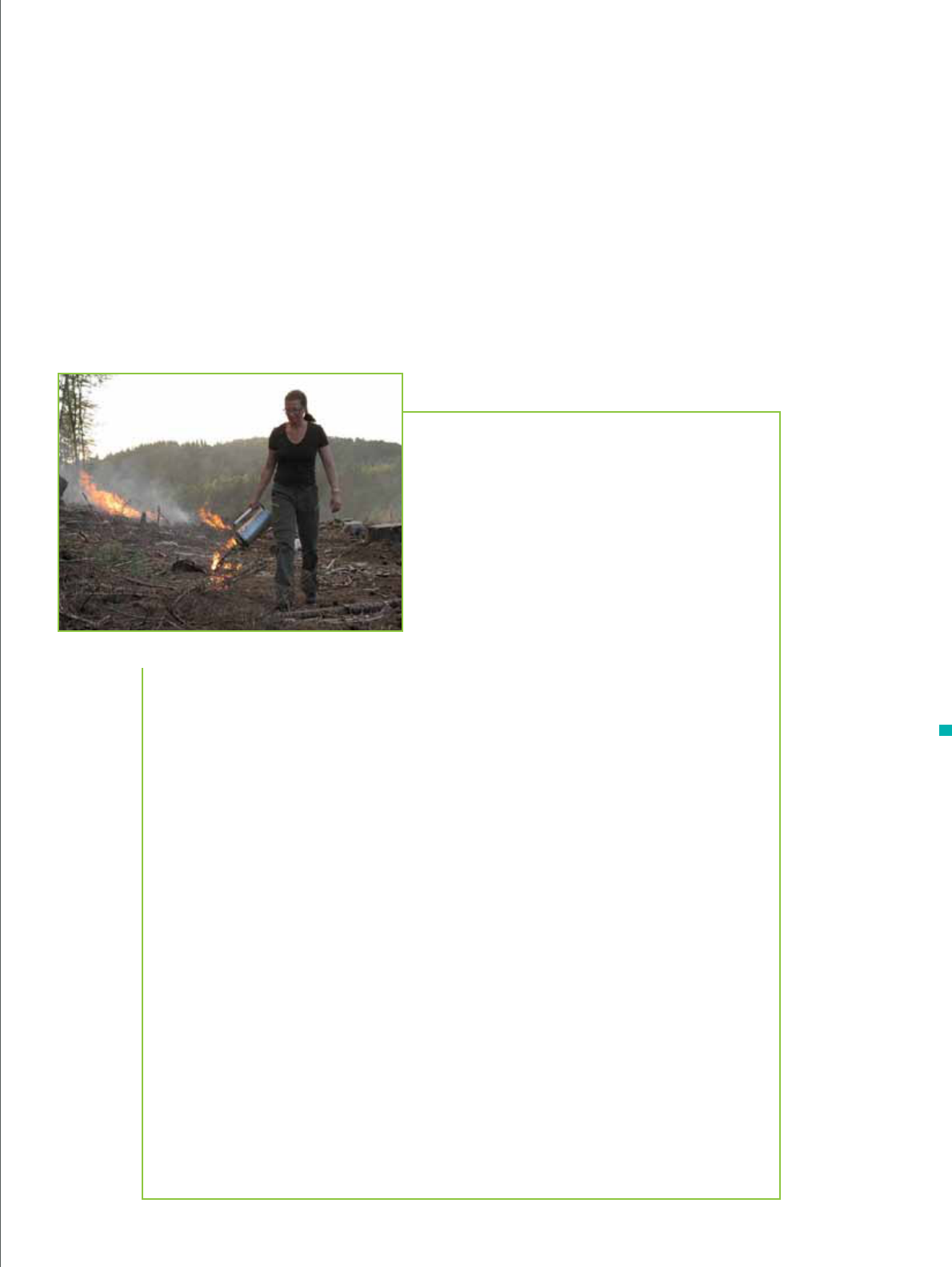
biodiversa stakeholder engagement handbook
13
new knowledge (e.g. social learning
6
; knowledge
exchange
7
), and may be empowered to become
involved in future research
15,18,19
.
Furthermore, by considering local knowledge in the
research process, it becomes possible to anticipate
and improve unexpected negative outcomes before
they occur
20-23
. Well managed engagement can also
facilitate learning and trust between participants
17,24
,
and help mediate conicts
25
.
Establishing the reason(s) for engagement is a criti-
cal rst step to take before any engagement is under-
taken. Existing literature suggests that the benets of
engagement can far outweigh the risks, including those
risks posed by lack of engagement
26
. If well planned,
and adequately resourced, successful engagement
can enrich research and deliver better knowledge, and
thus better outcomes for biodiversity and society.
0 CASE STUDY
BENEFITS OF STAKE-
HOLDER ENGAGEMENT
Experiences from the BiodivERsA FIREMAN
project (see Appendix 1) illustrate well a range
of benets that stakeholder participation can
bring. This project investigated the role of re
management in maintaining biodiversity in
dierent European ecosystems and involved a
high level of stakeholder participation to inform re-vegetation models under climate
change scenarios. The following benets were described by a researcher from FIRE-
MAN:
✴ Researchers developed a deep understanding of practical re manage-
ment issues by participating in stakeholder workshops across Europe
where they discussed re management directly with land managers from
dierent countries. This informed the development of complex ecosystem
models.
✴ Discussions with stakeholders diused conict between stakeholder groups
with diering perspectives on re management, resulting in constructive
dialogue.
✴ Sharing experiences in re management across borders: International
meetings and a conference were held which brought together stakeholders
from dierent European countries to discuss re management research.
The opportunities for managers to discuss re management with others
in contrasting ecosystems and in dierent countries were perceived
to be extremely insightful and valuable for informing their own practice.
One stakeholder reported that insights gained from their participation in
international events had been integrated into practical forestry training
programmes in Spain.
Fire management on a European heatland ecosystem, as part of the
FIREMAN project.

biodiversa stakeholder engagement handbook
14
Table 1.1
Summary of potential benets from stakeholder engagement in research on biodiversity and ecosystem services based on the four levels of engagement
presented in the Handbook (see Part 3 for a full description of the levels of engagement). Note that benets identied for lower levels of engagement are also
appropriate for all higher levels (i.e. the benets identied for the ‘inform’ level of engagement also apply to ‘consult’, ‘involve’, and ‘collaborate’).

biodiversa stakeholder engagement handbook
15
n CHALLENGES AND LIMITS TO ENGAGEMENT-
Although there is strong evidence that eective
engagement can bring many benets to the research
process, it is important to approach engagement criti-
cally, and be aware of some of the challenges and limi-
tations that may be faced. For example, engagement
increases the costs to both the research project and
the stakeholders in the short term, and might make the
undertaking of the project more complicated; whereas
the useful outcomes can be longer term or seem
intangible and remote. Some scientists may see the
involvement of stakeholders as a constraint instead of
an opportunity
27
, and some stakeholders may lack the
time to engage, or experience ‘stakeholder fatigue’,
that is they begin to feel overloaded with engage-
ment activities, which negatively aects willingness to
participate and lessens the quality of their input.
In addition, unbalanced engagement can lead to
perverse or poor decisions if it inadvertently reinforces
existing privileges, or where group dynamics discour-
age minority perspectives from being expressed
11
.
Ethical considerations include intellectual property
rights (IPR), which need to be discussed and agreed
to ensure stakeholders are clear about the implica-
tions of their involvement, especially if they are data
suppliers.

biodiversa stakeholder engagement handbook
16
n Stakeholder engagement – making it CREDIBLE, RELEVANT AND LEGITIMATE
For research to be considered valid and valuable, it has been recognised that it should be under-
taken with credibility, relevance and legitimacy (sometimes referred to as ‘CRELE’)
28,29,2,30
.
These three factors can be strengthened by appropriate engagement with stakeholders
31
.
However, the same principles can be applied to the stakeholder engagement undertaken
within that research – to give it more validity and impact it should incorporate the characteris-
tics of credibility, relevance and legitimacy.
CREDIBILITY is the perceived quality and validity of the stakeholder engagement process
and the people involved with the engagement
30
. To improve credibility, a stakeholder engage-
ment process should have clear objectives, use the most appropriate people and methods, but
avoid exclusion of those with opposing views, and be transparent; the view that others have
of the process is also important. Some continuity of those involved in stakeholder engage-
ment exercises is also considered important to ensure that knowledge and skills are built upon,
and to maintain relationships and build trust.
RELEVANCE refers to the usefulness of the engagement process and its outcomes – how closely
it relates to stakeholders and researchers needs, and how responsive the process is to chang-
ing needs
31
. Adopting understandable language for dierent stakeholder groups; ensuring the
timing of the engagement, and particularly the outcomes of the engagement, is appropriate; and
being adaptable to changing circumstances can all enhance relevance. Relevance can also be
improved through identication of key stakeholders in the planning stages of the process, and
ensuring eective engagement and communication with them throughout. Relevance is key to
motivating participation and ultimately having a real impact.
LEGITIMACY is the perceived fairness and balance of the stakeholder engagement process, and is
particularly important in cases where conict may occur. A clearly stated, appropriate and agreed stake-
holder engagement process, along with appropriate methods, can help manage conict and dissent,
and therefore enhance legitimacy
30
. In addition, stakeholders need to feel satised that their interests
have been taken into account appropriately. The inclusion of a balanced group of multiple stakehold-
ers can improve legitimacy, although care must be taken to ensure this legitimacy is not threatened if
some of the stakeholders are viewed to be inappropriate by others in the group
28
. Employing unbiased
facilitators to help run engagement activities can also help.
Getting the CRELE balance
Building these three factors into the stakeholder engagement process takes time, eort
and resources, and it may not always be possible to enhance all aspects of CRELE. For
example, making a link with policy makers may improve the relevance of the engage-
ment process and its desired outcomes for some stakeholders, but may be perceived by
others as aecting the legitimacy of the process
28
.
The most appropriate approach will be dependent on the individual project, and the desired
outcomes of the engagement. However, early engagement is likely to make the engage-
ment process more credible and relevant; and nding the right mix of participants and ensur-
ing no groups have been excluded will enhance legitimacy and credibility.

biodiversa stakeholder engagement handbook
17
There are examples of research projects in which
stakeholder engagement failed to deliver intended
outcomes, or led to unanticipated negative conse-
quences, but benets were still accrued.
In certain circumstances stakeholder engagement can
occur in a situation of conict, which must be handled
carefully and sensitively. Many scientists are unused
to working in situations where conicts between
individuals and goals are present, and may prefer to
avoid it. However, in some areas of biodiversity study,
conict is to be expected and should be planned for in
a positive, constructive way. Guidance on dealing with
conict is included in Part 7 of the Handbook.
The majority of barriers to engagement can be over-
come with eective design and good facilitation
17
.
Table 1.2 provides an overview of key challenges and
limitations associated with stakeholder engagement,
with a brief list of ways these could be avoided or
overcome.
0 CASE STUDY
BARRIERS TO SUCCESSFUL ENGAGEMENT:
SCIENCE TO POLICY
A researcher in the BiodivERsA INVALUABLE project (Integrating valuations, markets
and policies for Biodiversity and Ecosystem services; see Appendix 1) highlighted a
common issue facing collaborations between researchers and policy makers. Policy
makers tend to work on far shorter time-scales than researchers and require quick
answers from researchers as policy develops. They look for quick solutions with
a high level of certainty to aid decision-making. However, results emerging from
research can be complex, uncertain and highly dependent on context, and often
require renement through further research projects on a longer time-scale. It is
therefore important that expectations of policy makers are taken into account and
are carefully managed from the beginning of a project, through explicit discussions of
what policy makers require and expect from the engagement and research process.
Researchers can then steer the research towards outcomes more relevant to policy
where possible, or negotiate compromises with the stakeholders to ensure benets
for all parties. For example, it may be possible for the research team to provide
literature-based assessments of present-day evidence to inform policy early in the
research cycle, before empirical data has been collected. Members of the policy
community often do not have access to this literature or the skills to critically evalu-
ate it. Therefore making initial literature reviews available in this way can be a way to
provide useful outputs early, although it may be a signicant investment for research-
ers.

biodiversa stakeholder engagement handbook
18
Table 1.2
Ways of overcoming some of the challenges and limitations to stakeholder engagement
CHALLENGES AND LIMITATIONS WAYS TO AVOID OR OVERCOME
(covered in more details in dierent parts of the Handbook)
STAKEHOLDER FATIGUE
32-34
: may occur
where many stakeholder engagement initia-
tives have taken place in the past, especially
in circumstances where they did not lead to
tangible outcomes for stakeholders. This may
result in limited engagement with research.
Where possible, avoid working with communities suering
from stakeholder fatigue. Where this is not possible, ensure
there will be tangible benets for stakeholders from engaging
with your research, and work with opinion leaders (who you
may identify using stakeholder analysis) to persuade others
that it is important to engage with the project.
BIASED REPRESENTATION OF STAKE-
HOLDERS OR KEY STAKEHOLDERS MISS-
ING
35-37
: this may lead to questions being
raised over the legitimacy of outcomes by
some stakeholders.
Conduct a systematic stakeholder analysis to identify and
prioritise those who should be engaged. Consider who might
have most inuence, but do not neglect those stakeholders
with signicant interest in your research, who may be power-
less or marginalised.
POWER IMBALANCES WITHIN STAKE-
HOLDER ENGAGEMENT ACTIVITIES
16,17
:
may lead to dominance by particular individu-
als and agendas, at the expense of others,
whose ideas are not heard, making them feel
marginalised, and potentially leading to or
exacerbating conict.
Carefully design stakeholder engagement activities with a
professional facilitator, considering: parallel activities for
groups in conict or with signicant dierences in power; and
facilitation methods that enable all participants to provide
and comment on ideas (possibly anonymously). If there is no
facilitation budget, undertake basic facilitation training for a
member of the research team.
SHORT-TERM ENGAGEMENT
7
: stakeholder
engagement often lasts only for the dura-
tion of funded projects, making it dicult to
achieve impacts and deliver benets expected
by stakeholders.
Identify local organisations that might have a long-term pres-
ence in your study area and plan the legacy of your research
with them from the outset, giving them sucient ownership
of the research to continue investing in outcomes long after
the research has ended. Find ways to fund ongoing engage-
ment, even if very limited, to maintain relationships, and lay
foundations for future research that could be funded.
UNREALISTICALLY HIGH EXPECTATIONS
7,16
: engagement can sometimes create unre-
alistically high expectations among stake-
holders who engage early in the research
process, and discover their suggestions are
not compatible with the scope of the research
or are not funded.
Manage expectations carefully from the outset. If engaging
with stakeholders during project development, make it clear
if funding is uncertain; make sure you are engaging with those
who have a strong interest in your research; identify which
ideas the project team may be able to work with immediately,
and update stakeholders as soon as possible with research
plans to show which of their ideas have been integrated and
why it was not possible to integrate all ideas.

biodiversa stakeholder engagement handbook
19
n KEY POINTS TO CONSIDER FOR EFFECTIVE-
WHY?
✴ Have clear aims for stakeholder engagement in your project, and set these aims from the outset.
✴ Identify the benets for stakeholders who engage with you.
✴ Determine and understand the motivations of stakeholders to be involved in the research process.
HOW?
✴ Every engagement process is dierent and needs to be properly funded and managed by those with under-
standing (and ideally training) in stakeholder engagement.
✴ Adapt the process to suit the needs of both the researchers and stakeholders alike.
✴ Plan your engagement and make sure you engage early in the research process (as early as possible); include
scoping studies where appropriate.
✴ Think about the timing of your research and its outputs, and consider whether it can inform any relevant external
or policy processes.
WHO?
✴ Systematically identify those who are likely to hold an interest in the research, including those who have power
to inuence the uptake of the research ndings.
✴ Be inclusive – do not exclude groups that are dicult to reach and ensure balanced participation of all relevant
demographic groups.
WAYS TO SUCCESSFUL ENGAGEMENT
✴ Engage in dialogue with stakeholders as equals and value their knowledge.
✴ Give stakeholders the opportunity to help plan their own engagement.
✴ Remember that not all stakeholders will have the same role or desire to be involved; not every stakeholder needs
to be involved all of the time.
✴ Where it is considered appropriate give stakeholders power to inuence the course of the research project;
embed them where suitable in the project team (e.g. via stakeholder advisory panels).
✴ Use ‘knowledge brokers’ (who are connected to, and trusted by, dierent stakeholder groups) and experts in
stakeholder engagement (including professional facilitators or science advocates) if project teams do not have
the expertise or experience.
✴ Address ethical issues, including intellectual property rights (IPR).
✴ Manage expectations by being clear on what can or cannot change.
✴ Be prepared to be exible and adaptable, tailoring research activities and communication of ndings (e.g. policy
processes or topical issues) as required
✴ Ensure communications can be easily understood by all stakeholders – do not use complex or technical language
STAKEHOLDER ENGAGEMENT-

biodiversa stakeholder engagement handbook
20
unless this is asked for by the stakeholder.
✴ Tailor engagement to the practical and cultural needs of stakeholders, bringing the project to where they are, at
times of the day and year that are suitable for them; where deemed appropriate, consider selecting or splitting
groups according to gender or age.
✴ Do not forget to provide feedback to stakeholders as soon as possible/in a timely manner.
BEYOND THE PROJECT’S LIFE
✴ Think about the long-term impacts of the project, and the potential legacy.
✴ Assess the success of engagement throughout the research process, share good practice with peers, reect on
whether certain approaches need to be adapted, and assess the implications of any future practice.
0 CASE STUDY
ALLOW TIME FOR SCOPING AND
PILOT STUDIES
Good planning is fundamental to the success of stakeholder engagement activities
and maintaining the positive perceptions of the engagement experience for stake-
holders. Researchers of the BiodivERsA FORCE project (see Appendix 1) committed
considerable resources to scoping activities within focal Caribbean communities that
depend on the health of coral reefs for their livelihoods, before beginning stakeholder
engagement. The subsequent stakeholder activities were perceived to be successful
and this is partly attributable to the investment in the scoping work. The following
measures were taken:
Avoiding potential stakeholder fatigue: stakeholders were informed of proj-
ect aims and asked if similar research had been conducted to avoid replication.
Rening methodologies: a pilot project was run in one area to ensure
approaches and questions were well received and understood by stakeholders.
Raising awareness: community meetings were widely publicised using yers
and spreading the word verbally to ensure that the communities were well informed
of the aims of the research project.
Developing local contacts: researchers recruited local assistants who had a
good knowledge of the local communities and local issues to assist with stakeholder
engagement. Researchers who are viewed as ‘outsiders’ from another country may
be viewed with distrust; developing relationships with local contacts who are known
and trusted can be a good way of overcoming this.
Some of the details of local case studies (e.g. study sites) were jointly decided with
stakeholders to ensure the research was of interest and relevant to them.

biodiversa stakeholder engagement handbook
21
n HOW BIODIVERSA CAN HELP IN
n GENERAL INFORMATION AND ADVICE
Establishing best-practice approaches to engagement
may require consultation with others who have been
involved in similar processes. The BiodivERsA Secre-
tariat may be able to help research teams by provid-
ing information on how existing research projects have
approached stakeholder engagement, contact details
of stakeholder engagement experts from these proj-
ects, and information from other EU projects that may
be relevant (e.g. the SPIRAL project handbook and
briengs on engaging policy makers
2,38
). Key infor-
mation for applicants is posted on the BiodivERsA
website [www.biodiversa.org]. In addition, information
on professional media specialists might also be avail-
able.
n INFORMATION FROM OTHER RESEARCHERS AND PROJECTS
The BiodivERsA Database [http://www.biodiversa.
org/database] provides a comprehensive ‘map’ of
the current state of biodiversity research in Europe
in order to improve the identication of existing gaps
and future needs for new research programmes,
new facilities, as well as to detect potential barriers
for successful cooperation. It includes information
on research projects on biodiversity that are funded
through national programmes and details of research
institutes and other organisations (including stake-
holders) involved, and researchers leading the proj-
ects. The database can help research teams to iden-
tify potential resources and network opportunities to
further develop their research. In particular, it can help
applicants nding relevant stakeholders to approach
for a particular research project.
0 CASE STUDY
WHAT WILL THE OUTPUTS OF THE
STAKEHOLDER ENGAGEMENT PROCESS BE?
Deciding on the required outputs of the stakeholder process is an important part of
the planning stage and allows researchers to manage the expectations of stakehold-
ers. It may be that outputs are decided before stakeholders are involved or there
may be exibility to decide on this in partnership with stakeholders based on their
needs. In the BiodivERsA Ecocycles project, stakeholder members of the national
consultative forum were asked in the rst meeting at the beginning of the project
what they wanted to gain from their participation. They expressed a wish to work
towards a specic output that would be useful in informing the management of
rodent outbreaks in the future and it was agreed that an adaptive management proto-
col would be co-developed during the project. This clear goal maintained the interest
of stakeholders throughout the process.
STAKEHOLDER ENGAGEMENT-

biodiversa stakeholder engagement handbook
22
n REFERENCES-
1 NEßHOVER, C., TIMAEUS, J., WITTMER, H., KREIG, A., GEAMANA, N., van den HOVE, S., YOUNG, J. and WATT, A. 2013. Improv-
ing the Science-Policy Interface of Biodiversity Research Projects. GAIA, 22(2): 99–103. Available from: http://ipbes.net/images/
GAIA_2_2013_Nesshoever.pdf [Accessed 11 April 2014].
2 YOUNG, J.C., WATT, A.D. VAN DEN HOVE, S. and SPIRAL project team. 2013a. Eective Interfaces between Science, Policy and
Society: the SPIRAL Project Handbook. Available from: http://www.spiral-project.eu/sites/default/les/The-SPIRAL-handbook-
website.pdf [Accessed 11 April 2014].
3 EDIT. 2007. Stakeholder Engagement in Biodiversity and Environmental Projects – component 4.1.2BIS. Project Report, 37 pp. Avail-
able from: http://www.e-taxonomy.eu/les/StakeholderReport1.pdf [Accessed 6 June 2014].
4 POMEROY, R. and DOUVERE, F. 2008. The engagement of stakeholders in the marine spatial planning process. Marine Policy, 32,
816–22. Available from: http://www.vliz.be/imisdocs/publications/149479.pdf [Accessed 11 April 2014].
5 JOLIBERT, C. 2011. Stakeholder Engagement in EU Research: Bringing Science to Bear on Biodiversity Governance. Conference
ESEE, 18 pp. Available from: http://www.esee2011.org/registration/fullpapers/esee2011_c3e403_1_1304967722_4161_2164.pdf
[Accessed 6 June 2014].
6 SHAW, A. and KRISTJANSON, P. 2013. Catalysing Learning for Development and Climate Change. An exploration of social learn-
ing and social dierentiation in CGIAR. CCAFS Working Paper no. 43. CGIAR Research Program on Climate Change, Agriculture
and Food Security (CCAFS), Copenhagen. Available from: http://ccafs.cgiar.org/publications/catalysing-learning-development-and-
climate-change-exploration-social-learning-and#.U5G26_ldWYQ [Accessed 12 March 2014].
7 LIVING WITH ENVIRONMENTAL CHANGE (LWEC). 2012. LWEC Knowledge Exchange Guidelines. Available from: http://www.lwec.
org.uk/ke-guidelines [Accessed 29 November 2013].
8 ACCOUNTABILITY. 2008. AA1000 Stakeholder Engagement Standard 2011. 52 pp. Available from: http://www.accountability.org/
images/content/3/6/362/AA1000SES%202010%20PRINT.PDF [Accessed 5 December 2013].
9 GARDNER, J., DOWD, A.-M., MASON, C. and ASHWORTH, P. 2009. A Framework for Stakeholder Engagement on Climate Adapta-
tion. CSIRO Climate Adaptation Flagship Working Paper, No. 3, 32 pp. Available from: http://csiro.au/~/Media/CSIROau/Flagships/
Climate%20Adaptation/CAF_WorkingPaper03_pdf%20Standard.pdf [Accessed 6 December 2013].
10 ANDERBERG, S. 2010. Stakeholder Involvement and Dialogue in LUsTT. Brieng Paper, 19 pp.
11 ERBOUT, N., DE COCK, L., DE BOEVER, M. and LAUWERS, L. 2010. Best Practice for Stakeholder Involvement at National Level for
Research Prioritisation. Institute for Agricultural and Fisheries Research, ILVO, Belgium, 35 pp.
12 INTERNATIONAL FINANCE CORPORATION (IFC). 2007. Stakeholder Engagement: A Good Practice Handbook for Companies Doing
Business in Emerging Markets. IFC, Washington. 201 pp. Available from: http://www.ifc.org/wps/wcm/connect/topics_ext_content
/ifc_external_corporate_site/ifc+sustainability/publications/publications_handbook_stakeholderengagement__
wci__1319577185063 [Accessed 6 June 2014].
13 UNIVERSITY OF EDINBURGH. 2008. Stakeholder Engagement. 7 pp. Available from: http://www.docstoc.com/docs/54409298/
Stakeholder-Engagement-Guidelines-University-of-Edinburgh [Accessed 30 April 2012].
14 CARNEY, S., WHITMARSH, L., NICHOLSON-COLE, S. and SHACKLEY, S. 2009. A Dynamic Typology of Stakeholder Engagement
within Climate Change Research, Tyndall Working Paper, 128. Tyndall Centre for Climate Change Research, Norwich, 47 pp. Available
from: http://www.tyndall.ac.uk/content/dynamic-typology-stakeholder-engagement-within-climate-change-research [Accessed 5
December 2013].
15 MARTIN, A. and SHERINGTON, J, 1997. Participatory research methods: implementation, eectiveness and institutional context.
Agricultural Systems, 55, 195–216. Available from: http://www.sciencedirect.com/science/article/pii/S0308521X97000073 [Accessed
11 April 2014].
16 REED, M.S. 2008. Stakeholder Participation for Environmental Management: A Literature Review. SRI Papers, No. 8, Sustainability
Research Institute, University of Leeds, 25 pp. Available from: http://sustainable-learning.org/wp-content/uploads/2012/01/Stake-
holder-participation-for-environmental-management-a-literature-review.pdf [Accessed 9 June 2014].
17 DE VENTE, J., REED, M.S., STRINGER, L.C., VALENTE, L.C., VALENTE, S., NEWIG, J. (in press). How does the context and design
of participatory decision-making processes aect their outcomes? Evidence from sustainable land management in global drylands.
Journal of Environmental Management.
18 MACNAUGHTEN, P. and JACOBS, M. 1997. Public identication with sustainable development – investigating cultural barriers to
participation. Global Environmental Change: Human and Policy Dimensions, 7, 5–24.
19 WALLERSTEIN, N. 1999. Power between the evaluator and the community: research relationships within New Mexico’s healthier
communities. Social Science and Medicine, 49, 39–53. Available from: http://www.researchgate.net/prole/Nina_Wallerstein/publi-
cation/12884336_Power_between_evaluator_and_community_research_relationships_within_New_Mexico’s_healthier_communi-
ties/le/9c960533b581515f36.pdf [Accessed 9 June 2014].
20 FISCHER, F. 2000. Citizens, Experts and the Environment. The Politics of Local Knowledge. Duke University Press, London. Avail-
able from: http://books.google.co.uk/books/about/Citizens_Experts_and_the_Environment.html?id=rUEFMenCPH0C&redir_esc=y
[Accessed 9 June 2014].

biodiversa stakeholder engagement handbook
23
-
21 KOONTZ, T.M. and THOMAS, C.W. 2006. What do we know and need to know about the environmental outcomes of collab-
orative management? Public Administration Review, 66, 111–121. Available from: http://onlinelibrary.wiley.com/doi/10.1111/j.1540-
6210.2006.00671.x/abstract [Access 11 April 2014].
22 NEWIG, J. 2007. Does public participation in environmental decisions lead to improved environmental quality? Towards an analytical
framework. Communication, Cooperation, Participation. Research and Practice for a Sustainable Future, 1, 51–71. Available from:
http://195.37.26.249/ijsc/docs/artikel/01/03_Forschung_Newig_nal.pdf [Access 11 April 2014].
23 NEWIG, J. and FRITSCH, O. 2009. Environmental governance: participatory, multi-level – and eective? Environmental Policy and
Governance, 19, 197–214. Available from: http://econstor.eu/bitstream/10419/44744/1/604559410.pdf [Access 11 April 2014].
24 STRINGER, L.C., PRELL, C., REED, M.S., HUBACEK, K., FRASER, E.D.G. and DOUGILL, A.J. 2006. Unpacking ‘participation’ in
the adaptive management of socio-ecological systems: a critical review. Ecology and Society, 11, 39. Available from: http://www.
ecologyandsociety.org/vol11/iss2/art39/ [Accessed 9 June 2014].
25 REED, M. and SIDOLI, J. 2014. Alternative approaches to managing conservation conicts: from top-down to bottom-up. In: J.
Young and S. Redpath (Eds). Conicts in Conservation: Strategies for Coping with a Changing World, Cambridge University Press,
Cambridge.
26 AUSTRALIAN GOVERNMENT (DEPARTMENT OF IMMIGRATION AND CITIZENSHIP). 2008. Stakeholder Engagement: Practitio-
ner Handbook. National Communications Branch of the Department of Immigration and Citizenship, Belconnen, Australia, 37 pp.
Available from: http://www.immi.gov.au/about/stakeholder-engagement/_pdf/stakeholder-engagement-practitioner-handbook.pdf
[Accessed 5 December 2013].
27 MORGAN, V.M., MOORE, E.A., DURHAM, E.L. and BAKER, H. 2012. BiodivERsA task 2.1. Analysis of Stakeholder Engagement
Approaches: Towards Best Practice Guidelines. Unpublished BiodivERsA report. Available from: http://jncc.defra.gov.uk/pdf/
WP2%20milestone%207%20report%20with%20coversheet.pdf [Access 11 April 2014].
28 CASH, D., CLARK, W., ALCOCK, F., DICKSON, N., ECKLEY, N. and JAGER, J. 2002. Salience, Credibility, Legitimacy and Boundaries:
Linking Research, Assessment and Decision Making. Available from: http://papers.ssrn.com/sol3/papers.cfm?abstract_id=372280
[Accessed 9 June 2014].
29 CASH, D.W., CLARK, W.C., ALCOCK, F., DICKSON, N.M., ECKLEY, N., GUSTON D.H., JAGER, J. and MITCHELL, R. 2003. Knowl-
edge systems for sustainable development. PNAS, 100 (14): 8086-8091. Available from: http://www.pnas.org/content/100/14/8086.
full.pdf [Accessed 9 June 2014].
30 YOUNG, J.C., WATT, A.D. van den HOVE, S. and the SPIRAL project team. 2013b. The SPIRAL synthesis report: A resource book on
science-policy interfaces. Available from: http://www.spiral-project.eu/content/documents [Accessed 11 April 2014].
31 UNEP and IOC-UNESCO. 2009. An Assessment of Assessments, Findings of the Group of Experts. Start-up Phase of a Regular
Process for Global Reporting and Assessment of the State of the Marine Environment Including Socio-economic Aspects. Available
at: http://www.un.org/Depts/los/global_reporting/regular_process_background.pdf [Accessed 9 June 2014].
32 HANDLEY, J.F., GRIFFITHS, E.J., HILL, S.L. and HOWE, J.M. 1998. Land restoration using an ecologically informed and participative
approach. In: H.R. Fox, H.M. Moore and A.D. McIntosh (Eds), Land Reclamation: Achieving Sustainable Benets. Balkema, Rotter-
dam.
33 WONDOLLECK, J. and YAFFEE, S.L. 2000. Making Collaboration Work: Lessons from Innovation in Natural Resource Management.
Island Press, Washington DC.
34 BURTON, P., GOODLAD, R., CROFT, J., ABBOTT, J., HASTINGS, A., MACDONALD, G. and SLATER, T. 2004. What Works
in Community Involvement in Area-Based Initiatives? A Systematic Review of the Literature. Home Oce Online Report 53/04.
Research Development and Statistics Directorate, Home Oce, London. Available from: http://webarchive.nationalarchives.gov.
uk/20110218135832/http:/rds.homeoce.gov.uk/rds/pdfs04/rdsolr5304.pdf [Accessed 24 March 2014].
35 GRIMBLE, R. and CHAN, M.-K. 1995. Stakeholder analysis for natural resource management in developing countries. Natural
Resources Forum, 19(2), 113–114.
36 PRELL, C., HUBACEK, K. and REED, M., 2009. Stakeholder analysis and social network analy-
sis in natural resource management. Society and Natural Resources, 22, 501–518. Available from:
http://sustainable-learning.org/wp-content/uploads/2012/01/Stakeholder-Analysis-and-Social-Network-Analysis-in-Natural-
Resource-Management.pdf [Accessed 11 April 2014].
37 REED, M.S., GRAVES, A., DANDY, N., POSTHUMUS, H., HUBACEK, K., MORRIS, J., PRELL, C., QUINN, C.H. and STRINGER, L.C.
2009. Who’s in and why? A typology of stakeholder analysis methods for natural resource management. Journal of Environmental
Management, 90, 1933–1949. Available from: http://sustainable-learning.org/wp-content/uploads/2012/01/Who%E2%80%99s-in-
and-why-A-typology-of-stakeholder-analysis-methods-for-natural-resource-management.pdf [Accessed 9 June 2014].
38 SARKKI, S., NIEMELÄ J. and TINCH, R. 2012. Summary Report on Assessment Criteria for Science-Policy Interfaces. SPIRAL inter-
facing biodiversity and policy. Unpublished report, SPIRAL, April 2012.

biodiversa stakeholder engagement handbook
24
› Scope and context
›› Case studies
Identifying reasons to engage stakeholders
Reasons to engage stakeholders: European Beech
Forest for the Future (BeFoFu)
Why engage with
stakeholders
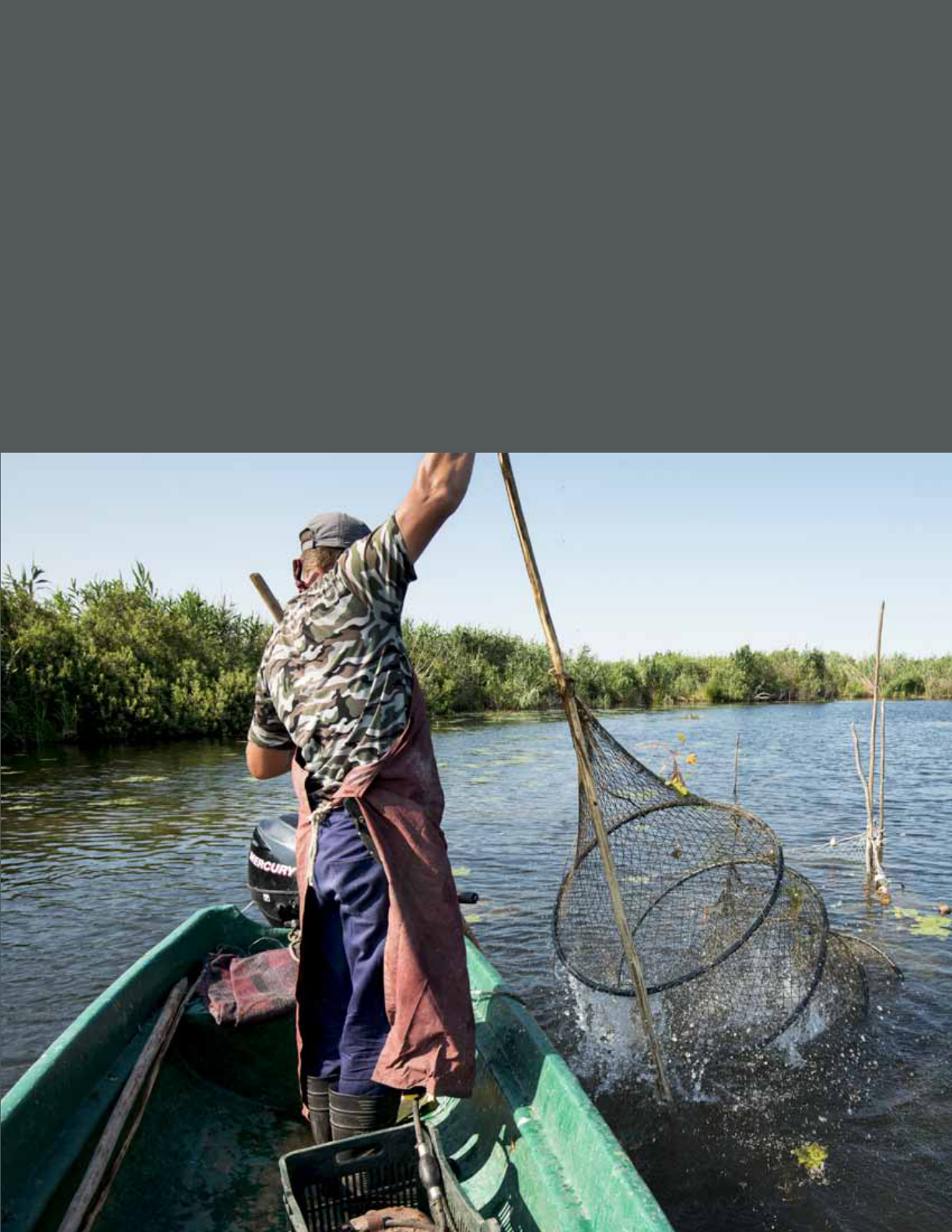
biodiversa stakeholder engagement handbook
25
Part 2

biodiversa stakeholder engagement handbook
26
n WHY ENGAGE WITH STAKEHOLDERS-
❝ Dene why you wish to undertake stakeholder engagement
and what outcomes you wish to achieve. Begin outlining the
scope of the engagement and its context at the outset of the
project and continuously develop it. ❞
The rst, and perhaps the most critical, step in the
stakeholder engagement process is to identify why the
engagement activity is necessary, what outcomes are
aimed for, and the scope and context of the engage-
ment
1
. No stakeholder engagement strategy can be
devised without considering the reasons for engage-
ment, and what is being sought from the process
1-8
.
This initial step is dened as the ‘preliminary’ or ‘scop-
ing’ phase because the scope and extent of engage-
ment is dened at this point
4,9
.
Depending on the level of engagement sought, there
may be more, or less, engagement with stakehold-
ers to identify the scope and context of engagement.
In projects that are mainly operating in ‘inform’ and
‘consult’ modes (Table 1.1), this information may be
made available to potential stakeholders, in an appro-
priate format. The information provided needs to be
clear about the aims of engagement and how it will
help the project meet the needs of stakeholders, so
they can make an informed choice about whether or
not they want to become involved with the research.
For projects engaging predominantly in the ‘involve’
and ‘collaborate’ modes, it is important to engage
stakeholders in this initial scoping phase of the work.
Engaging stakeholders as early as possible in the
research programme can increase the likelihood that
research meets the needs and priorities of stakehold-
ers, who are in consequence more likely to feel owner-
ship of research outcomes
10,11
. Potentially, researchers
may need to negotiate the goals of the research with
stakeholders, perhaps identifying new stakeholders if
goals change. The negotiating may be done as part
of a stakeholder analysis; for example Dougill et al.
12
and Prell et al.
13
used an initial stakeholder analysis
to identify key informants for scoping interviews in
which they discussed and expanded the scope of the
research, before revisiting their stakeholder analysis to
include those with a stake in the revised scope of the
research.
It is essential to have a denite purpose for stake-
holder engagement that should be used to drive the
desired activities, outcomes and outputs. Outputs
are the tangible products needed to achieve desired
outcomes, such as reports, websites, newsletters,
or data. For example, if the reasons for engaging
stakeholders are primarily about pragmatic issues
(concerned with facts or actual occurrences rather
than testing scientic theories), there is likely to be
a stronger focus on outcomes of the process (e.g.
increased abundance of a particular species). On
the other hand, if the purpose is primarily normative
(seeking to establish a norm, setting a standard/den-
ing methods of good practice), then there may be a
stronger focus on the benets of the process itself
(e.g. increased learning and trust, and reduced levels
of conict).
A well-crafted purpose for engagement will be
focused, clearly dened, easily understood, with clear
aims and objectives
4,9
. Some reasons for undertaking
stakeholder engagement, and desired outcomes, are
provided in Table 2.1
4,7,9,14,15
:

biodiversa stakeholder engagement handbook
27
Table 2.1
Reasons for stakeholder engagement
✴ Raise awareness of the research project.
✴ Gain trust and improve working relationships, form new partnerships, create new networks,
galvanize external support, and provide a clearer understanding of the benets of the research.
✴ Encourage a sense of ‘ownership’ of the project by those likely to benet, be aected by, or inter-
ested in, research outcomes.
✴ Provide people with an opportunity for personal development through engagement activities.
✴ Explore issues, share ideas and best practice, generate ideas and identify and raise better aware-
ness of emerging issues.
✴ Co-design projects with stakeholders that may assist with producing a clearer denition of desired
outcomes. Taking a broad spectrum of ideas and thoughts on board enables the adoption of a
more holistic approach to addressing potential problems, limitations or conicts.
✴ Aid the development of a transparent decision-making process and ensure policy decisions can
be based upon stakeholder views and enable decision-makers to consider societal ‘wants’ and
‘needs’. This can help reduce conict and overcome barriers between science, policy makers
and society.
✴ Involve stakeholders to make it easier to obtain endorsement of, or agreement on, resulting deci-
sions from parties likely to either use or be aected by the results of the research.
✴ Gain access to resources or to obtain information data.
✴ Create new (or improved) communication channels, identify eective dissemination avenues and
improve clarication of ‘common’ language.
✴ Provide equal rights and open access to scientic knowledge (‘democratizing science’).
✴ Enable researchers to identify cross-cutting issues and ascertain where research may be applied
to other areas. It also improves the relevance, value and depth of the research and broadens the
knowledge base, identies knowledge gaps, addresses information needs and creates opportu-
nities to link research more directly to policy and practice.
✴ Leads to improved risk management.
Identifying and clarifying desired outcomes is an
important part of the planning process and helps to
ensure that the focus on achieving aims as the proj-
ect progresses is maintained
4
. In the early stages of
a project, it is benecial to consider the reasons for
conducting engagement activities and the desired
outcomes, aims and outputs. This information can
also be of use in the nal ‘review’ phase of the proj-
ect when it will be necessary to assess whether the
desired outcomes have been achieved. The success
criteria of the project can be dened from the original
objectives dened during initial scoping activities.

biodiversa stakeholder engagement handbook
28
n SCOPE AND CONTEXT-
In addition to establishing the purpose of the engage-
ment, and its desired outcomes, it is also important to
determine the scope and extent of the engagement
and its context. The ‘scope’ of stakeholder engage-
ment determines where the boundaries of engagement
lie and assist in dening achievable outcomes from
engagement activities. The scope considers what the
objectives can realistically achieve, what impact it may
have, and whether it will contribute anything to the
project aims. If the proposed engagement presents
no benet to the project then stakeholder engage-
ment is likely not appropriate or necessary
16
. Scoping
exercises help identify stakeholders who might wish
to become involved and ascertain whether adequate
resources are available to carry out engagement
4
. The
costs, both in terms of time and resources, of stake-
holder engagement to both the project and the stake-
holder should not be underestimated at the scoping
stage
2,5
. Furthermore, risks associated with undertak-
ing engagement need to be assessed and taken into
consideration to ensure that they are managed eec-
tively.
The extent of the engagement may, to some degree,
be driven by resource and time availability. Consider-
ing the potential cost and time requirement of engag-
ing early on in project lifecycle will ensure sucient
funds can be made available to enable engagement
activities to be comprehensive, t-for-purpose, and
benecial to all parties involved.
The scoping phase needs to consider the context
of the engagement - the background to the subject
being addressed by the engagement process. Every
research project is unique and is shaped by the issues
under consideration, the people involved, the pre-
history of the work, and relevant wider decision-making
processes, amongst other factors. These issues may
aect what can, and cannot, be done within the
engagement process and are likely to dictate which
activities it will be appropriate to adopt. Understanding
the context also helps to ensure that the engagement
process builds upon previous experience and incor-
porates lessons learnt, rather than simply duplicating
previous eorts. Dening context also makes certain
that the engagement is of relevance to the potential
stakeholders
5
.
Important points to consider when dening the scope of stakeholder engagement activities:
What can the engagement realistically achieve in the time available? What are the limitations and
how can these be clearly set?
How are stakeholders to be involved - are they to be kept informed throughout the project lifecycle
(see Figure 4.1), asked for their opinions, or involved fully in the decision making process? What
impact will this have on the scope of planned activities?
What types of information will need to be gathered (quantitative versus qualitative) and how will this
be collected and over what timescale?
What additional resources might be required to facilitate eective engagement (sta training, exter-
nal contractors, and trans-disciplinary collaboration)? What will be the cost of engaging (both nan-
cial and other resources [e.g. sta time, cost of external contractors, and cost of training for sta])?
What are the potential risks associated with stakeholder engagement activities at a particular scale?
How are these best addressed?
How are the outcomes of the engagement going to be implemented? How and when will the
outcomes be communicated back to the stakeholders?
How will the success of the engagement be measured?

biodiversa stakeholder engagement handbook
29
Important points when considering the background and context for engagement
activities:
What similar projects have been undertaken previously?
How successful were the projects and what were the key elements in achieving or failing
the objectives?
What stakeholders, or stakeholder groups, have been engaged in the past?
What is the historical context to the project?
What wider decision-making processes that may aect the project need to be considered?
Do existing networks exist, and, if so, how can these be utilised?
What is the relationship status with stakeholders or potential stakeholders?
Are there any relevant activities, events or communication channels that could be used to
engage with stakeholders?
0 CASE STUDIES
IDENTIFYING REASONS TO ENGAGE STAKE-
HOLDERS
The objectives of stakeholder engagement for a number of the case study projects
(see Appendix 1 for details) is briey summarised below in relation to the level of
engagement sought by the researchers:
✴ Inform and consult: One of the objectives of the BiodivERsA INVALUABLE project
was to inform policy makers about the use of market based instruments (MBIs) for
the management of biodiversity and ecosystem services. Researchers engaged
with stakeholders to produce policy-relevant documents to advise how MBIs
could be better used to meet biodiversity conservation objectives.
✴ Involve: The FP7 MOTIVE project researchers involved stakeholders in a variety
of ways to integrate experience and knowledge from forestry management into
adaptive models to analyse the impacts of climate- and land-use-change on Euro-
pean forests. The FP7 FORCE project worked with communities in four Caribbean
countries to gather data on the factors inuencing the health of coral reefs and their
relationship with community livelihoods to inform management of reefs and more-
sustainable resource use. Findings were widely disseminated to communities and
national stakeholders. In the FP5 BIOSCENE project, stakeholders with diering
perspectives were involved with the development of a sustainability appraisal of
scenarios for agriculture in mountain regions of Europe. Stakeholders were also
involved in the development of scenarios to inform the design of re management
models in the BiodivERsA FIREMAN project. Participation was encouraged though
international meetings and practical demonstration events. In the FP7 BESAFE
project, researchers are working with stakeholders in biodiversity conservation
to gather information on the eectiveness of arguments used for advocating the
protection of biodiversity at dierent scales of governance and in dierent contexts
through case study projects. Early ndings have been widely disseminated via
policy briefs and a stakeholder panel has agreed to co-development of a web tool
that will make ndings accessible and relevant to policy makers and stakeholders
lobbying for biodiversity protection. The framework for the BESAFE

project shown in Figure 1 shows how central stakeholders are in achieving the proj-
ect goals.
✴ Collaborate: The FP7 HighARCS project worked with local communities and key
stakeholders to produce integrated action plans to address conservation, liveli-
hood and policy concerns in Asian communities by focusing on the conservation
and sustainable development of highland aquatic resources. In the BiodivERsA
CONNECT project, researchers collaborated with a government agency in the
Netherlands to develop research questions and a protocol to produce ndings that
directly informed policy processes about land use and natural-resource protection
in and around a freshwater lake. The BiodivERsA ECOCYCLES project collabo-
rated with stakeholders to develop rational approaches to addressing a conict
over the management of rodent outbreaks on agricultural land. This also high-
lighted research needs to develop evidence-based options, which led to further
collaborative work after the project was completed. The FP7 HUNT project inves-
tigated the ecological, social, economic and cultural aspects of hunting to under-
stand the role of this activity in the sustainable management of biodiversity, and
put in place National Consultative fora in each partner country whose remit was to
inform the direction of the research programme and to ensure the relevance of the
ndings for policy and practice.
biodiversa stakeholder engagement handbook
30
Figure 1. The BESAFE project framework
(source: Bugter, R. BESAFE project: http://www.besafe-project.net)
ARGUMENTS
• Components
• Structure
• For who?
• By whom?
• To what end?
• What action
ARGUMENTS
• Components
• Structure
• For who?
• By whom?
• To what end?
• What action
BIODIVERSITY
Which type & level?
BIODIVERSITY
Which type & level?
GOALGOAL
EFFECTIVENESS
• Recording
• Measuring
EFFECTIVENESS
• Recording
• Measuring
VALUES
From what value
system?
VALUES
From what value
system?
CONTEXT
•
Policy-mix
• Stage in cycle
• Governance
• Geography
• Economic
situation
CONTEXT
•
Policy-mix
• Stage in cycle
• Governance
• Geography
• Economic
situation

biodiversa stakeholder engagement handbook
31
0 CASE STUDY
REASONS TO ENGAGE STAKEHOLDERS: EUROPEAN BEECH
FORESTS FOR THE FUTURE (BEFOFU)
The BiodivERsA BeFoFu project evaluates the ecological and institutional background
for Beech forest conservation and management in Europe, taking into account the
additional challenges arising from global change. Besides various national and sub-
national activities at the European level, Beech forest conservation is predominantly
addressed by the EU Natura 2000 network of protected areas. Across the EU, the
implementation process of Natura 2000 has been impaired by conicts and diverg-
ing stakeholder interests regarding forest management. The nancing of Natura 2000
protected areas, particularly on privately owned land, remains a crucial issue.
WHY WAS STAKEHOLDER ENGAGEMENT IMPORTANT?
BeFoFu deals with a politically relevant and controversial topic – the implementation of
Natura 2000 in Beech forests. The results of the research undertaken are of high interest
for policy stakeholders. In the political science context, BeFoFu depends on the willing-
ness of stakeholders to share their knowledge with researchers. There is a mutual interest
from stakeholders and policy makers to engage in a dialogue process to ensure divergent
interests are taken into account when implementing policy and forest management to
ensure Beech forests are eectively conserved at the local level
PERCEIVED BENEFITS OF STAKEHOLDER ENGAGEMENT TO THE
RESEARCH
The major benets of the stakeholder engagement are:
✴ It provides a very good overview about the current ‘political environment’ the project is
embedded in and how it can contribute to better knowledge that can be used to inform
scientic research, policy decisions, account for local stakeholder interests and realise
wider social benets from European Beech forests.
✴ It oers an update about on-going policy processes related to Natura 2000 and forests.
✴ It identies possible avenues for communicating project results.
WHAT HAS BEEN OR WILL BE THE IMPACT OF THE RESEARCH?
The long-term impact and legacy will be:
✴ A better understanding the likely eect of dierent (local) policies and management
strategies on Beech forest biodiversity.
✴ Revealing the likely impacts of climate change.
✴ Greater knowledge on the eects of EU biodiversity policy at dierent levels.
✴ Contributing results to the discussion on the development of EU biodiversity policy
beyond 2010.

biodiversa stakeholder engagement handbook
32
n REFERENCES-
1 ACCOUNTABILITY. 2011. AA1000 Stakeholder Engagement Standard 2011. 52 pp. Available from: http://www.accountability.org/
standards/aa1000ses/index.html [Accessed 9 June 2014].
2 ACCOUNTABILITY, UNITED NATIONS ENVIRONMENT PROGRAMME, and STAKEHOLDER RESEARCH ASSO-
CIATES. 2005. The Stakeholder Engagement Manual: Volume 2: The Practitioner’s Handbook on Stakeholder
Engagement. Beacon Press, Boston, 156 pp. Available from:
http://www.accountability.org/images/content/2/0/208.pdf [Accessed 11 April 2014].
3 EDIT. 2007. Stakeholder Engagement in Biodiversity and Environmental Projects – component 4.1.2BIS. Project Report, 37 pp. Avail-
able from: http://www.e-taxonomy.eu/les/StakeholderReport1.pdf [Accessed 24 April 2014].
4 REVIT. 2007. Working Towards more Eective and Sustainable Browneld Revitalisation Policies: Stakeholder Engagement – A Tool-
kit. Torfaen County Borough Council, Torfaen, 38 pp. Available from: http://www.revit-nweurope.org/selfguidingtrail/27_Stakeholder_
engagement_a_toolkit-2.pdf [Accessed 11 April 2014].
5 GARDNER, J., DOWD, A.-M., MASON, C. and ASHWORTH, P. 2009. A Framework for Stakeholder Engage-
ment on Climate Adaptation. CSIRO Climate Adaptation Flagship Working Paper, No. 3, 32 pp. Available from:
http://www.csiro.au/Organisation-Structure/Flagships/Climate-Adaptation-Flagship/CAF-working-papers/CAF-working-paper-3.
aspx [Accessed 24 April 2014].
6 JEFFREY, N. 2009. Stakeholder Engagement: A roadmap to meaningful engagement. Dougherty Centre, Craneld School of
Management, Craneld, 48 pp. Available from: http://www.som.craneld.ac.uk/som/dinamic-content/media/CR%20Stakeholder.
pdf [Accessed 11 April 2014].
7 ANDERBERG, S. 2010. Stakeholder Involvement and Dialogue in LUsTT. Brieng Paper, 19 pp.
8 MORRIS, J. and BADDACHE, F. 2012. Back to Basics: How to make stakeholder engagement meaningful to your company. BSR
Europe, 19 pp. Available from: http://www.bsr.org/reports/BSR_Five-Step_Guide_to_Stakeholder_Engagement.pdf [Accessed 9
June 2014].
9 INVOLVE. 2005. People and Participation: How to Put Citizens at the Heart of Decision-making. 61 pp. Available from: http://www.
involve.org.uk/wp-content/uploads/2011/03/People-and-Participation.pdf [Accessed 9 June 2014].
10 CHESS, C., PURCELL, K. 1999. Public participation and the environment – do we know what works? Environmental Science and
Technology, 33, 2685–2692. Available from: http://pubs.acs.org/doi/pdf/10.1021/es980500g [Accessed 11 April 2014].
11 REED, M.S. 2008. Stakeholder Participation for Environmental Management: A Literature Review.
SRI Papers, No. 8, Sustainability Research Institute, University of Leeds, 25 pp. Available from:
http://sustainable-learning.org/wp-content/uploads/2012/01/Stakeholder-participation-for-environmental-management-a-literature-
review.pdf [Accessed 23 April 2014].
12 DOUGILL, A.J., FRASER, E.D.G., HOLDEN, J., HUBACEK, K., PRELL, C., REED, M.S., STAGL, S. and STRINGER, L.C. 2006. Learn-
ing from doing participatory rural research: lessons from the Peak District National Park. Journal of Agricultural Economics, 57,
259–275. Available from: http://onlinelibrary.wiley.com/doi/10.1111/j.1477-9552.2006.00051.x/abstract [Accessed 9 June 2014].
13 PRELL, C., HUBACEK, K. and REED, M., 2009. Stakeholder analysis and social network analysis in natural resource management.
Society and Natural Resources, 22, 501-518. Available from: http://sustainable-learning.org/wp-content/uploads/2012/01/Stake-
holder-Analysis-and-Social-Network-Analysis-in-Natural-Resource-Management.pdf [Accessed 23 April 2014].
14 TOMPKINS, E.l., FEW, R. and BROWN, K. 2008. Scenario-based stakeholder engagement: Incorporating stakeholders’ preferences
into coastal planning for climate change. Journal of Environmental Management, 88, 1580–92.
15 DEPARTMENT OF EDUCATION AND EARLY CHILDHOOD DEVELOPMENT. 2011. Stakeholder Engagement Framework. Melbourne,
Australia: Department of Education and Early Childhood Development. 44 pp. Available from: http://www.eduweb.vic.gov.au/eduli-
brary/public/commrel/policy/oct2011stakeholderengagement.pdf [Accessed 1 September 2012].
16 FISH, R., BURGESS, J., CHILVERS, J., FOOTITT, A., HAINES-YOUNG, R., RUSSEL, D. and WINTER, D.M. 2011. Participatory
and deliberative techniques to embed an ecosystems approach into decision making: An introductory guide. Defra Project Code:
NR0124, Defra, 107 pp. Available from: http://randd.defra.gov.uk/Document.aspx?Document=NR0124_10262_FRP.pdf [Accessed
11 June 2014].

biodiversa stakeholder engagement handbook
33

biodiversa stakeholder engagement handbook
34
› Stage 1
› Stage 2
› Stage 3
› Summary of the three stages of stakeholder identication
›› Case studies
Identifying stakeholders
Assess and prioritise stakeholders
Identifying stakeholders - Problems that may be encountered
Ecosystem service provision from coupled plant and microbial functional
diversity in managed grasslands
How to identify
stakeholders
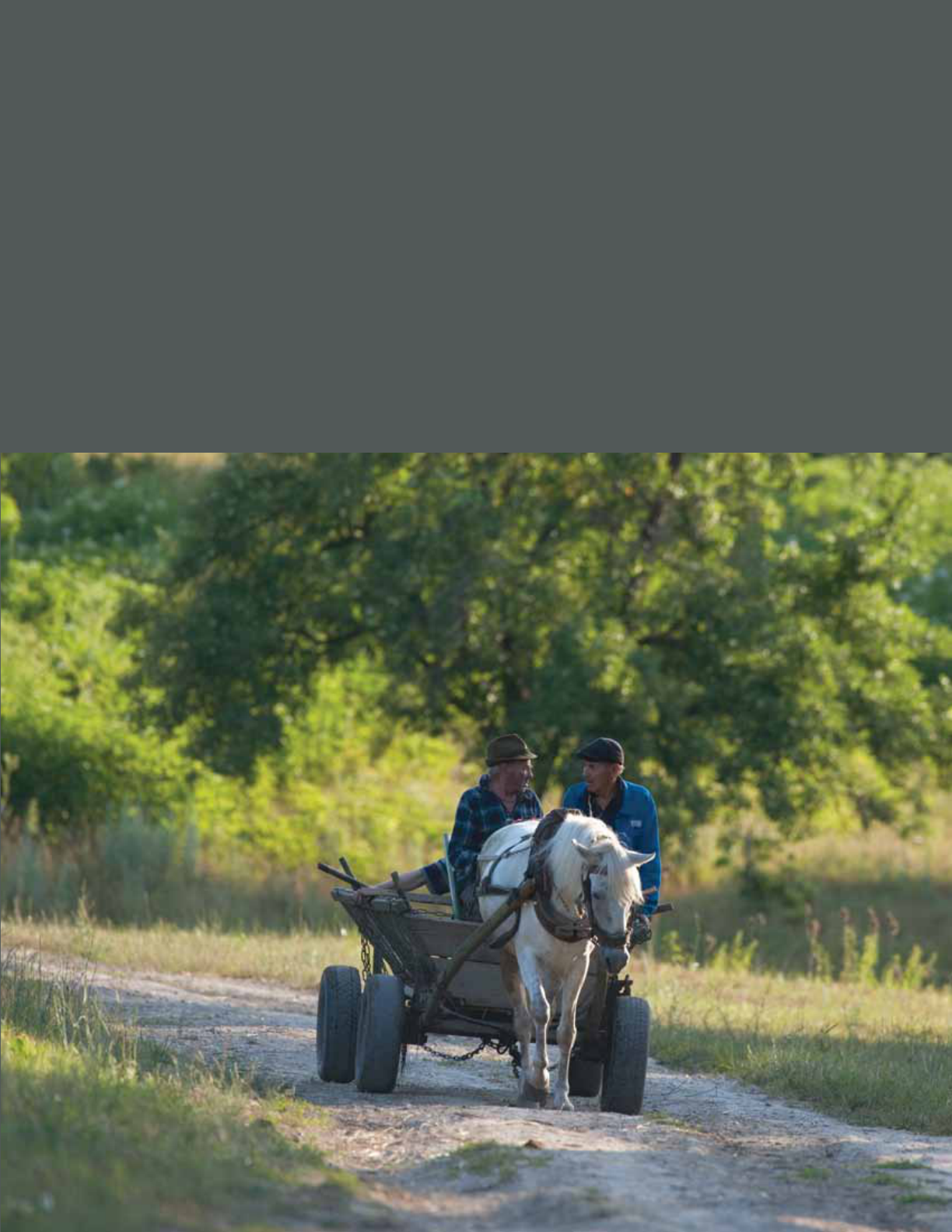
biodiversa stakeholder engagement handbook
35
Part 3

biodiversa stakeholder engagement handbook
36
n HOW TO IDENTIFY STAKEHOLDERS-
❝
Identify,
categorise
and understand
relevant stakeholders ❞
Having established clear reasons for engagement, the
next step in the stakeholder engagement process is
to identify which stakeholders need to be engaged.
Selection will depend upon the focus of research, its
potential outcomes and impacts, available resources,
the objectives of the engagement, as well as the will-
ingness or ability of the stakeholders to engage
1
.
Evidence suggests that participant selection strongly
determines the outcomes of an engagement
process
2-5
. Therefore, it is important to ensure eec-
tive representation of relevant stakeholders, includ-
ing those with high levels of interest in the research
who may have low levels of inuence, in addition to
strategic stakeholders with power, motivation and
means to implement research outcomes
3
. There is
evidence that demonstrates that eective representa-
tion can increase levels of learning and trust between
participants and that unrepresentative or restrictive
participant selection may lead to fewer positive social
outcomes, and may even lead to increased conict
5
.
Stakeholder identication can be considered to have
three stages
3
:
Stage 1: Identify all potential stakeholders and
stakeholder groups.
Stage 2: Assess and prioritise the stakeholders.
Stage 3: Develop an understanding of your stake-
holders.
The outcomes from this three stage process can then
be considered by the project team in order to ascertain
what level of engagement is required, the timing and
role of the engagement, and ultimately which methods
of engagement are to be adopted.
n STAGE 1: WHO ARE YOUR STAKEHOLDERS?-
In order to identify stakeholders it is necessary to
consider all people, or groups, that are aected by, who
can inuence, or may have an interest in the research
6
.
In this rst stage it is important to be inclusive, identify
all stakeholders, and consider not only what they may
be able to contribute to the project but also what will
motivate them to become involved (i.e. what they can
gain from engaging). In some cases, very few or even
no stakeholders may be identied
6
. Stakeholder iden-
tication may be done by the research team alone, or
in collaboration with other colleagues, organisations
and cross-sectoral stakeholders, to ensure key groups
are not missed. Participation of stakeholders in the
identication process itself can help dene and rene
the scope of the issues being considered, and provide
more-comprehensive information about who might
have a stake in those issues
3
.
The stakeholder identication process should be reas-
sessed regularly throughout the project to ensure that
no groups or individuals have been missed. This may

biodiversa stakeholder engagement handbook
37
involve identifying new stakeholders that need to be
engaged as the research progresses or as stakeholder
needs and priorities change over the course of the
research
7
. In the early stages of the project it could be
benecial to enter into dialogue with scientists work-
ing in other disciplines and/or groups or individuals
who are likely to oppose the research, as this may
help identify potential conicts that could arise. It is
important to ensure that groups or individuals that are
considered to be potential sources of conict are not
left out of the engagement process simply because
they have opposing views.
It is useful to identify stakeholders in a systematic
fashion, as far as possible, by considering all aspects
of the project’s area of inuence throughout the entire
cycle. Broadly speaking there are two approaches to
systematically identifying stakeholders: ‘ex-ante’ and
‘ad-hoc’. Using both approaches, the initial identi-
cation of stakeholders is often done using secondary
data sources (e.g. census data, providing informa-
tion that could help categorise stakeholders by age,
gender, religion or place of residence). Secondary data
may be used to select participants to start mapping
stakeholders more systematically
8-10
. Following the
ad-hoc approach, the identication of stakeholders is
typically an iterative process, eliciting feedback from
new stakeholders as they are identied, who in turn
identify other new stakeholders. Researchers may
follow a ‘snowball sampling’ approach until no new
stakeholders are identied
3,10,11
.
Alternatively, following the ex-ante approach, stake-
holders are identied in advance, in relation to likely
stakeholder categories
7,8,12
. For example, it may be
helpful to consider particular sectors or groups of
relevance (e.g. public sector, private sector, voluntary
groups, academics, researchers) or consider specic
roles or functions of dierent actors (e.g. data users,
funders, policy makers, local communities)
13,14
. It may
be useful to categorise stakeholders like this from
the outset if there is a need for stratifying a sample
of stakeholders for conducting questionnaires or inter-
views later in the project. The categorisation can also
be used as a checklist to help ensure that represen-
tatives are present from each main group at events
associated with the research. This can be particularly
useful if there are very limited resources for engaging
with stakeholders, as only a small number of repre-
sentatives of each stakeholder group may need to be
invited to events. The process of identifying stake-
holders may end here, or teams may wish to verify
their categories with stakeholders (e.g. with one key
stakeholder per category) to check for missing stake-
holders and further rene their categorisation
9
.
Example categories include
7,12
:
✴ Government departments, politicians, policy
makers and advisers (local, national, international);
other national or international policy makers or
policy groups (e.g. European institutions, environ-
ment agencies)
✴ Non-governmental organisations (NGOs)
✴ Business and industry
✴ Local communities
✴ Landowners and managers
✴ Professional groups (e.g. vets, surveyors etc.)
✴ Scientists and researchers working in relevant
disciplines; Scientists and researchers working
across dierent disciplines
✴ Educators
✴ Students
✴ The media
✴ The general public
Other useful methods for identifying key stake-
holder could include
15
:
✴ Brainstorming with other organisations that have
been involved in similar activities or those working
in similar locations
✴ Consulting with colleagues to share knowledge
about who may have an interest in the research
✴ Developing a ‘mind map’ that can be used to iden-
tify suitable stakeholders; assessing secondary
data (e.g. historical records, media articles)

biodiversa stakeholder engagement handbook
38
✴ Utilising government statistics and data (e.g.
census information)
✴ Initiating self-selection by promoting the engage-
ment process and encouraging individuals with an
interest to come forward
✴ Using ‘snowball sampling’ techniques, whereby
one stakeholder identies further stakeholders
until no additional new stakeholders are identied
✴ Utilising existing lists of organisations in order to
identify specic groups, networks and agencies
who represent relevant elements of society
✴ Consulting with forums used by government and
other organisation (e.g. local authorities, town
councils, emergency services etc.).
0 CASE STUDIES
IDENTIFYING STAKEHOLDERS
Pre-existing networks are hugely valuable for beginning the process of stakeholder
identication for a project and these were an important starting point for all the case
study projects (see Appendix 1 for details). If researchers are known and trusted
within their eld, stakeholders will view more favourably the opportunity to engage
in a research project. The FP7 BESAFE project began by asking stakeholders who
participated in a previous research project whether they would be interested in
participating in BESAFE. Later on in the project, stakeholders were asked to suggest
other suitable participants. The BiodivERsA INVALUABLE project also used former
stakeholder partners as a platform to identify new stakeholders using a ‘snowball’
approach where individuals are identied by current contacts, who then identify
further contacts until a sucient group is selected or no further people are identied.
For example, INVALUABLE researchers sought stakeholders from the French agency
for Development (AFD) and the French ministry for Foreign aairs, and did so by
consulting colleagues and stakeholder contacts from previous projects or meetings
who were able to trace the most suitable individuals, and make introductions where
necessary.
The FP7 FORCE project included an in-depth study of livelihood and community
dependence on coral reefs in multiple communities across four Caribbean countries.
Prior to commencing eldwork, a scoping phase was undertaken to identify commu-
nity boundaries and key stakeholders. Information was collected from stakeholders
to determine the boundaries of the communities, and thus the area included for data
collection. This process included asking people where they thought the boundar-
ies were, either on maps or by identifying physical demarcations, and discussing
these until general consensus was reached amongst participants. The stakeholder
identication stage was carefully planned and completed during the scoping phase
prior to data collection, but this activity also continued throughout the eldwork.
One method to identify people for interview included using matrices to determine
the range of people and livelihoods within each community (e.g. coral reef resource
users, such as shers and tour operators), as well as other groups of people in the
community (e.g. business owners, farmers, civil servants, etc.). Where possible, indi-
viduals were identied before commencing eldwork, based on prior knowledge and
existing informants (e.g. people from local organisations known to the researchers).
A snowball method was then used to build up a list of other individuals in the matrix
that could be contacted for interview.

biodiversa stakeholder engagement handbook
39
It can be useful to tabulate information on stakehold-
ers
14
. Doing this enables researchers to order and
group stakeholders (e.g. by sector or expertise) and
ensures that researchers explicitly consider and cate-
gorise how the identied stakeholders would contrib-
ute to the project and why they might wish to become
involved. Table 3.1 shows an example containing
details of the types of potential stakeholders, reasons
to involve them, and reasons why they might wish
to engage with the project. Applicants should also
explain why not engaging with some stakeholders
when relevant.
Table 3.1
Example of stakeholder identication, categorisation, reasons for engagement, and potential stakeholder
benets for engaging. A template of this matrix can be downloaded from http://www.biodiversa.org/577.
STAKEHOLDER CATEGORY (E.G.
GOVERNMENT DEPT.,
GENERAL PUBLIC,
NGO, POTENTIAL
PARTNER)
REASONS TO
INVOLVE THE
STAKEHOLDER(S)
WHY THE STAKEHOLDER MAY
WANT TO BE INVOLVED
(BENEFITS)
Local authority
Government policy
maker
Strengthen science-
policy interface and
ensure relevance of
research outputs.
Opportunity to develop better
policies based upon rigorous
scientic knowledge. Better
transparency of decisions made.
Local business
Private sector busi-
nesses
Sharing technical
expertise and poten-
tial contribution of
resources to project.
Possibility of networking with
potential new customers through
the engagement process.
Publicity and Corporate Social
Responsibility opportunities.
Improving eciency and prot-
ability of operations.
Environmental
charity
NGO
Better access to
available data, poten-
tial contribution of
resources and exper-
tise to project.
Interest in using the new data
produced. Increased local
publicity through engagement.
Opportunities for partnering in
future projects.
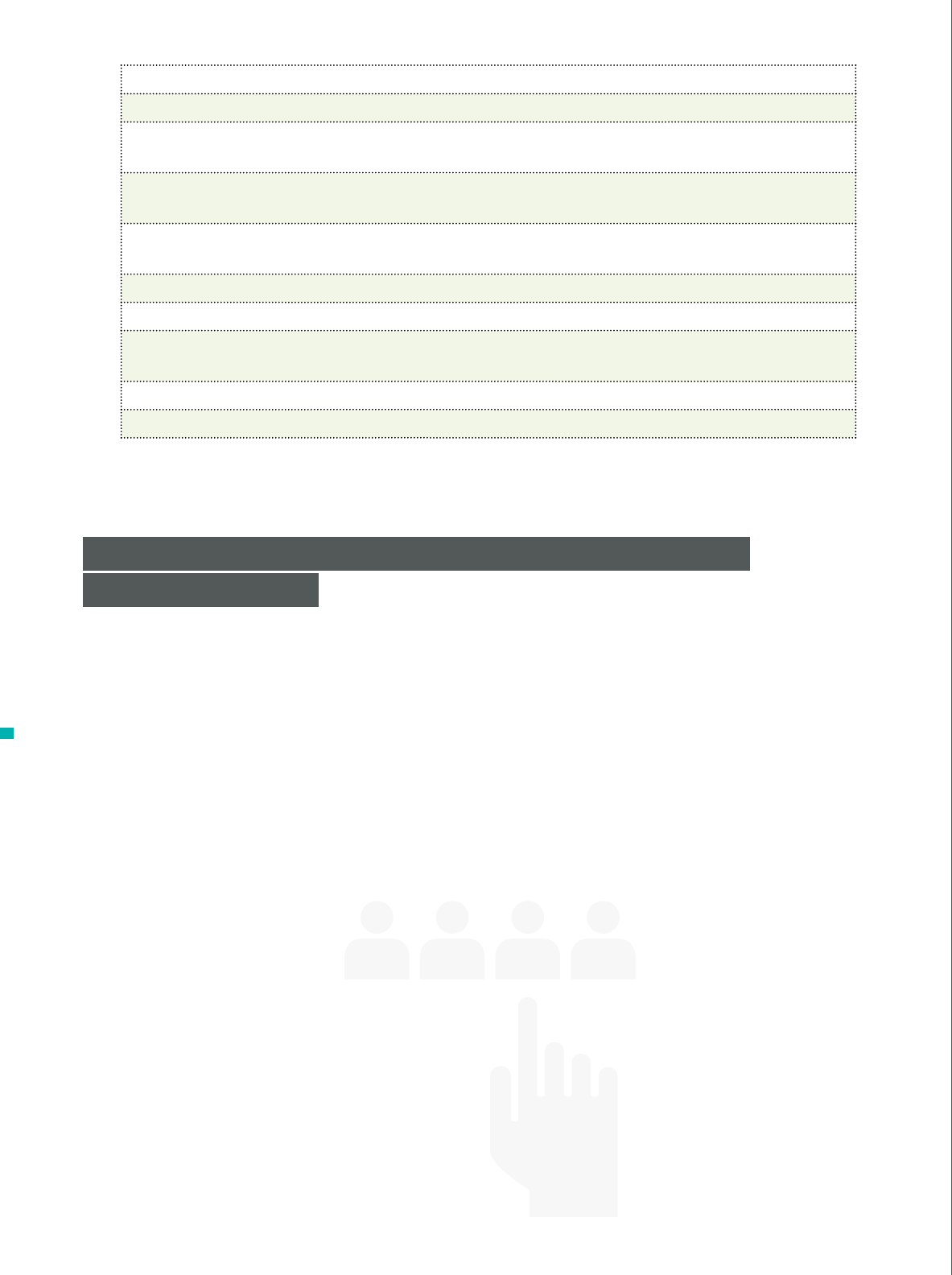
biodiversa stakeholder engagement handbook
40
Important points to consider when identifying stakeholders:
Who is responsible for making decisions that might aect the research?
Are there policies emerging or in existence that will benet from or be aected by the research? If so
who needs to be informed?
Which individuals are likely to be aected by the outputs of the research? Who, although not directly
aected, may be interested in the results of the research?
Are there stakeholders that have been involved in similar projects on previous occasions (some of
these may have been identied in Stage 1)?
Which groups or individuals may be able to provide relevant information, equipment or resources?
Who is likely to have a negative view of the research?
Which stakeholders is it essential to involve? Who is it preferable to involve? Who needs to be
consulted? Who needs to be informed?
Which parties are likely to be the most inuential?
Who will be critical to the nal delivery?
n STAGE 2: ASSESS, ANALYSE AND PRIORITISE-
The rst stage of the stakeholder identication process
detailed above should generate a comprehensive list
of all relevant stakeholders and stakeholder organ-
isations, along with an indication of the reasons for
engagement. The second stage is to assess and anal-
yse stakeholders in order to prioritise them in relation
to the necessity of engagement. Not every stakeholder
or stakeholder group needs to be involved to the same
degree, or at the same time and the same stakeholder
may be of diering relevance at dierent stages of
the research or when working with another group. By
considering the relevance of the stakeholders to the
project it is possible to establish which might be best
to contribute and which will be aected, and therefore
critical to involve
13
.
STAKEHOLDERS-

biodiversa stakeholder engagement handbook
41
0 CASE STUDY
ASSESS AND PRIORITISE STAKEHOLDERS
Identifying stakeholders often results in a complex list of people and organisations that research
teams may never have capacity to engage fully with. Therefore, it is often necessary to priori-
tise specic individuals for engagement. In the FP7 MOTIVE project, which involved case studies
across Europe, a guidance document was prepared to aid the identication of stakeholders who
were categorised in three stages. The table below shows the template used in the project. The
initial actions were:
✴ Creating a list of stakeholders
✴ Identifying their interests and roles in relation to the project
✴ Prioritising them according to their importance to, and inuence over, the project.
A set of guiding questions was used to establish the importance and inuence of stakeholders, for
example ‘how will stakeholders be aected by the project results?’ and ‘does the stakeholder have
important connections to policy?’. Stakeholders were further classied according to the typology
of who should be ‘involved’, ‘consulted’ and ‘informed’.
One of the objectives of MOTIVE was the production of an Adaptive Forest Management Toolbox,
and the stakeholder analysis was also used to identify potential end users, who were then catego-
rised according to the ways in which they might want to be involved in developing the Toolbox.
This guidance allowed researchers in the dierent case studies to follow a project protocol without
necessarily having had previous experience of stakeholder engagement.
Stakeholder
(by sector)
Contact/
position
Roles and
interests
Level of
engagement
Importance
Inuence
e.g. Private sector
Stakeholder A Person A
Owner/
manager
Involved/consulted High
Stakeholder B Person B Consultant Informed Low
There are many ways of analysing or mapping stake-
holders; most involve further categorising stakehold-
ers in some way. The most commonly used approach
is to categorise stakeholders in relation to their relative
levels of interest and inuence/relevance
16-18
. Figure
3.1 plots stakeholder inuence (i.e. whether they can
make useful contributions and positively inuence the
research or block the research, and whether they will
be aected by the outcomes), against the interest of
the stakeholder in the project.

biodiversa stakeholder engagement handbook
42
Stakeholders are plotted according to whether they
have a high or low interest in, and high or low inu-
ence on, the project. The four boxes each represent a
‘level’ of engagement, from the lowest level (‘inform’),
through the middle levels (‘consult’, and ‘involve’) to
the highest level (‘collaborate’):
✴ Stakeholders in the ‘collaborate’ box (high interest
– high inuence) are those with which it is likely to be
most benecial to engage. They may be able to supply
relevant information, permissions and resources, or
may be markedly impacted by the eventual outcomes.
✴ Those in the ‘involve’ box are highly inuential,
but have little interest in the research or low capacity/
resources to engage. Because of this, they may have
signicant inuence over the success of the project,
but may be dicult to engage in the research process.
As such, particular eort may be necessary to engage
this group in the research and therefore eort should
be made as early as possible in the research process.
✴ Those in the ‘consult’ box have high interest but low
inuence and although by denition they are support-
ive of the research, they lack the capacity to signi-
cantly help the project and deliver impact; however,
they may become inuential by forming alliances with
other more inuential stakeholders. These are often
the marginal stakeholders that may also be consid-
ered ‘hard to reach’, and that might warrant special
attention to secure their engagement and to empower
them to engage as equals in the research process with
more inuential participants. The low level of inuence
held by this group is often used as a justication for
excluding them from the research process.
✴ Those in the ‘inform’ box are stakeholders who
have little interest in or inuence over research
outcomes and it can be argued that when there are
limited project resources there is less need to consider
them in much detail or to engage with them.
Involve
Keep these stakeholders adequately
informed and maintain regular contact to
ensure no major issues are arising.
Collaborate
These stakeholders are essential to the
project and must be fully engaged with. Enlist
their full help, create partnerships, galvanize
support of the project, and make the greatest
eort to keep them satised.
Inform
Monitor these stakeholders and keep them
adequately updated as and when required,
tailoring communications to meet stake-
holder needs.
Consult
Provide these stakeholders with enough infor-
mation and interaction to keep them updated
and to address their concerns, but do not
overwhelm them with too much information.
LOW HIGH
INFLUENCE
INTEREST
LOW
HIGH
Figure 3.1 Plotting stakeholder inuence against interest. Stakeholders are
assigned to a category according to their likely contribution and interest in
the project. The boxes provide details of the levels of engagement. Figure
has been adapted from work conducted by the National Health Service (UK)
19
and the University of Edinburgh
7
.

biodiversa stakeholder engagement handbook
43
Using this approach, it is then possible to better
tailor levels of stakeholder engagement to dierent
groups, for example:
✴ Inform – adequately update interested third parties
with balanced and objective information to assist
them in understanding the problem, identify-
ing alternatives, recognising opportunities and
discovering potential solutions. Information must
however, be tailored to stakeholder needs.
✴ Consult – obtain feedback from and provide
adequate information to interested third parties
on relevant aspects of the design, methodologies,
analysis, alternatives, decision making, and desired
outcomes of a project. Care should be taken not to
overwhelm stakeholders with information outside
of their area of interest.
✴ Involve – work directly with interested third parties
throughout the project lifecycle (see Figure 4.1)
to ensure that their concerns and aspirations are
understood, considered and, where appropriate,
incorporated into decision making.
✴ Collaborate – work in partnership with individu-
als, or groups, in relevant aspects of the deci-
sion making process, including the development
of alternative methods and the identication of
preferred solutions or outcomes to ensure these
stakeholders remain fully satised.
Individual stakeholders or stakeholder groups may be
plotted in relation to their relative inuence and inter-
est in the research. Alternatively these or other vari-
ables may be represented using colours or circle/font
size given to each stakeholder
1
. Figure 3.2 provides a
hypothetical example in which ve stakeholders are
placed on an interest-inuence matrix, with the size of
circle around each stakeholder denoting their relative
expertise. The choice of components to map depends
on the research project, the stakeholders selected,
and the desired aims of the engagement. Adopting
this style of approach allows all three factors to be
simultaneously considered and enables the relative
benet of engagement to be clearly displayed in rela-
tion to the size and placement of the circles.
Figure 3.2 Interest-inuence matrix, with relative expertise
reected by the size of the circle surrounding the stakeholder (e.g.
SH1 = Stakeholder 1).
Involve Collaborate
Inform Consult
LOW HIGH
INFLUENCE
INTEREST
LOW
HIGH
SH1
SH5
SH2
SH3
SH4

biodiversa stakeholder engagement handbook
44
Although it is the most commonly used stakeholder
mapping tool, interest-inuence matrices have been
criticised for being simplistic. For example, there are
many other factors that might usefully inform the cate-
gorisation and prioritisation of stakeholders, such as
the nature of their interest in the project or alliances
or conicts between stakeholders. For this reason,
Reed et al.
3
propose the use of ‘extendable matri-
ces’ that not only consider levels of interest and inu-
ence, but also attempt to characterize the nature of
those interests and document reasons for the level of
inuence that is ascribed (e.g. considering whether a
stakeholder holds more, or less, inuence in dierent
contexts or at dierent times). An example is given in
Name of
Organisa-
tion
Interest
(High (H)/
Medium (M)/
Low (L))
What aspects
of the research
are they likely
to be inter-
ested in?
If interest is
L/M, how
might we
motivate
engagement
with the
research?
Key
messages
from your
research for
this group
Inuence
H/M/L
Comments on inu-
ence (e.g. times or
contexts in which
they have more/less
inuence over the
outcomes of your
research)
Key
contact(s)
and best way
of contacting
them
Table 3.2
An extendable interest-inuence matrix with examples of additional columns that may be added to capture more
detail about each stakeholder than is typically possible using graphical techniques. A template of this matrix can
be downloaded from http://www.biodiversa.org/577
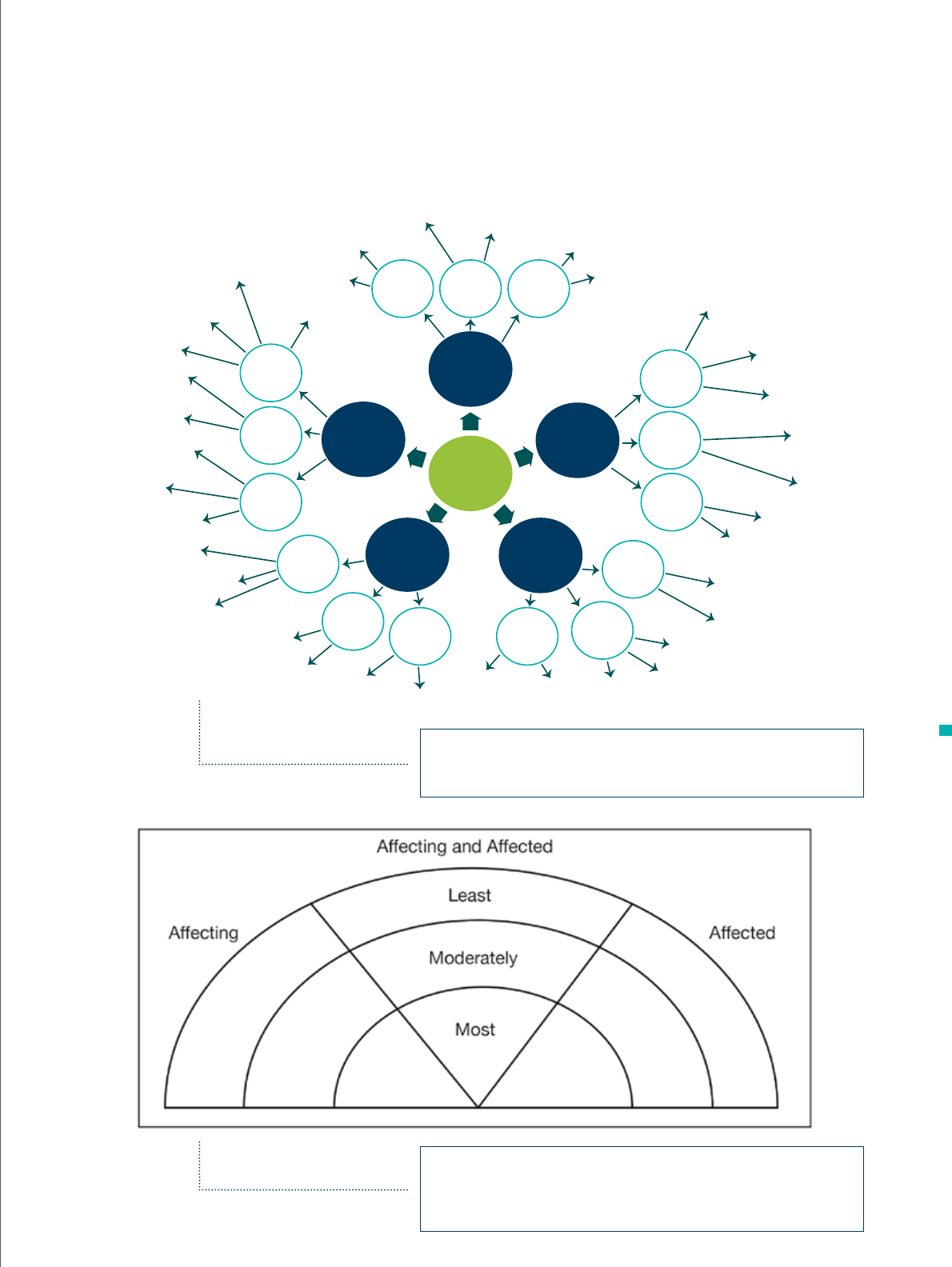
biodiversa stakeholder engagement handbook
45
Stakeholders in
Ecosystem
Local
Users
Farming
Private
Estate
Local
Authority
Other
Businesses
Utility
Companies
Tour
Operators
Consultants
Academics
NGO’s
Other
Users
Other
Users
Regular
Users
Regular
Users
Potential
Users
Wild Food
Collectors
Mountain
Bikers
Horse Riders
Walking Clubs
Local Schools
Walkers
Fruit Orchards
Anglers
Fish Farming
Livestock
Farming
Crop Farming
Shooting
Club
National
Trust
County
Council
Parish
Council
Borough
Council
Pubs /
Restaurants
Bike Hire
Centre
Convenience
Store
Water
Companies
Renewable
Energy
Companies
Coach / Train
Companies
Hotels
B&B
Ecological
Experts
Green
Infrastructure
Experts
Independent
Experts
Students
University
Researchers
Public Health
NGO
Conservation
NGO
Artists
Canoeists
Recreational
Divers
Bird Watching
Community
Schools/
Universities
Day Trippers
from City
Potential
Users
Economic
Beneciaries
Landowners
Professional
Interests
Wider
Catchment
Users
Table 3.2.
A number of visual tools may be used to help map
stakeholders, for example constructing a mind-map
(an example is given in Figure 3.3). The rst step in
developing a mind map is identifying the major groups
of users that make up the centre of the map, and
then progressing towards greater detail as you move
towards the outer edges
15
. Alternatively, Chevalier and
Buckles
8
recommend placing stakeholders in a ‘‘rain-
bow diagram’ that classies them according to the
degree they can aect or be aected by the research
(Figure 3.4).
Figure 3.3 Example of stakeholder mind map, adapted from
Forestry Commission
15
.
Figure 3.4 Rainbow diagram for classifying stakeholders accord-
ing to the degree they can aect or be aected by a research proj-
ect
8
.

biodiversa stakeholder engagement handbook
46
When identifying stakeholders for inclusion it is impor-
tant to keep in mind whether this process will be
open to stakeholder scrutiny. For example, if stake-
holders were to view mapping diagrams and tables
it is important to consider how they may react to the
assumptions being made about them and how this
could impact working relationships. In cases where
full transparency is needed it may be considered more
appropriate to involve stakeholders in the mapping
process and provide opportunity for them to assign
themselves into the dierent groups. It may also be
necessary to agree mutually acceptable terminologies
and denitions for the four levels of engagement.
In order to consider a stakeholder’s interest in, or rele-
vance to, a project, the project team should always
consider:
✴ What interest does the stakeholder have in the
project?
✴ What inuence can the stakeholder have on the
project?
✴ How may the stakeholder be impacted or aected
by the project?
✴ How benecial would engagement of the stake-
holder be to the project and why?
Using the previous tools to map and prioritise stake-
holders provides a clear rst assessment of the types
of stakeholders the project will need to engage with,
and to what extent. However, it is also important to
remember that dierent levels of engagement may
be necessary with particular stakeholders at dierent
times of the project. This is discussed further in Parts
4 and 5 of this Handbook on timing and methods of
engagement.
n STAGE 3: UNDERSTAND YOUR STAKEHOLDERS-
Having begun to prioritise the relevant stakehold-
ers, it is helpful to obtain a greater understanding of
their motivations, interests, expertise and capacity to
engage when considering how and when to engage
with them. The following has been adapted from work
undertaken by University of Edinburgh
7
and Account-
Ability
20
and provides some key points the project
team should consider when understanding relevant
stakeholders:
✴ Is there an existing relationship between the
project and the stakeholders? Do relationships
already exist between stakeholders?
✴ What knowledge do the dierent stakeholders
possess that may be relevant to the project?
✴ What views are the stakeholders likely to hold
about the project and its outcomes, will these
views be positive or negative? Is there the
potential for any conict arising amongst stake-
holders or between stakeholders and the proj-
ect?
✴ What are the appropriate means of communica-
tion and will this need to be adapted in order to
reach certain groups or individuals?
✴ Is there a willingness to engage; if not, why not,
and how could this be overcome? Are there any
barriers to participation and/or engagement
(e.g. technical, physical, linguistic, geographi-
cal, political, time, information or knowledge)?
The type of information described above can be tabu-
lated; an example of how this could be approached is
shown in Table 3.3. This builds on the extended inter-
est–inuence matrix (Table 3.2) approach. Research-
ers may wish to combine these into a single matrix to
save time. Such matrices can be extended to consider
a range of factors that may help to categorise and
engage eectively with stakeholders. For example:
identifying any important relationships between stake-
holders (e.g. coalitions or conicts); information about
how best to approach and engage with dierent
stakeholders; contact information; and an assessment
of the potential impacts or eects the research may

biodiversa stakeholder engagement handbook
47
have on the stakeholder
1,7,19,21,22
.
Understanding relationships between stakeholders
can be extremely useful in the process of engage-
ment. Whilst there is rarely time available to do so in
depth, there are a range of methods available to do
this should researchers wish to do so. These meth-
ods include those to analyse social networks, map
stakeholder perceptions and values, and methods to
assess and analyse conicts between stakeholders
(discussed further in Part 7 of this Handbook). These
methods are generally employed once stakeholders
have been categorised in order to understand how
dierent stakeholder groups interact with one another,
and to identify specic individuals or organisations
that may play an important role in diusing knowledge
or practices within and between dierent groups of
stakeholders. These methods help to clarify opportu-
nities and risks of engaging with certain stakeholders,
identify the values and priorities of dierent groups
and how this may inuence engagement.
The completed table should provide a representative
list of relevant stakeholders, and the levels of engage-
ment required. The stakeholders themselves could be
consulted for their views (when appropriate) to ensure
they agree with the details entered; this may also prove
to be an eective method for establishing an open
and transparent working relationship. The table used
to understand stakeholders should be reviewed peri-
odically throughout the project cycle for a number of
reasons, including: stakeholders may request greater
involvement at dierent stages of the project to those
originally identied by the project team; new stake-
holder groups may request involvement; a need may
arise to engage over previously unforeseen subject
matter or issues; there may be a shift in the direction
of the research or the outcomes which needs to be
communicated
13
.
This analysis process goes some way towards indi-
cating the varying levels of engagement required in
the projects. The outcomes of the ‘identifying stake-
holders’ process can be used to consider the types of
engagement required and/or the timing and role of the
engagement process. By developing a sound under-
standing of the stakeholders, the appropriate stage(s)
to engage, types of suitable engagement activities,
and any potential barriers that exist which could inhibit
engagement, become clearer.

biodiversa stakeholder engagement handbook
48
Stakeholder Existing relationship
Relationship
with other
stakeholders
Knowledge of
the project
Views on the
project
Best means of
communication
Willingness to
engage
Capacity to
engage
Collaborate
Government policy
makers
Scientists from
same discipline
Involve
Landowners
NGOs
Consult
Businesses
Students
Scientists from
dierent discipline
Local community
Inform
General public
Media
Table 3.3
Understanding your stakeholders. Examples of typical stakeholders and possible overall levels of engagement have been provided. The overall
level of engagement will depend on the results of the mapping exercise. Stakeholders can be grouped according to the overall level identied
and/or the level can be depicted through the use of certain colours or type face, as shown in this example matrix. A template of this matrix can
be downloaded from http://www.biodiversa.org/577
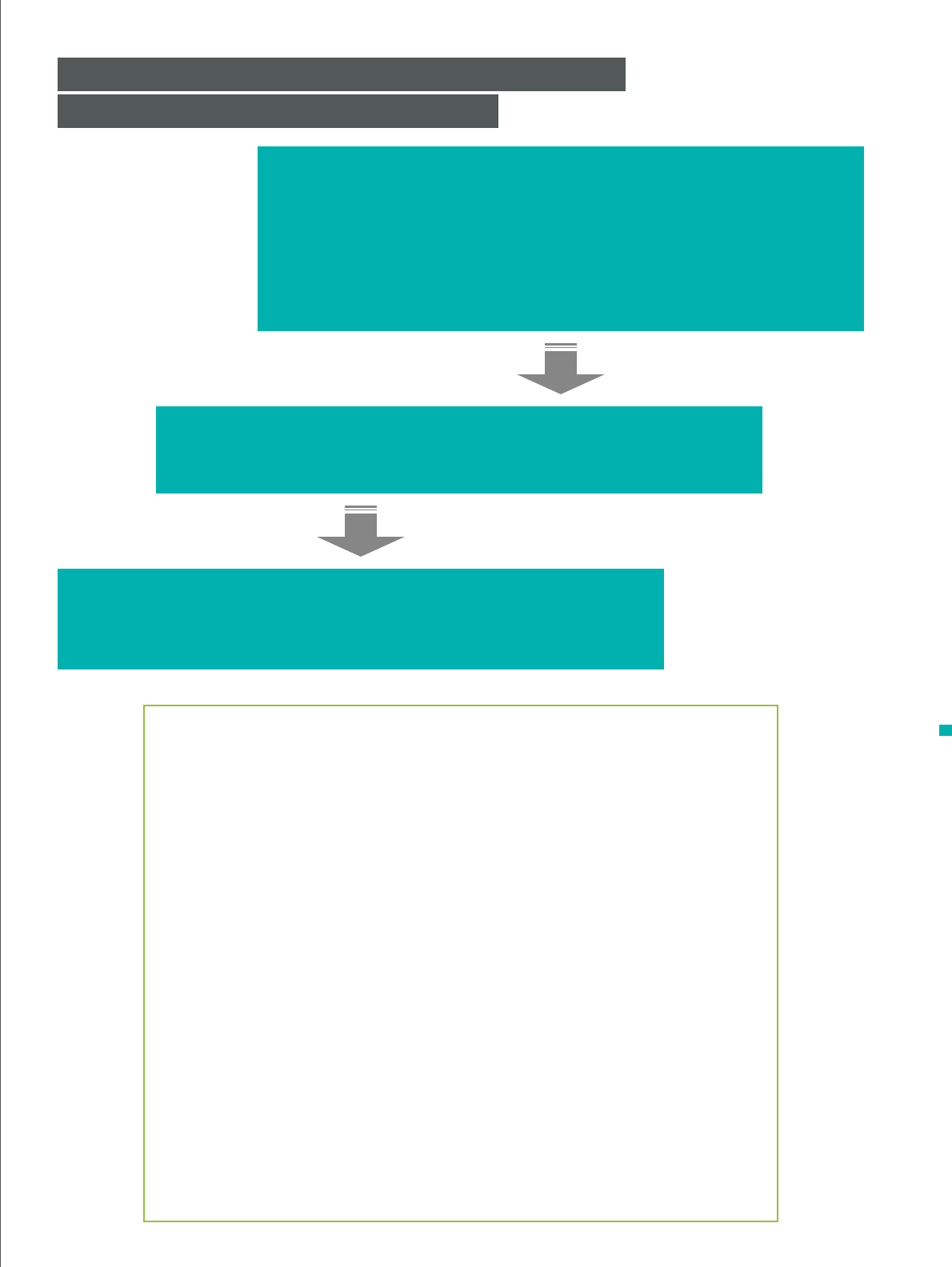
biodiversa stakeholder engagement handbook
49
n SUMMARY OF THE THREE STAGES OF-
STAKEHOLDER IDENTIFICATION-
0
CASE STUDY
IDENTIFYING STAKEHOLDERS – PROBLEMS
THAT MAY BE ENCOUNTERED
In practice, actually getting eective engagement with stakeholders can be challeng-
ing. There are numerous examples of ‘stakeholder fatigue’, and challenging power
dynamics from biodiversity research. Doing a careful stakeholder analysis, following
the three stages outlined in this Handbook, can help identify and motivate engagement
from those stakeholders who are most relevant to the research. But this is not always
a simple process. A researcher from the FP7 HUNT project highlighted the challenge
of maintaining the involvement of stakeholders over the course of a research project,
and explained how strategic stakeholder identication, where careful thought is given
to which individuals from stakeholder organisations are invited, can help mitigate this.
A National Consultative Forum (NCF) was set up in each of the research partner coun-
tries whose remit was to meet annually to contribute to research development and
dissemination. There were frequently changes of representatives participating in the
NCF, which presented a barrier to strengthening relationships and achieving a sense
of common purpose among the groups. It was suggested that this was partly due to
‘stakeholder fatigue’. To deal with this issue, researchers may need to balance the
inuence and expertise of stakeholders with their interest and commitment to the proj-
ect, during the stakeholder identication process.
STAGE 1: WHO ARE YOUR STAKEHOLDERS?
✴ Identify stakeholders with research team only or identify stakeholders in collaboration
with a small number of cross-sectorial stakeholders.
✴ Use ex-ante (identifying stakeholders in predened categories) or ad-hoc (identifying
new stakeholders iteratively based on recommendations from existing stakeholders)
approach to systematically indentify all relevant stakeholders.
✴ Re-assess who has a stake in your research regularly throughout the research cycle.
STAGE 2: ASSESS, ANALYSE AND PRIORITISE STAKEHOLDERS
✴ Categorise stakeholders according to their interest and inuence and decide if you
should collaborate with, involve, consult or inform them.
STAGE 3: UNDERSTAND YOUR STAKEHOLDERS
✴ Seek information about stakeholders' relationships with orther stakeholders, knowl-
edge and attitudes towards the research, willingness and capacity to engage and
best ways of communicating with them.

biodiversa stakeholder engagement handbook
50
0 CASE STUDY
ECOSYSTEM SERVICE PROVISION FROM COUPLED PLANT
AND MICROBIAL FUNCTIONAL DIVERSITY IN MANAGED GRASS-
LAND
Given increasing political and public concern for the environment, and result-
ing changes in legislation and policy, European agriculture is challenged to provide
ecosystem services, such as carbon storage and protection of water quality, along
with biodiversity conservation and maintenance of economically viable production.
The BiodivERsA VITAL project studies mountain grasslands where abandonment of
manuring, mowing and grazing, or conversely management intensication, has altered
plant species and functional diversity, soil microbial activities and diversity, soil nitro-
gen transformation processes and soil fertility maintenance. These changes have the
potential to fundamentally shift the ecosystem services that these agro-ecosystems
can provide, and thereby the livelihood and development potential for local economies.
Research conducted at three sites in the French Alps, Austria, and the UK, provides a
representative range of management and natural conditions.
HOW WERE STAKEHOLDERS IDENTIFIED?
✴
Regional experts and local stakeholders for the ecosystem service assessment
were selected by reputation or recommendations.
✴ For scenario workshops held in Austria, farmers were selected based upon
diering farm structure characteristics (full-time/ part-time, traditional/ modern,
conventional/ alternative production etc.).
✴ In France the scenario development involved a rst stage with regional experts
who represented dierent sectors and a second stage with eight local farmers
from the Villar d’Arène municipality.
WHAT DIFFERENT TYPES OF STAKEHOLDERS WERE IDENTI-
FIED?
✴
Regional experts working for governmental institutions.
✴ Regional institutions.
✴ NGOs that represent consumers of their sectors of activity (e.g. agriculture, nature
conservation, tourism or rural development) and act as decision makers.
✴ Local beneciaries who are consumers (e.g. farmers and inhabitants).
✴ Producers (e.g. farmers).
HOW MANY GROUP AND INDIVIDUAL
STAKEHOLDERS WERE INVOLVED?
✴
Regional experts: 22 (agricultural sector),
23 (non-agricultural sector).
✴ Local beneciaries: 35.
©
Laboratoire d'Ecologie Alpine, VITAL project
Role playing game with
farmers from Villare
d'Arêne (Hautes Alpes,
France), VITAL project.

biodiversa stakeholder engagement handbook
51
n REFERENCES-
1 MORRIS, J. and BADDACHE, F. 2012. Back to Basics: How to make stakeholder engagement meaningful to your company. BSR
Europe, 19 pp. Available from: http://www.bsr.org/reports/BSR_Five-Step_Guide_to_Stakeholder_Engagement.pdf [Accessed 9
June 2014].
2 NEWIG, J. and FRITSCH, O. 2009. Environmental governance: participatory, multi-level – and eective? Environmental Policy and
Governance, 19, 197–214. Available from: http://econstor.eu/bitstream/10419/44744/1/604559410.pdf [Access 11 April 2014].
3 REED, M.S., GRAVES, A., DANDY, N., POSTHUMUS, H., HUBACEK, K., MORRIS, J., PRELL, C., QUINN, C.H. and STRINGER, L.C.
2009. Who’s in and why? A typology of stakeholder analysis methods for natural resource management. Journal of Environmental
Management, 90, 1933–1949. Available from: http://sustainable-learning.org/wp-content/uploads/2012/01/Who%E2%80%99s-in-
and-why-A-typology-of-stakeholder-analysis-methods-for-natural-resource-management.pdf [Accessed 9 June 2014].
4 STANGHELLININ, P.S.L. 2010. Stakeholder involvement in water management: the role of stakeholder analysis within participatory
processes. Water Policy, 12, 675-694. Available from: http://www.iwaponline.com/wp/01205/wp012050675.htm [Accessed 9 June
2014].
5 DE VENTE, J., REED, M.S., STRINGER, L.C., VALENTE, L.C., VALENTE, S., NEWIG, J. (in press). How does the context and design
of participatory decision-making processes aect their outcomes? Evidence from sustainable land management in global drylands.
Journal of Environmental Management.
6 NATURAL ENVIRONMENT RESEARCH COUNCIL (NERC). 2010. Guidance for Applicants: Pathways to impact for research grant
proposals. 10 pp. Available from: http://www.nerc.ac.uk/funding/application/howtoapply/pathwaystoimpact/ [Accessed 31 March
2014].
7 UNIVERSITY OF EDINBURGH. 2008. Stakeholder engagement. 7 pp. Available from: http://www.docstoc.com/docs/54409298/
Stakeholder-Engagement-Guidelines-University-of-Edinburgh [Accessed 30 April 2012].
8 CHEVALIER, J.M. and BUCKLES, D.J. 2008. SAS2: A Guide to Collaborative Inquiry and Social Engagement. Sage Publications,
Available from: http://omec.uab.cat/Documentos/coop_internacional/00110.pdf [Accessed 31 March 2014].
9 DOUGILL, A.J., FRASER, E.D.G., HOLDEN, J., HUBACEK, K., PRELL, C., REED, M.S., STAGL, S. and STRINGER, L.C. 2006. Learn-
ing from doing participatory rural research: lessons from the Peak District National Park. Journal of Agricultural Economics, 57,
259–275. Available from: http://onlinelibrary.wiley.com/doi/10.1111/j.1477-9552.2006.00051.x/abstract [Accessed 9 June 2014].
10 GILMOUR, P.W., DWYER, P.D. and DAY, R.W. 2011. Beyond individual quotas: the role of trust and cooperation in promoting steward-
ship of ve Australian abalone sheries. Marine Policy, 35(5), 692-702.
11 GILMOUR, J. and BEILIN, R. 2007. Stakeholder Mapping for Eective Risk Communication. Australian Centre for Risk Analysis. Avail-
able from: http://www.acera.unimelb.edu.au/materials/publications/gilmour0609.pdf [Accessed 31 March 2014].
12 JOLIBERT, C. and WESSELINK, A. 2012. Research impacts and impact on research in biodiversity conservation: Inuence of Stake-
holder Engagement. Environmental Science & Policy, 22,100–111.
13 POUND, D. 2004. Stakeholder Dialogue – a good practice approach to participation. Training Manual. Dialogue Matters, 20 pp.
14 WHYTE, H., LE TISSIER, M. and HILLS, J. 2010. A Step-by-Step Guide through the Theory, Process and Practise of Stakeholder
Engagement. Environs Management Ltd, UK. Available from: http://imcore.les.wordpress.com/2009/08/trust-guide-nal-2011.pdf
[Accessed 30 April 2012].
15 FORESTRY COMMISSION. 2011. Public Engagement in Forestry: a toolbox for public engagement in forest and woodland planning.
Forestry Commission, Edinburgh. Available at: http://www.forestry.gov.uk/forestry/infd-5xmds8 [Accessed 8 November 2013].
16 LINDENBERG, M.M. and CROSBY, B.L. 1981. Managing Development: the Political Dimensions. Kumarian Press, West Hertford, CT,
USA.
17 EDEN, C. and ACKERMANN, F., 1998. Making Strategy: The Journey of Strategic Management, Sage Publications, London.
18 DE LOPEZ, T. T., 2001. Stakeholder Management for Conservation Projects: A Case Study of Ream National Park, Cambodia. Envi-
ronmental Management, 28 (1), 47-60. Available from: http://link.springer.com/article/10.1007%2Fs002670010206 [Accessed 9 June
2014].
19 NATIONAL HEALTH SERVICE (UK). 2009. Stakeholder Engagement Guidelines. Power Point presentation. Available from:
https://www.google.co.uk/url?q=http://www.connectingforhealth.nhs.uk/systemsandservices/scr/documents/screngage.
ppt&sa=U&ei=baxXU7OhNorX7Aak_oDgDA&ved=0CCAQFjAA&usg=AFQjCNH2c9oTIkxH6hOsoPTu6sLBtVhzFA [Accessed 23 April
2012].
20 ACCOUNTABILITY. 2008. AA1000 Stakeholder Engagement Standard 2011. 52 pp. Available from: http://www.accountability.org/
images/content/5/4/542/AA1000SES%202010%20PRINT.pdf [Accessed 23 April 2012].
21 REVIT. 2007. Working Towards more Eective and Sustainable Browneld Revitalisation Policies: Stakeholder Engagement – A Tool-
kit. Torfaen County Borough Council, Torfaen, 38 pp. Available from: http://www.revit-nweurope.org/selfguidingtrail/27_Stakeholder_
engagement_a_toolkit-2.pdf [Accessed 11 April 2014].
22 JEFFREY, N. 2009. Stakeholder Engagement: A roadmap to meaningful engagement. Dougherty Centre, Craneld School of
Management, Craneld, 48 pp. Available from: http://www.som.craneld.ac.uk/som/dinamic-content/media/CR%20Stakeholder.
pdf [Accessed 11 April 2014].

biodiversa stakeholder engagement strategy
52
› Mapping stakeholder roles to dierent stages of the
project lifecycle
›› Case study
When to engage
When to engage
with stakeholders

biodiversa stakeholder engagement strategy
53
Part 4

biodiversa stakeholder engagement handbook
54
n WHEN TO ENGAGE WITH STAKEHOLDERS-
❝
Assessing the most benecial
times to engage with dierent stakeholders
and stakeholder groups, including ways to adapt
as the project develops ❞
Ways of identifying, mapping and deciding on levels of
engagement with dierent stakeholders are covered in
Part 3 of this Handbook. Methods for engagement are
covered in Part 5. However, actual levels of engage-
ment are likely to vary at dierent times throughout
the lifecycle of the project, depending on the possible
and actual contributions of stakeholders at dierent
times. Most stakeholders are likely to be involved at
discrete times throughout the project, rather than all
the time. Involvement of all stakeholders throughout
the whole project, from inception to dissemination of
nal outcomes, would be costly in terms of time and
resources, for both the project and the stakeholders.
Although much can be done to adapt research outputs
to feed into the events and issues of relevance to dier-
ent stakeholders, timing (whether good or bad) will
always inuence the extent to which research ndings
are likely to be perceived as relevant by stakeholders.
Timing may also aect the way that knowledge from
research is used in the decision-making process. For
example, at certain times during research that is ulti-
mately to be used to formulate policy, new opportuni-
ties for policy-makers may emerge (e.g. feeding into
election manifestos). At other times, research may
help address specic challenges faced by decision-
makers (e.g. a pest or disease outbreak), and at other
times, research may simply be used to justify or jeop-
ardize existing opinions or policy positions if research
ndings that are consistent with the decision arrive
after the decision has been made
1
.
In order to maximise the benets of stakeholder
engagement, it is useful to consider the timing of the
most-appropriate contributions that each stakeholder
might make towards the project; the roles they might
adopt; and when these are critical to the success and
impact of the research. It is also useful to assess the
possibility of temporary or complete disengagement,
for whatever reasons, and how this can be managed
and how it will impact on the outcomes of the project.
The desired contributions or roles that stakehold-
ers are expected to play can be assigned to various
stages of the project, keeping in mind that roles may
vary as the project progresses. For example, stake-
holders assisting in early development of the project
will be involved at inception, whereas those involved
with disseminating or using results will mainly be
involved at a later stage.
The research project lifecycle is represented in Figure
4.1. This is a simplied view; in reality stages might
have a dierent order, or overlap, and feedback loops
might exist in which learning and modications are
a part of the research process. In addition, projects
might continue beyond the initial funding period, either
because of an additional phase of funding or if stake-
holder-led monitoring is undertaken. Longer term rela-
tionships with stakeholders might be an important
requirement, especially if new projects in the same
study area are possible, and this might also inuence
the level and timing of involvement of particular stake-
holders.

biodiversa stakeholder engagement handbook
55
n MAPPING STAKEHOLDER ROLES TO DIFFERENT STAGES-
Once stakeholders are identied and their possible
roles dened, the stage in the research cycle where
these roles might be most benecial can be identi-
ed. The impact of not gaining engagement with
specic stakeholders can also be assessed, and the
risks associated with loss of engagement and ways of
managing this set out.
Table 4.1 summarizes the kinds of contributions or
roles that stakeholders might make or take in each
stage of a project.
Figure 4.1 Simplied diagram of a project lifecy-
cle. Stakeholders could be engaged at any or all of
these stages depending on the type of project and
desired roles, but the most important stages for
stakeholder engagement are shown in bold.
OF THE PROJECT LIFECYCLE-
Concept
development
Knowledge
exchange & data
sharing
Development of
communications
Interpretation of
results
Training
Data
analysis
Data
collection
Research design &
knowledge exchange
planning
Identification
of new
information
or research
needs

biodiversa stakeholder engagement handbook
56
Table 4.1
Denitions of possible stakeholder roles/contributions during the life cycle of a project (adapted from Jolib-
ert, 2011
2
).
Project stage Stakeholder role or contribution
Before
✴ Help to dene the project concept and project design/research strategy, including identi-
fying useful potential outcomes and common interests
✴ Identify other potential stakeholders and possible roles
✴ Help dene the best governance approach for stakeholder engagement
✴ Identify possible scope of their own contributions, including motivation, and associated
limitations
✴ Highlight possible risks and potential for conicts to arise
✴ Advise on knowledge exchange requirements
Before and
during
✴ Establish agreements on access to study sites
✴ Provision of resources – for example, equipment, funding, sta time
✴ Dening project plans, including stakeholder engagement planning
✴ Co-design and development of conict resolution approaches, if relevant
✴ Networking and awareness raising with non-contributory stakeholders
During
✴ Assist with training of other stakeholder to enhance delivery or participation
✴ Data provision, including capturing new data (monitoring)
✴ Prediction and modelling – informing development of scenarios and models, or participa-
tion in data analysis
✴ Review project success, including stakeholder engagement approach
✴ Assist in dening and developing tools
✴ Conict resolution, if relevant
During/
after
✴ Dene, develop and help deliver knowledge exchange activities and publications
✴ Implementation of results – testing outputs of the research (e.g. tools, new methodologies,
strategies)
✴ Advise on data exchange requirements
After
✴ Publicity, promotion, via channels such as websites, academic materials, research reports,
newsletters, books, guidelines, social media and the general media (newspapers, radio
and television)
✴ Review project success, including stakeholder engagement approach
✴ Identify future information, tools and research needs
✴ Develop stakeholder-led monitoring and networking beyond life of funded project

biodiversa stakeholder engagement handbook
57
Not all of the roles identied in Table 4.1 will neces-
sarily be appropriate for every project, and other roles
might be identied. In some instances more than one
stakeholder may be identied to undertake some roles
and in other situations an individual stakeholder or
stakeholder group may well carry out multiple roles
throughout the project cycle.
It is important to work with stakeholders to assess and
plan their contributions and sharing initial ideas using
a draft plan, which allows a more systematic assess-
ment, can be helpful.
However, stakeholder interaction is an important
consideration that can complicate the timing of
engagement and the roles that some stakehold-
ers actually take. In some projects, especially those
purposefully tackling controversial research, for exam-
ple related to wildlife management, it will be critical to
build trust, and a broader range of engagement meth-
ods will be needed. For some tasks, separate meetings
with single stakeholders or groups might be required
to help develop relationships and avoid conict, as
well as bringing dierent stakeholders together to
allow exchange of views. Timing of engagement might
dier when dealing with stakeholders in conict and
more time and resources will be required.
0 CASE STUDIES
WHEN TO ENGAGE
PLAN EARLY ENGAGEMENT
Most researchers from the case studies recognised the value of engaging stakeholders
as early in the project as possible. Researchers on the BiodivERsA FIREMAN project
involved stakeholders at the proposal writing stage. This was viewed very positively
by a stakeholder from the Peak District case study in England who felt that this early
engagement gave the stakeholders a sense of ownership of the project, as they were
able to inuence the design of the research programme.
Other projects indicated that they would have liked to have been able to have stake-
holder input at an early stage, but this was not possible due to limited time and funding
during the proposal writing phase. It is advisable to carry out a pre-proposal scoping
exercise to allow stakeholder input into project development where possible. Once the
proposal is written, there can be limited exibility to adapt the research programme to
meet the requirements of stakeholders.
This issue was encountered after the FP7 HUNT project received funding. Here, stake-
holders viewed the project as an opportunity to pursue certain avenues of interest to
them, which could not always be accommodated within the constraints of the project.
The expectations of stakeholders must be carefully and early managed to ensure they
are aware of their role in the project and the extent to which they may inuence the
research.
ASSESS STAKEHOLDER ROLES
Researchers on the FP7 MOTIVE project decided what level of engagement would be
appropriate for each stakeholder group based on their stakeholder analysis, which
included understanding the interest and inuence of stakeholders in the project and
the type of role they may play in the research (see Part 3 of this Handbook). Engage-
ment was categorised according to three broad levels:
✴ Involve in design and implementation

biodiversa stakeholder engagement handbook
58
✴ Consult about key elements such as scenarios and indicators, or for data collection
✴ Inform about the project and its outputs.
Stakeholders were given a choice about their role in the engagement. Some stake-
holders had knowledge that was directly relevant to the proposed models for adap-
tive forest management and agreed to be involved in their development, while others
preferred to be consulted during specic stages of development or informed later
about the results of model runs. In this way stakeholders were engaged at dierent
stages of the project making the process more ecient and targeted, reducing unnec-
essary burden on participants, thereby avoiding ‘stakeholder fatigue’.
PLAN THE TIMING OF ENGAGEMENT THROUGHOUT THE
RESEARCH PROJECT
If the timing of research ts well with the interests and agendas of stakeholders, this
makes successful engagement more likely. The timing of stakeholder engagement was
critical for the BiodivERsA Ecocycles project. In the agro-steppe areas of Northern
Spain, changes in agricultural land use have resulted in outbreaks of rodent popula-
tions that cause considerable crop damage and pose a threat to human health.
The means of managing outbreaks was (and still is) a source of strong conict among
stakeholders and there was an urgent need for improved management strategies in
the face of anticipated outbreaks. As the researchers were conducting investigations
on the relationship of outbreaks with land use and climate at a time when this was an
important issue for stakeholders, there was a high level of interest and participation.
It was originally proposed that stakeholder meetings would take place annually, but in
the rst meeting, this was discussed with stakeholders and they expressed a prefer-
ence to hold them more frequently. The fact that there was exibility within the project
to accommodate this was benecial for stakeholder–researcher relations.
However, during the project lifecycle stakeholders had to take decisions on pest control
strategies before researchers were able to provide results, this led to discouragement
about the potential for using research in decision-making among certain stakeholders.
This highlights the need to ensure stakeholder engagement is timed to coincide with
the issue being addressed, as well as managing stakeholder expectations with regards
to time-scale of delivery of results.

biodiversa stakeholder engagement handbook
59
n REFERENCES-
1 WEISS, C.H. and BUCUVALASs, M.J. 1980. Social Science Research and Decision Making. Columbia University Press, New York.
2 JOLIBERT, C. 2011. Stakeholder Engagement in EU Research: bringing science to bear on biodiversity governance. Conference
ESEE, 18 pp. Available from: http://www.esee2011.org/registration/fullpapers/esee2011_c3e403_1_1304967722_4161_2164.pdf
[Accessed 23 April 2012].

biodiversa stakeholder engagement strategy
60
› Types of engagement method
› Practical methods notes
› Engagement skills
› Matching methods to levels of engagement
›› Case studies
Understanding historical events
Methods for
engagement

biodiversa stakeholder engagement strategy
61
Part 5

biodiversa stakeholder engagement handbook
62
n METHODS FOR ENGAGEMENT-
❝
Identify and develop the methods that will be used to
engage with dierent stakeholders and stakeholder groups
at dierent stages in the lifecycle of the project. ❞
The methods used for engagement depend upon
objectives, the required level of engagement, the
timing of when engagement activities are intended to
take place, and the expected role of the stakeholder(s).
Initial assessment with stakeholders of the desired
outcomes from a project (see Part 2) can help iden-
tify which methods are most likely to deliver these
outcomes and achieve the purpose identied for the
engagement process
1
. All engagement methods have
particular strengths and weaknesses; the key is to
choose the right one(s) for the particular purpose and
context. Methods should also be selected to meet
the needs, capacity and expectations of the relevant
stakeholders. More than one method is often desirable
and several methods can be combined to achieve an
aim.
n TYPES OF ENGAGEMENT METHOD-
Stakeholder engagement methods can be participa-
tory (two-way) or informative (one-way). Informative
methods are considered for engagement as long as
they meet the needs of stakeholders and are designed
with those needs in mind; which usually means that
they are co-dened and possibly co-designed with the
stakeholders. There are many engagement methods
being used by dierent projects and new methods are
being continually developed. The methods described
in this section include the ones most commonly used
by environmental organisations and projects
2
.
The key to success is to understand the broad range
and types of methods being used, what they are being
used for, and why one might be more suitable than
another in a particular context and for a particular
purpose
2
. A wide range of techniques are available
to facilitate eective two-way engagement between
researchers and stakeholders, ner details of these
techniques are listed below but broadly speaking
these can be categorised as:
✴ OPENING OUT techniques for opening up
dialogue and gathering information with stakehold-
ers about issues linked to research. This collection
of techniques is particularly useful during the initial
phases of a research project, either during the
development of initial research questions prior to
writing a funding proposal, or in the early phases
of a funded project, where the research goals and
programme of work are being adapted to t the
needs and interests of stakeholders better.
✴ EXPLORING techniques that can help evaluate
and analyse preliminary ndings with stakehold-
ers. Given the length of most research projects,
getting early feedback on preliminary ndings can
help keep stakeholders interested in the process
and give them greater ownership over the eventual
research outcomes. Feedback can also provide
researchers with ideas about how to further rene
their work, such as where assumptions are not
clear or are questioned by stakeholders.
✴ DECIDING after issues have been opened up,
explored, and analysed, it is often necessary to
start closing down options and deciding upon
actions based on research ndings. There are a
number of techniques that can engage researchers
and stakeholders in decisions based on research
ndings, for example prioritising particularly inter-
esting or relevant ndings for further research or

biodiversa stakeholder engagement handbook
63
action.
✴ INTEGRATING techniques can be used for explor-
ing, analysing and deciding. These techniques can
be used throughout the entire research process.
n OPENING OUT TECHNIQUES INCLUDE:
✴ BRAINSTORMING techniques can help rapidly
identify initial ideas from a group. By getting partic-
ipants to think rapidly and express their ideas in
short phrases, the technique encourages partici-
pants to suspend the normal criteria they would
use to lter out ideas that may not appear imme-
diately relevant or acceptable. As such, many of
the ideas may not be useable, but there may be
a number of new and creative ideas that would
not have been expressed otherwise, that can be
further developed later. A useful guide to a range
of brainstorming techniques can be found on the
Mind Tools website: http://www.mindtools.com/
brainstm.html
✴ When using a METAPLAN, participants are given
a xed number of note papers (usually between
two and ve, depending on the size of the group;
with fewer pieces of note paper being used in large
groups), and asked to write one idea per piece of
paper. Participants then take their note paper and
place them on the wall, grouping identical, simi-
lar or linked ideas together. The facilitator then
summarises each group, checks the participants
are happy with the grouping (making changes
where necessary) and nally circles and names
each of the groups. Within ten minutes, it is usually
possible for everyone to express their views and
this provides a summary of the key issues that can
be used to structure subsequent group activities.
✴ VENN DIAGRAMS can be used for a similar
purpose as metaplans, helping participants identify
key issues and overlaps or connections between
the issues.
✴ There are a variety of ways to get participants to LIST
ideas or information, for example via responses to
requests for information on social media platforms
or online discussion boards, or in group work by
creating ‘stations’ around the room where partici-
pants can list information or ideas on a particular
topic or issue. Stations may for example be based
around themes that emerged from a brainstorm or
metaplan (discussed above). These groups may be
facilitated or allow participants to contribute to all
stations as they see t in their own time.
✴ In the CAROUSEL technique, participants are
assigned to groups (with the same number of
groups as there are stations) and given a xed time
to contribute to one station before being rotated to
the next. If each group is given its own coloured
pen, it is possible for participants to see which
ideas were contributed by previous groups. When
a group reaches a new station, they are given time
to read the contributions of the previous group(s).
They can then query or build upon previous contri-
butions, listing their own ideas beneath the ideas
expressed by previous groups. As the activity
continues, it becomes increasingly dicult for
groups to add new points, so the time per station
can be decreased. Once participants return to the
station they started at, they can be requested to
report on what other groups have added to their
points. Although not fully comprehensive, this
gives everyone a good idea of what has been
contributed. For those who want a more complete
picture, the notes can be left displayed walls to be
viewed during subsequent breaks.
n EXPLORING TECHNIQUES THAT ENABLE
STAKEHOLDERS TO EXPLORE AND CRITICALLY
EVALUATE RESEARCH FINDINGS INCLUDE, FOR
EXAMPLE:
✴ CATEGORISATION techniques ask participants to
sort or group ideas into themes, for example based
on pre-set criteria or based on similarity. For exam-
ple, the grouping stage of a metaplan, or putting
ideas on cards and asking participants to sort the
cards into dierent piles based on their categorisa-
tion.
✴ MIND-MAPPING techniques (also known as
concept mapping, spray diagrams, and spider
diagrams) can quickly capture and link ideas with
stakeholders. A useful guide to mind-mapping can
be found on the Mind Tools websites: http://www.
mindtools.com/pages/article/newISS_01.htm

biodiversa stakeholder engagement handbook
64
✴ PROBLEM TREE ANALYSIS (also known as
cause-eect mapping) is similar to mind-mapping.
It is a simpler tool and therefore limited in the way
it can be used. It may be useful in settings where
the complexity of a mind-map may be considered
intimidating for some participants, or where analy-
sis needs to be kept simple and brief. Rather than
assessing how all issues are linked, problem tree
analysis visualises links between the root causes
and solutions to a problem. A simple picture of
a tree is drawn, with the problem written on the
tree trunk. Participants draw roots, writing the
root causes of the problem along each root. Some
root causes may lead to other root causes, so an
element of linking may be done between roots,
but this should not get too complex. At the top
of the trunk, branches are drawn, along which
potential solutions are written with links drawn
from branches to other branches to show how one
solution may be dependent upon another solution
being rst implemented. Additionally, circles of
coloured paper (‘fruits’) can be used to represent
anticipated impacts or outcomes of implementing
solutions.
✴ SWOT ANALYSIS encourages people to think
systematically about the strengths, weaknesses,
opportunities and threats as they relate to the
issues being researched. More information is avail-
able on the Mind Tools website: http://www.mind-
tools.com/pages/article/newTMC_05.htm
✴ TIMELINES can be used to help structure discus-
sion in relation to historical, planned or hoped for
future events, this is particularly relevant to issues
that have a strong temporal dimension or for proj-
ect planning with stakeholders. There are various
ways to construct timelines. For example, a time-
line may be drawn horizontally on paper starting
from the present and marking specic years and/
or historic or known future events, to help partici-
pants orientate themselves along the timeline.
Participants may then write comments at various
points in the past or future.
n CLOSING DOWN AND DECIDING TECHNIQUES
INCLUDE:
✴ VOTING in most group settings can make it di-
cult to ensure anonymity during the voting process.
This can lead to biased results and there is little
room to explore reasons behind stakeholders
voting preferences.
✴ RANKING can be used to place ideas in rank
order. Getting consensus amongst participants for
a particular ranking can be challenging, although
the discussions that this exercise stimulates may
prove to be revealing. It is also not possible to
dierentiate between options that are particularly
popular or unpopular and this may be important in
situations where only a limited number of ideas are
considered viable. Additionally, ranking may imply
that mid-ranked options are viable or somewhat
preferred, where in reality they are not.
✴ PRIORITISATION diers from ranking by enabling
participants to express the strength of their feeling
towards a particular option. Prioritisation exercises
identies options that are considered to be partic-
ularly popular (or not) by participants, which may
require further exploration. In prioritisation exer-
cises, participants are given some form of counter
that they can assign to dierent options (e.g. stick-
ers, stones or crosses marked in pen). Participants
are normally provided with a xed number of coun-
ters (at minimum this should be the same number
as the number of options) as this prevents certain
participants assigning more counters than other
participants to the options they prefer, thus biasing
results. It is then possible to identify which ideas
are preferred, and it is relatively quick to total the
number of counters assigned to all options, and if
desired, create a ranked list.
✴ MULTI-CRITERIA EVALUATION (also known as
Multi-Criteria Analysis or Multi-Criteria Decision
Modelling) is a decision-support tool for exploring
issues and making decisions that involve multiple
dimensions or criteria. It allows economic, social
and environmental criteria, including competing
priorities, to be systematically evaluated. Both
quantitative and qualitative data can be incorpo-
rated to understand the relative value placed on
dierent dimensions of decision options. Broadly,
the process involves context or problem denition,
representation of evaluation criteria and manage-
ment options, and evaluation.

biodiversa stakeholder engagement handbook
65
There are many other stakeholder engagement tech-
niques that can be explored, including:
PROMOTING DIRECT/PRO-ACTIVE INTERAC-
TIONS:
✴ One-to-one meetings and interviews.
✴ Questionnaires and surveys.
✴ Knowledge exchange groups (including steer-
ing groups, advisory panels, multi-stakeholder
forums).
✴ Informal contact.
✴ Workshops, focus groups and other types of meet-
ing, including social events. Stakeholder-led work-
shops or conferences focussed on relevant issues
linked to the research.
✴ Talks or lectures.
✴ Practical demonstrations, including participatory
events (e.g. training, games). Field or laboratory
visits to facilitate shared dialogue and understand-
ing of study sites or research processes.
APPROACHES INVOLVING STAKEHOLDERS IN
THE RESEARCH PROCESS:
✴ Citizen science approaches to monitoring (e.g.
smart phone applications).
✴ Participatory mapping to enable researchers and
participants to input data, map focal areas and
integrate scientic and local knowledge.
✴ Participatory photography (photo surveying) to
enable participants to monitor, communicate or
discuss locations and issues of importance.
TOOLS TO INCREASE AWARENESS ON THE
PROJECT AND ITS RESULTS:
✴ Websites (including blogs, online consultations,
online games).
✴ Social media (including online discussion groups
and forums).
✴ Posters (including brochures, leaets or fact-
sheets). Videos. Newsletters and bulletins.
✴ Press releases (including Frequently Asked Ques-
tions).
GENERATING PRODUCTS USEFUL FOR STAKE-
HOLDERS:
✴ Guidelines for stakeholders.
✴ Databases.
✴ Popular publications.
✴ Stakeholder-specic publications (e.g. policy
briefs).
✴ Use of professional storytellers and musicians
to make research ndings more accessible to all
audiences and enable all stakeholders to under-
stand issues engage in discussions.

biodiversa stakeholder engagement handbook
66
0 CASE STUDIES
UNDERSTANDING HISTORICAL EVENTS
Stakeholders will often have had a long involvement with the area and issues of interest to
researchers. One way of gathering information about the current state of the environment and the
drivers that have inuenced local biodiversity is to discuss historical events with stakeholders. As
well as revealing information that may not be published elsewhere or overlooked in a contempo-
rary study of an ecosystem, such a process may also help researchers understand the values and
perspectives held by stakeholders and how these are connected to past events.
This was one of a set of approaches taken by researchers on the FP7 FORCE project to gather
information about the factors inuencing the health of coral reefs in the Caribbean. Historical
timelines were developed with stakeholders at both community and national level to capture key
events and changes of importance. Timelines were created by asking people to write down the
changes they had experienced or heard about, and then arranging the paper on a timeline wall,
which encouraged people to move around and interact. These were then published in reports
disseminated in the focal communities. A similar approach was used for both information gather-
ing and for diusing inter-stakeholder conict in the BiodivERsA FIREMAN project (see Part 7 of
this Handbook).
EUROPEAN BEECH FORESTS FOR THE FUTURE
In 2010, the BiodivERsA project Beech Forest for the Future (BeFoFu) started as an international
collaboration between 5 universities and research institutes over Europe. The aim was to better
understand the policy, socio-economic and ecological background and processes of beech forest
conservation and management under the Natura 2000 network across Europe. The research team
worked to ensure the project was highly relevant for forest and conservation policy makers, scien-
tists and practitioners, using dierent methods of engagement and contributions from stakehold-
ers:
✴ There was an initial round of ‘Delphi’ interviews (see practical methods notes below) that
involved about 50 stakeholders. This was used to provide an insight into the politics of Natura
2000 in Beech forests in several EU countries, contributed to the formulation of research ques-
tions, and identied stakeholder expectations of the BeFoFu project.
✴ Social science empirical research was conducted and stakeholders were viewed as the most
important data source. More than 200 stakeholders were involved in the several case studies
that were reviewed by the project team.
✴ A Stakeholder Advisory Board was established that enabled stakeholders to comment on proj-
ect progress and results. The outputs of the Advisory Board were used to inform the design
of the stakeholder engagement activities. The Advisory Board was made up of stakeholders
from the European Commission, European Forest Owners association and a European Envi-
ronmental NGO.
✴ A second round of ‘Delphi’ interviews was conducted with about 50 stakeholders. Stakehold-
ers received information on project results and were provided with the opportunity to comment
on possible policy relevant conclusions.
✴ A stakeholder workshop was held and stakeholders from about 10 EU countries evaluated
project results and helped jointly develop possible conclusions for policy making.

biodiversa stakeholder engagement handbook
67
n PRACTICAL METHODS NOTES-
A collection of practice notes on a selection of most
frequently used methods are available to download
from the BiodivERsA website. The practice notes
contain guidance on how to conduct the following
stakeholder engagement activities:
✴ Interviewing stakeholders
✴ Organising stakeholder workshops
✴ Participatory mapping
✴ Writing a policy brief
✴ Scenario analysis
✴ Co-developing research outputs with stakeholders
✴ Making and commissioning videos
✴ Delphi method
✴ Enabling stakeholders to monitor research
outcomes and generate data
✴ Social media
✴ Multi-criteria decision analysis
✴ Facilitating workshops.
n ENGAGEMENT SKILLS-
Research consortia frequently do not include profes-
sionals with experience in engagement practice or
non-scientic communications. This can act as a
limitation to the eectiveness of engagement activi-
ties so it is worth considering training for consortium
members or using professionals who can support
eective engagement; such as workshop facilitators,
councillors, brokers, communicators, artists, positive
actors, etc. Eective facilitation is key to a project that
involves in-depth engagement. However, professional
facilitation can be expensive, ranging from around 800
to 4000 Euros for a small event, up to 10,000 Euros for
a full day event with over 100 participants. Prices vary
with the expertise and reputation of the facilitator, as
well as the amount of time necessary to prepare for an
event. Such costs need to be factored into projects at
an early stage. In many cases the budget for profes-
sional facilitation is not available, so it may be neces-
sary to include someone with facilitation expertise into
the research team, or ensure that facilitation training is
carried out early in the project. Early consideration of
engagement is necessary for estimating the need for
specic training or professional support, allowing for
any likely costs to be included in project applications.
Working with other practitioners in order to share
expertise and costs of stakeholder engagement activ-
ities is worth considering. This might mean working
with other research teams interested in a common
theme or securing contributions from stakeholders
with the relevant expertise. The BiodivERsA Secretar-
iat, the BiodivERsA partners and other resources, like
the BiodivERsA Database, may provide useful infor-
mation on opportunities to work with other research
teams or on suitable professionals with experience.

biodiversa stakeholder engagement handbook
68
n MATCHING METHODS TO LEVELS OF ENGAGEMENT-
Dierent levels of engagement are dened in Part 3
of this Handbook. Level of engagement will vary from
one stakeholder to another and throughout the project
lifecycle as stakeholder roles change.
In order to illustrate dierent levels of involvement,
methods have been colour-coded as follows:
Inform: most basic level of engagement
Consult: specic questions are asked, but not full-
discussion or interaction
Involve: more opportunity for discussion, but not
involved in decision making
Collaborate: full involvement, often including deci-
sion making.
Methods of engagement can be considered in terms
of the level of engagement they are most appropriate
for. For example, stakeholder specic publications
on a website or newsletter are most likely to be used
to Inform, and a workshop could be used to engage
at Involve or Collaborate levels. Examples of some
methods and their most appropriate levels of engage-
ment are provided in Table 5.1.
Table 5.1
Examples of methods and their associated levels of engagement
Inform Consult Involve Collaborate
Website
** ** * *
Social media
** ** * *
Lectures
** * * *
Multi-stakeholder forums
* ** *
One-to-one meetings and
interviews
* ** *
Town Hall meeting
* ** *
Workshops
* ** **
Questionnaires/surveys
** * *
Practical demonstrations
** **
Steering group
**
** most appropriate level of engagement for a particular method.
* other levels for which the method is also relevant.
Once stakeholders have been identied, overall levels
of engagement have been established, and the roles
that the stakeholders are to play have been deter-
mined, the appropriate methods and their timing can
be selected.
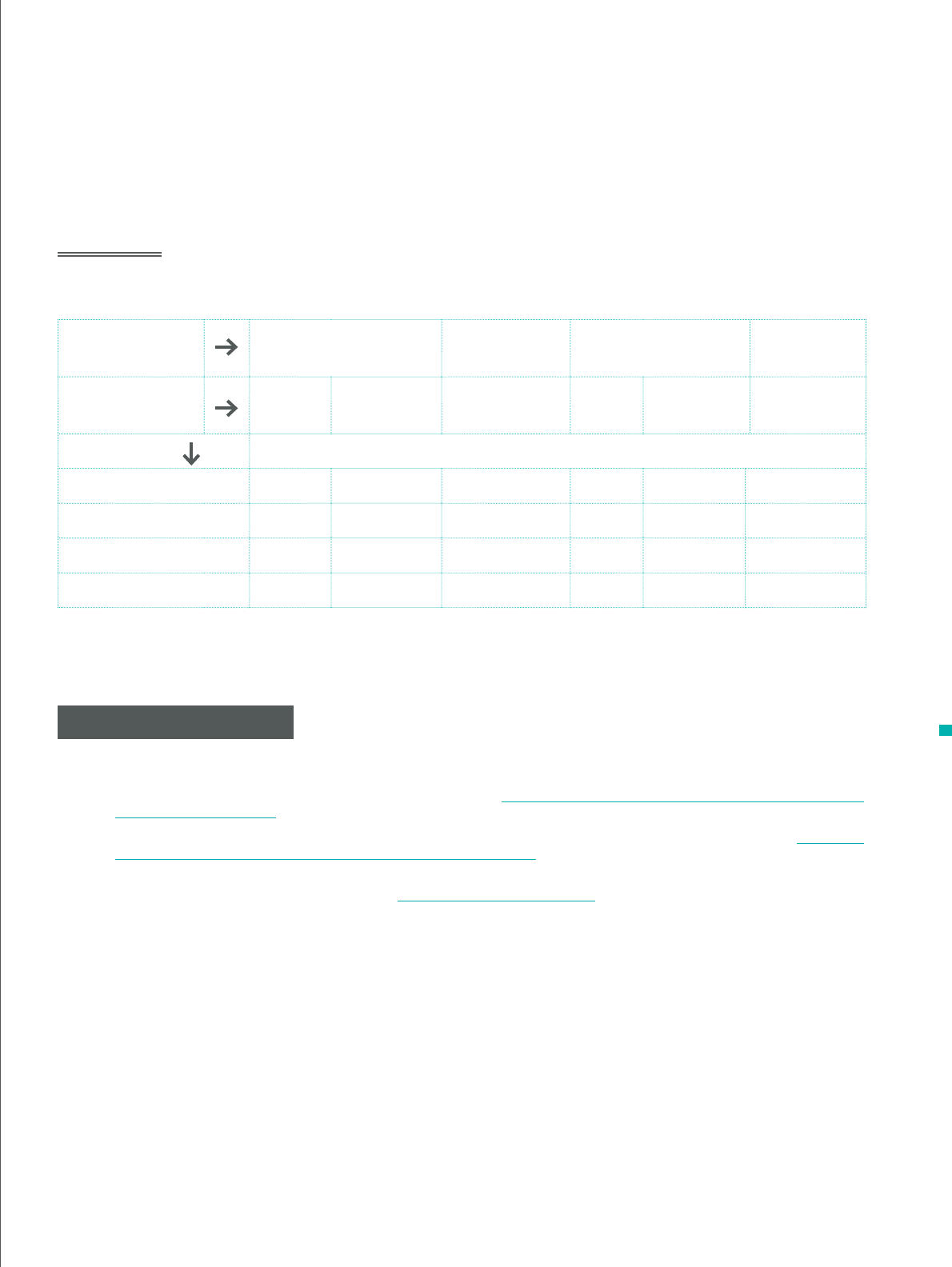
biodiversa stakeholder engagement handbook
69
Table 5.2 provides an example of how methods can
be selected for a project based on the level of engage-
ment required. Most projects will involve various levels
of engagement and more than one method for each
level of engagement required. Each stakeholder does
not have to be engaged in every activity at the level of
engagement they are associated with.
Table 5.2
Examples of stakeholders and methods, based on appropriate levels of engagement
3
Level of engage-
ment
Inform Consult Involve Collaborate
Method of
engagement
Website Newsletters Questionnaire
Work-
shop
One-to-one
meeting
Steering
Group
Stakeholders
Govt advisors
x x x x
Landowners
x x x x
Local Business
x x x
Media
x x x
n REFERENCES-
1 REVIT. 2007. Working Towards more Eective and Sustainable Browneld Revitalisation Policies: Stakeholder Engagement – A Tool-
kit. Torfaen County Borough Council, Torfaen, 38 pp. Available from: http://www.revit-nweurope.org/selfguidingtrail/27_Stakeholder_
engagement_a_toolkit-2.pdf [Accessed 11 April 2014].
2 INVOLVE. 2005. People and Participation: How to put citizens at the heart of decision-making. 61 pp. Available from: http://www.
involve.org.uk/wp-content/uploads/2011/03/People-and-Participation.pdf [Accessed 31 March 2014].
3 FORESTRY COMMISSION. 2011. Public Engagement in Forestry: a toolbox for public engagement in forest and woodland planning.
Forestry Commission, Edinburgh. Available from: http://www.forestry.gov.uk/toolbox [Accessed 31 March 2014].

biodiversa stakeholder engagement strategy
7070
› The engagement planning table
› Practicalities, feasibility and implementation
› The engagement table: share, adapt and update
›› Case studies
Plan how the stakeholder engagement ts within external agendas and policy
processes
Think about the expertise within the research team and plan accordingly
Be aware of local culture and custom
Be prepared to adapt
Planning the detail
of the engagement

biodiversa stakeholder engagement strategy
71
› The engagement planning table
› Practicalities, feasibility and implementation
› The engagement table: share, adapt and update
Part 6

biodiversa stakeholder engagement handbook
72
n PLANNING THE DETAIL OF THE ENGAGEMENT-
❝ To elaborate the engagement plan
and dene the activities ❞
Following Parts 1 to 5, you will have identied the
stakeholders, assessed the level of engagement,
suggested appropriate methods for engagement, and
proposed the role each stakeholder will play. Note
that the role, or roles, that the stakeholder will play
will partly determine when the engagement is likely to
occur.
It is now time to start eectively planning the engage-
ment process, and to consider the full list of activities
you intend to carry out
1
. At this stage, it is important to
take the following into consideration:
✴ Target your activities – it may be better to do less,
but to do it more eectively.
✴ Estimate likely costs (time and money) accurately,
and be realistic (don’t underestimate).
✴ Think about what expertise you have and plan
accordingly. Do you need to involve/employ exter-
nal experts, and if so, do you have the funds?
✴ Where choices have to be made, use high impact/
low cost methods and activities, and if necessary
concentrate on the most important and inuential
stakeholders.
✴ Try to make use of other pre-existing approaches
or activities where available and appropriate.
✴ Time your research, or some of its outputs, where
appropriate, to enable it to inform any relevant
external or policy processes.
✴ Take into account possible unexpected outcomes
(positive or negative).
0 CASE STUDY
PLAN HOW THE STAKEHOLDER ENGAGEMENT
FITS WITHIN EXTERNAL AGENDAS AND POLICY
PROCESSES
To increase the relevance of engagement activities for stakeholders and the likelihood
of the results having an impact, it is necessary to understand the wider context in which
the project ts. Understanding for example, the current policy context and how the
results will contribute to an evidence base that informs decision making will increase
the interest of stakeholders in the project. Results from a Dutch case study part of the
BiodivERsA CONNECT project provided an analysis of the social values held by the
general public for changes in and around a freshwater lake. A government-agency
partner in the project communicated the ndings for inclusion in a public consultation
about local planning and also used them to inform larger government programmes
about water resources and ecosystem services.

biodiversa stakeholder engagement handbook
73
0 CASE STUDIES
THINK ABOUT THE EXPERTISE WITHIN THE
RESEARCH TEAM AND PLAN ACCORDINGLY
Projects that have interdisciplinary research teams including social scientists are often
better equipped to design eective stakeholder engagement processes. Depending on
the extent and nature of the stakeholder engagement to be done, it may be worthwhile
including people with good facilitation experience on the research team to oversee the
engagement process. For example, if there is a high level of conict to be negotiated
during engagement, a professional facilitator may help achieve the best results and
avoid negative outcomes.
Researchers on the FP7 MOTIVE project (see Appendix 1) successfully engaged stake-
holders in the production of models for adaptive forest management by working from
stakeholder engagement guidelines produced by an experienced social scientist as
part of a dedicated work package on ‘stakeholder interactions and decision making’.
Each of the ten partner countries carried out stakeholder analyses and wrote engage-
ment plans based on the guidelines, without necessarily having a great deal of prior
experience in stakeholder engagement. The engagement aspects of the project were
monitored by the social scientist, who ensured that a broadly consistent approach was
maintained across countries.
Researchers from the FP7 HighARCS project, where there were several case study
communities in dierent Asian countries, recommended that a researcher that is work-
ing with stakeholders in multiple sites should plan regular shorter visits rather than
spending a single longer spell on site. This ensured that potential problems could
be identied early and that the researcher could be present for all key phases of the
research.
n THE ENGAGEMENT PLANNING TABLE
For the purposes of this Handbook, we have devel-
oped a ‘matrix’ (Table 6.1), which enables the
researcher to bring together information on the role(s)
the stakeholder will play, the timing of when engage-
ment activities take place, the method of engagement,
and the level of engagement to be adopted. Note that
stakeholders may, and often will, have multiple roles to
play throughout a project.
It is important to recognise that the level of engage-
ment depends partly on the method of engagement
being adopted as well as the stakeholder involved and
not every engagement activity needs to be at the level
of engagement identied for a particular stakeholder.
In some instances engagement may be more frequent
and conducted at a dierent level, particularly as the
role a stakeholder may play can vary throughout the
lifetime of the project. For example, a stakeholder may
fall into the ‘involve’ category, but this level of engage-
ment may only be necessary in the early stages of the
projects, whereas later on the same stakeholder may
only need to be involved with activities that ‘inform’.
It is important to ensure that the methods being
adopted are realistic and appropriate for delivering
the desired outcomes, and that the proposed timing
has been accepted by those who are planned to be
involved
2,3
. It should also be remembered that the
location, timing, number of meetings, and methods
employed can all have a great impact on the overall
results and outcomes.
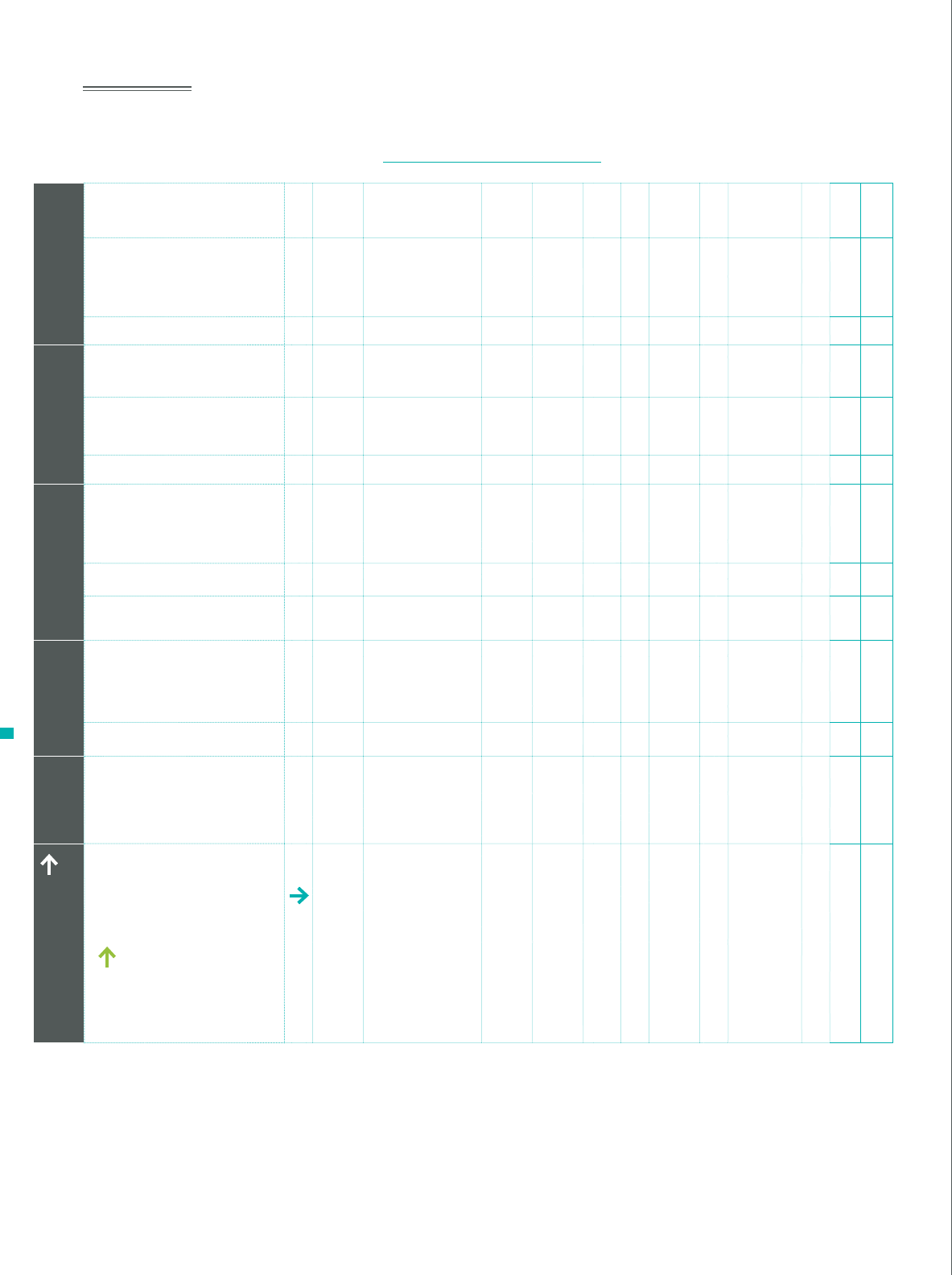
biodiversa stakeholder engagement handbook
74
Table 6.1.
Example of a matrix that can be used when planning activities for dierent levels of engagement. A template
of this matrix can be downloaded from http://www.biodiversa.org/577.
Notes: Project timescale (top row) indicates the most likely stage at which each method would be applied. However, this is
only a guide, as the timing may vary depending on the project. The methods can be colour-coded according to the ‘level’ of
engagement outlined in Parts 1 and 3 (Inform – most basic level of engagement; Consult – specic questions are asked but not
full discussion or interaction; Involve – more opportunity for discussion; Collaborate – involved to some extent in full decision
making).
Project Timescale Before Before/
During
During During/After After
Roles of Stakeholders/
Areas of and Level of
Inuence/ How Stake-
holders are Engaged
Research strategy/
Research questions/
Project Design
Networking
Advice/
Recommendations/
Project Revision
Prediction/ Modelling
Monitoring
Resource Provision by
Stakeholder (equipment,
data, money, contacts) –
Training
Implementation of Proj-
ect Finding
Data user/Recipient /
Beneciary
Feedback
Communication and
Dissemination of Results
to Stakeholders
Identifying Future
Research Questions
Stakeholders
Government policy
makers or advisers
National/international
policy makers/groups
(e.g. European institu-
tions, environment
agencies)
Non-governmental
organisations
Business / Private
Sector
General public
Local community
Users (e.g. practitio-
ners, data users)
Students
Interpreters (science
communicators, medi-
ators, facilitators)
Media
Landowners
Other

biodiversa stakeholder engagement handbook
75
n PRACTICALITIES, FEASIBILITY AND IMPLEMENTATION-
Before developing the matrix further, or sharing with
stakeholders, it is important to consider the practicali-
ties of the engagement being proposed to establish if
the plan is feasible. This should also involve a consid-
eration of the costs of the engagement, in terms of
both time and money, and will allow the researcher to
identify any constraints.
The following questions can help with considering
practicalities:
✴ Are the timeframes for each activity realistic, includ-
ing preparation and reviewing and analysis?
✴ Who will be responsible for the engagement – are
dierent people to be responsible for dierent
parts of it?
✴ How much sta time will be required? Is this time
available? What will it cost?
✴ What are the costs of using external expertise (if
desired/required)? What are the administrative
costs, including hiring venues, making phone calls,
provision of documents, etc.?
✴ Are stakeholders to be reimbursed for their time?
Are their expenses to be covered? Are there other
costs associated with communication and publish-
ing information, including recording and providing
feedback to stakeholders?
✴ How might the local culture or customs aect or
restrict the engagement process? What contin-
gencies need to be included in case engagement
needs to change during the process, and what
might dierent options mean to overall time-scales
and costs?
The responses to these questions may result in the
need to update the engagement table.
0 CASE STUDY
BE AWARE OF LOCAL CULTURE AND CUSTOM
This is an important consideration for any stakeholder engagement conducted in
countries where the researchers might be unfamiliar with some aspects of the culture.
In many countries for example, separate discussions must be held for men and women
of a community where it is not customary for women to speak in the presence of
men. Focus groups in the FP7 HighARCS project (see Appendix 1) were dierentiated
based on gender and age, to bring as many interests as possible into the research, as
in the communities studied it tended to be men or older people that would dominate
discussions.
Boys (aged 9-15) in Viet-
nam take part in a focus
group in the HighARCS
project to discuss their
involvement in family live-
lihoods.
©
Nguyen Phuong
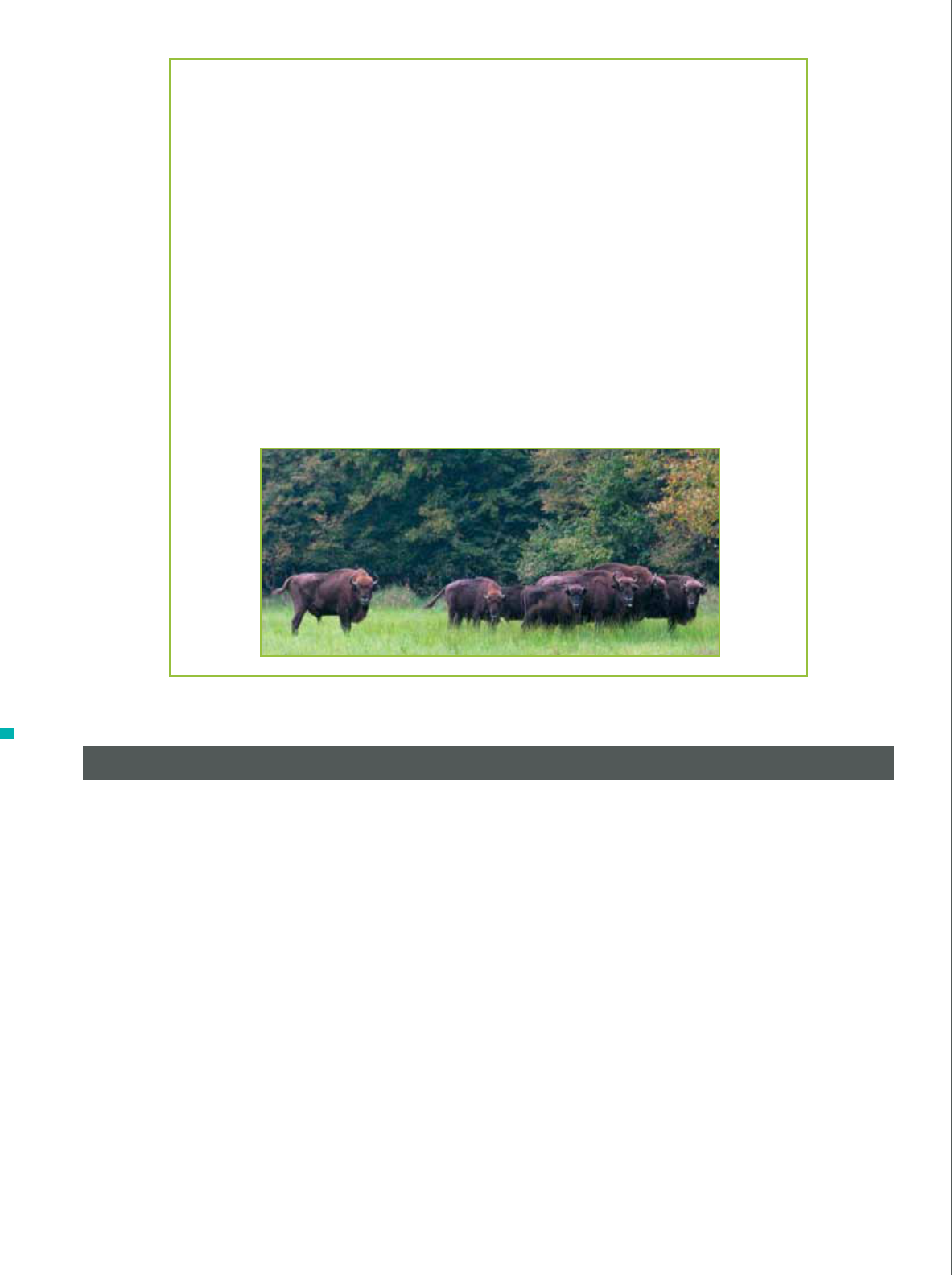
biodiversa stakeholder engagement handbook
76
n THE ENGAGEMENT TABLE: SHARE, ADAPT AND UPDATE-
Once the practicalities have been considered, and the
matrix has been revised where appropriate, it should
be shared with stakeholders and funders, to provide
them with some clarity over what will be undertaken,
and when. Stakeholders may also have dierent views
on their availability or have particular demands and
constraints. For example, stakeholders may:
✴ Request that the engagement they undertake is on
a one-to-one basis rather than in a group situation.
Prefer not to interact with other particular stake-
holder groups.
✴ Have diculty travelling to, or reaching the loca-
tion where the engagement is expected to take
place, and therefore prefer to engage by a dierent
method, perhaps remotely.
✴ Be unable to engage at the time proposed.
✴ May suggest that a dierent level, or method, of
engagement is more appropriate.
The matrix should remain a exible and adaptable
document, which can be amended and updated as
and when required.
0 CASE STUDY
BE AWARE OF LOCAL CULTURE AND CUSTOM
An awareness of dierent cultures was of direct relevance in the FP7 BESAFE project.
One of the aims of this project was to evaluate the eectiveness of dierent arguments
for biodiversity protection across a range of European geographical areas, conserva-
tion contexts and dierent social groups. In the rst stakeholder meeting for BESAFE,
the stakeholders themselves emphasised that dierent approaches and vocabulary
would be required for dierent stakeholder groups to understand their argumentation
processes. For example, in one case study about the management of Bialowieza forest
in Poland, there was conict between environmentalists, foresters and local residents
over the proposed expansion of Bialowieza National Park, where dierent groups used
dierent arguments and multiple governance levels were involved. Approaches for
engaging with each group were thus designed with an understanding of how culture
inuences arguments around biodiversity.
Bialowieza
forest -
BESAFE case
study area.
©
Grzegorz Mikusinski

biodiversa stakeholder engagement handbook
77
n REFERENCES-
1 ECONOMIC SOCIAL RESEARCH COUNCIL (ESRC). Undated. Impact toolkit. Available from: http://www.esrc.ac.uk/funding-and-
guidance/impact-toolkit/ [Accessed 29 November 2013].
2 AUSTRALIAN GOVERNMENT (DEPARTMENT OF IMMIGRATION AND CITIZENSHIP). 2008. Stakeholder Engagement: Practitioner Hand-
book. National Communications Branch of the Department of Immigration and Citizenship, Belconnen, Australia, 37 pp. Available from:
http://www.immi.gov.au/about/stakeholder-engagement/_pdf/stakeholder-engagement-practitioner-handbook.pdf [Accessed 11
April 2014].
3 GARDNER, J., DOWD, A.-M., MASON, C. and ASHWORTH, P. 2009. A Framework for Stakeholder Engagement on Climate Adapta-
tion. CSIRO Climate Adaptation Flagship Working Paper, No. 3, 32 pp. Available from: http://www.csiro.au/Organisation-Structure/
Flagships/Climate-Adaptation-Flagship/CAF-working-papers/CAF-working-paper-3.aspx [Accessed 23 April 2014].
0 CASE STUDY
BE PREPARED TO ADAPT
When planning stakeholder engagement activities, it is advisable to remain exible
in what engagement methods are used to ensure they remain t for purpose as the
project evolves. The FP7 HighARCS project used a range of approaches such as the
‘Delphi method’ (see practical methods notes in Part 5), focus groups and partic-
ipatory ranking, to work towards the formulation of integrated action plans for the
management of aquatic resources in three Asian countries. Researchers adapted their
engagement approach as they learnt more about the situation in each case study area
in terms of the local planning processes underway and the alliances and competition
between groups of stakeholders. A range of methods was needed to gain a good
understanding of the stakeholder dynamics in each area.
Another example of being adaptive from the HighARCS project was the ongoing evalu-
ation of the representation of stakeholder interests. For example, in one case it was
felt that the conservation of biodiversity interest was not adequately represented,
and eorts were made to bring new stakeholders into the processes. It is important
to build exibility into the research project so stakeholder engagement plans can be
reviewed and improved.

biodiversa stakeholder engagement strategy
78
› Conicts with and between stakeholders: types and causes
› Stakeholder perspectives on conict
› Analysing conict
› Conict management tools
› Constructing a conict timeline
›› Case studies
Managing conict
Managing
stakeholder
conict

biodiversa stakeholder engagement strategy
79
Part 7

biodiversa stakeholder engagement handbook
80
n MANAGING STAKEHOLDER CONFLICT-
❝ Identify the types of conict that can arise,
the dierent levels of conict and their root causes.
Understand how conicts can be analysed in order to guide
actions needed to nd long-term resolution. ❞
It is likely that at some time biodiversity research
teams will experience some level of conict. Conict
does not have to be negative; it is simply a part of
everyday interactions
1
. It can occur between individu-
als, between groups of individuals and between organ-
isations. A conict can be dened as a process that
begins when an individual or group(s) (representing a
particular party) feels negatively aected by another
party. Conict arises anytime when the actions of one
party obstruct or, in some way, make the performance
or another party less ecient
1
.
The level or type of conict may vary depending on
factors such as legal systems, political and institutional
frameworks, economies, societal structures, cultural
values, historic events, environmental conditions,
and knowledge. Conicts may involve two parties or
multiple parties and may arise as a result of multiple
factors. Because organisations act through individu-
als, conict can stem from key actors within the organ-
isation, and is often due to diering perceptions on an
issue which they are unable to agree upon
1
.
The initial perception of conict is often that it will
result in negative consequences for a project, but this
is not necessarily the case. Conict should be viewed
as both functional and dysfunctional. A functional
conict, when managed well, can lead to new ways of
thinking, innovative solutions and enhanced impact of
research
2
. Dysfunctional conict arises when conict-
ing opinions or needs result in negative discourse
between stakeholders, often causing relationships or
dialogue to break down.
A project team may nd that it has to analyse and
manage conict by using techniques to reduce or
resolve it
3,4
. When conict is likely to be an issue for
a research project, then having the right skills or train-
ing in the team or planning the involvement of profes-
sional councillors/brokers will be important.
The rst step to reducing or solving conicts is to
explain them as a problem that needs to be resolved.
The fundamental dierence being that, unlike a conict,
there should be less hostility between parties that are
working together to solve a problem. For eective
problem solving it is imperative that each party feels
they are contributing to the solution, rather than being
a part of a problem
1
.
n CONFLICTS WITH AND BETWEEN STAKEHOLDERS: TYPES
One of the simplest conict classication systems has
been put forward by Gordon
5
and distinguishes intra-
personal conicts (within the individual), inter-per
sonal (between individuals), intra-group (conict within
a restricted group), intra-organisational (within an
organisation), inter-group (between dierent groups)
AND CAUSES-

biodiversa stakeholder engagement handbook
81
and inter-organisational (between organisations).
Conicts can also be categorised in respect of their
typology
1
:
✴ Open conicts, where it is everyone’s knowledge.
✴ Hidden conicts, where it is only known by certain
people.
✴ Latent conicts, when the conict arises when
something occurs that changes the status quo.
In addition, conicts can also be dened as
6
:
✴ Well dened, if they have clearly dened boundar-
ies and constraints with clear solutions to the prob-
lem.
✴ Fuzzy or ill dened, if they have unclear objec-
tives, variables are unquantiable, values held by
the parties involved are not clearly dened, and it
is dicult to envisage a feasible solution.
The causes of conicts are numerous; Moura and
Teixeira
1
broadly dene the main causes of conict:
✴ Cognitive conicts result from diering assess-
ments of data or facts that result in involved parties
reaching dierent conclusions. Insucient data
and facts may have been made available, and such
conicts can often be resolved through additional
clarication of facts, or further studies to obtain
more reliable data.
✴ Conicts of objectives or interests often apply to
benets sharing, resource allocation or re-distribu-
tion, and nancing costs. These conicts are often
solved through conict management techniques.
✴ Normative conicts result from a divergence of
views about values, types of behaviour and norms.
Root causes of these conicts are usually ethical or
moral principles that are not negotiable.
✴ Conicts of relationships stem from the person-
ality or behaviour of stakeholder representatives
and can often be resolved through negotiation or
mediation via a third party.
✴ Conicts over objectives, needs or interest arise
when one party believes that their interests, needs
or objectives are at odds with those held by other
parties.
✴ Conicts over processes occur when parties
adopt dierent approaches to address the same
problem.
✴ Structural conicts often arise due to the way
in which society is structured in terms of cultural,
social, legal and economic arrangements, and the
relative position and power of stakeholders within
the social structure.
Conicts are dynamic in nature and may arise in one
stage of the project and evolve to the next. In general,
there are ve stages to every conict: initiation, esca-
lation, controlled maintenance, abatement, and nally
resolution or termination
1,7
.
n STAKEHOLDER PERSPECTIVES ON CONFLICT-
In order to understand reasons why certain stakehold-
ers may become embroiled in conict it is important to
understand their views. This type of information may
be gathered through interviews or workshops, perhaps
coupled with questionnaires. Poolman et al.
2
suggest
that careful design of questions, including assessment
of strength of feelings, can reveal:
✴ Levels of interest in the project and individual goals
or aspirations from the project;
✴ Current perceptions of how policies aect indi-
vidual stakeholders and what they would prefer to
happen in the future;

biodiversa stakeholder engagement handbook
82
✴ How stakeholders may view potential issues or
areas of conict;
✴ Why particular views are held (reasons for percep-
tions);
✴ Dierent roles stakeholders envisage for them-
selves within a project or activity;
✴ Interactions and power relations among stakehold-
ers, and an understanding of how they operate;
✴ The type of data, information, and knowledge that
stakeholders possess, or can gather, which is of
interest to the project team; and
✴ The degree to which stakeholder views and ideals
are compatible or divergent.
The identied stakeholder interests can be catego-
rised depending upon their perceptions of the project
and perceived goals (see Table 7.1). A stakeholder that
can be categorised as ‘dedicated’ is likely to defend
their interests, goals and perceptions. Stakeholders
that are deemed ‘critical’ are those who are likely to
have the power or means to facilitate or hinder the
projects objectives. Developing this type of matrix
makes it possible to ascertain potential stakeholder
reactions to a project. In some cases it may be neces-
sary to adjust the objectives of the project in order to
accommodate stakeholder goals and perceptions
2
.
Table 7.1
Matrix for categorising stakeholders into ‘High Dedication’ and ‘Lower Dedication’ (adapted from Poolman
et al.
2
). A template of this matrix can be downloaded from http://www.biodiversa.org/577
HIGH DEDICATION TO PROJECT
GOALS
LOWER DEDICATION
Critical to
project success
Non-critical Critical Non-critical
Similar
perceptions
on use of
project results
Stakeholders most
likely to participate
and become part-
ners.
Stakeholders most
likely to participate
and may possibly
become partners.
Valuable potential
partners who are
dicult to engage.
Stakeholders that
do not need to
become involved.
Opposite
perceptions
Potential blockers of
certain changes.
Potential critics of
certain changes.
Potential ‘blockers’
who will not become
immediately active.
Stakeholders who
do not require
initial attention.

biodiversa stakeholder engagement handbook
83
n ANALYSING CONFLICT-
Whether conicts are resolvable will depend on the
type of conict that exists and the factors that are
feeding the conict. It is important to assess stake-
holder activity and interactivity to identify where dier-
ences between stakeholders exists and detect where
conict could potentially arise
2
.
The FAO
8
state that conict analysis is an essential
element of a project as it helps to:
✴ Clarify and prioritise the issues to be addressed.
✴ Ascertain the impacts of the conict.
✴ Identify root causes and contributing factors of
conict, which can help determine eective actions
for resolution.
✴ Determine stakeholder motivations and incentives.
Gauge the nature of relationships amongst stake-
holders and their willingness and ability to interact.
✴ Collect existing information about the conict and
decide what further information is required.
✴ Assess the ability of existing institutions to manage
conict.
✴ Establish rapport with stakeholders; and help
develop problem solving and analytical skills of
stakeholders to address existing and future conict.
n SUMMARISED PROCESS FOR ASSESSING CONFLICT
There are numerous questions that can be posed to discover the types of conict that exist,
which stakeholders are involved, and what are the best opportunities to resolve the conict.
The following questions could help in analysis of conict (adapted from Poolman et al.
2
).
Identifying the conict:
✴ What conict(s) currently exist?
✴ What conicts may arise in the future?
✴ What are the possible reasons for the conict?
Once the conict has been identied:
✴ How did the conict arise?
o What issues or interests are of signicant concern?
o For how long has the conict been going on?
✴ Is there sucient information available about the issues (why/why not)?
✴ Who is involved with the conict?
o What are their interests in the conict?
o What kind of power do the dierent actors have?

biodiversa stakeholder engagement handbook
84
There is no single set of rules of procedures for
analysing conict, but generally speaking conict
analysis should
8
:
✴ Collect and understand a broad range of views
regarding the sources of conict.
✴ Separate opinion from fact, as balancing emotions
and reason is a vital element of resolving conicts.
It is not because facts are more important than
perceptions or emotions, but because stakehold-
ers deal with each in a dierent way.
✴ Examine the wider context (e.g. social, economic,
and political).
✴ Be reviewed and rened throughout the entire
process.
✴ Be undertaken in a participatory manner, as
exchanges of information will enable stakeholders
to focus upon the problems that are causing the
conict.
Keep in mind that the amount of information required
in conict analysis is highly case-specic. It is often
assumed that the more information gathered the
better. However, not all information will be useful so
it is important to identify what is worth knowing and
what will constitute a sucient amount of accurate
and reliable information to support resolution.
Conicts are often complex, and attempting to
manage them as isolated events may not be eective
if the conict is inuenced by wider issues. Building
consensus among stakeholders is dependent upon
engaging all involved parties; therefore it is critical to
correctly identify relevant stakeholders. Getting indi-
viduals or groups to resolve dierences may be dicult
if the parties do not recognise the need to manage or
settle a conict. It is also vital to nd out whether there
are parties that would benet from conict and would
therefore resist eorts aimed at resolving dierences.
When addressing conict it is important to consider
strategies that have already been applied, what were
the results, should the same strategy be applied
again
8
. Should an assessment of previously applied
o What are the historical relationships between conicting parties?
o Are the groups able to work together?
Why/why not?
How might it be possible to get groups to collaborate?
Possibilities for resolving or reducing conict:
✴ What kind of agreements could be tolerated by conicting parties?
✴ Can conict be resolved within the group without external assistance?
✴ Will parties from outside the conicting groups be tolerated?
o How could an outside party become involved in conict resolution?
o Who would be a suitable outside party?
✴ How will resolutions be made sustainable?
o Would a written agreement be sucient?
o What has been considered binding in previous conict resolutions?
o What happens if agreements are not honoured?
o Are there other optional solutions available?

biodiversa stakeholder engagement handbook
85
strategies reveal that these activities yielded unfavour-
able outcomes, or outcomes that are deemed not to t
with the desired objectives, then a new approach will
need to be adopted.
n CONFLICT MANAGEMENT TOOLS-
Three tools, which can be adapted for specic uses,
are presented in Appendix 1 based on the FAO nego-
tiation and mediation techniques for natural resource
management
8
. They can be used in two dierent ways:
as a way of structuring thoughts and dening ques-
tions; or as aids for facilitating discussions or group
sessions with stakeholders.
It is important to keep in mind that using particular
tools in certain situations could create, or worsen,
conict and it may be more appropriate to apply tools
with dierent groups of stakeholders separately.
n CONSTRUCTING A CONFLICT TIMELINE-
In some instances it may be helpful for the project
team to construct a conict timeline in order to better
understand the historical events that took place lead-
ing up to the conict. This may also help clarify the
situation and how it arose.
n PRACTICAL WAYS TO DEVELOP A CONFLICT TIMELINE
✴ Invite the stakeholder group to begin narrating the story of how the conict has devel-
oped, going back to the earliest point that the group is able to remember.
✴ As the group narrates the story a member of the team should begin structuring the ow of
information and setting out the sequence of events and noting down the various conicts.
✴ The project team should then request the information be veried to ensure all details of
the narrative have been fully understood and recorded correctly.
✴ Based upon the information obtained via the narrative write down the dierent conicts
under separate headings.
✴ Under each heading insert a column for dates and a column for events.
✴ Ask participants to identify the events that lead to the conict and the dates they occurred.
✴ Repeat this process and gather relevant details for all of the events that took place either
post or prior to those events that have been disclosed via the initial narrative (it does not
matter if they are listed in chronological order at this stage).
✴ Once participants feel they have disclosed all events, verify the information and dates.

biodiversa stakeholder engagement handbook
86
In order to eectively deal with conict it is impera-
tive that projects conduct clear and relevant science
and ensure that when the team is communicating with
stakeholders, the cost, time, risks and uncertainty
are considered and dealt with appropriately, and that
stakeholder expectations are taken into account and
managed accordingly
9
. It is important to remember
that conicts are between people, and the issues may
need to be viewed from a social science perspective.
The project team must fully appreciate the dynam-
ics of the conict and decide whether it is appropri-
ate to become involved in conict resolution activities
or not, if engaging is deemed appropriate the team
must decide the role they wish to play (e.g. information
provider, mediator)
9
.
When managing conict, the project team must keep
in mind that scientists may be viewed as stakehold-
ers and, in some instances, possessing certain biases.
Therefore, the project team must be able to appreci-
ate and consider a wide variety of views and interests,
maintain objectivity, and remain patient when seeking
to achieve conict resolution
9
.
Two-way engagement, or maintaining a dialogue, is
key for the management of conict, in order to discuss
and negotiate a resolution
10
. In particular, an engage-
ment process that involves conict must have trans-
parency at its core
11
making it clear the positions of the
stakeholders (including the researchers), their goals
12
,
available evidence and uncertainties
10
. Engagement
processes must be designed to include all relevant
stakeholders in a way that they can discuss issues
on equal footing and make decisions based on good
information. Such processes will have to pay particu-
lar attention to the hierarchy of power of stakehold-
ers and the way group interactions or dynamics are
managed.
✴ When participants are happy with the time line, initiate a group discussion. You may
consider using the following types of questions:
o What has been learned through the exercise?
o Which events have had the most impact on the conict and why?
o How have events impacted upon relationships between stakeholders?
o Why have some parties behaved in a certain way?
o What were the interests, issues or needs of the parties aected by these
events?

biodiversa stakeholder engagement handbook
87
0 CASE STUDY
MANAGING CONFLICT
MEASURES TO REDUCE CONFLICT
Experiences from case studies indicate that relatively simple measures can be taken
to reduce conict. Creating an atmosphere of trust is fundamental and ensuring that
all participants feel they have the opportunity to contribute their views reduces tension,
allowing discussion and negotiation to begin from a positive starting point.
The BiodivERsA Ecocycles project (see Appendix 1) conducted research on the factors
inuencing rodent outbreaks in dierent European sites including an agricultural land
in Northern Spain. Outbreaks result in crop damage and pose a risk to human health,
and there was an established conict between stakeholders about how outbreaks
should be managed, due to use of poisons by farmers having a detrimental eect on
biodiversity. The project was successful in turning confrontations into a more rational
approach to management through sustained dialogue and information provision that
culminated in the agreement of a management protocol (although it should be noted
that there has been a re-emergence of conict over this issue at the time of publica-
tion). The following elements contributed to the success of the project:
✴ At the rst meeting each stakeholder was given an allocated time to state their posi-
tion on the subject. The notes were then circulated to the stakeholders for comment
after the meeting, therefore the formulation of the problem was shared.
✴ The researchers were very open and transparent about the evidence they had and
where there were uncertainties and knowledge gaps. Stakeholder relations were
improved when the problem was presented and discussed as a shared one to be
solved by contributions from all parties.
✴ The researcher facilitating the discussions within the national consultative forum was
not known to the stakeholders prior to the project and was viewed as an ‘outsider’
to the conict, which was helpful for diusing inter-stakeholder tensions.
Vole outbreaks can cause considerable damage to agricultural land, as shown in the image on the right.
©
Leticia Arroyo
©
Leticia Arroyo

biodiversa stakeholder engagement handbook
88
0 CASE STUDIES
MANAGING CONFLICT
CREATING TRUST
A case study within the FP7 HUNT project researched the driving forces of bush meat
consumption in Africa, where there is conict between conservation objectives and
local livelihood priorities. Researchers who engaged local communities in research
about this sensitive issue emphasised the importance of building trust and transpar-
ency. In this case, it was necessary to work alongside local people who acted as facili-
tators. These individuals were trusted, well known by communities and viewed as rela-
tively neutral which helped create trust towards the research amongst communities.
Without local connections, there is a danger that researchers can be viewed as being
part of a government or conservation agenda and treated with mistrust, especially if
there is a language barrier.
ALLOW VOICES TO BE HEARD
In the FP5 BIOSCENE project, stakeholders with very divergent and often strong views
on issues about sustainable development, farming and countryside management in
mountain areas were sought to participate in a series of workshops focusing on the
development and sustainability appraisal of future scenarios. Semi-structured inter-
views were held to allow stakeholders to fully express their views prior to the scenario
workshops.
COMPLEX METHODS CAN EXACERBATE PROBLEMS
A stakeholder on the HUNT project Scotland case study expressed the value of simply
bringing stakeholders together in a non-threatening atmosphere to talk about the
issues underlying conicts surrounding game management during the national consul-
tative forums that guided the research and during international conferences. Discus-
sion of common challenges between countries was viewed as a constructive experi-
ence. However, there was also a warning about the use of certain research methods
to address complex issues, such as deer management and competing land uses in
upland Scotland. The researchers used scenario analysis and multi-criteria analysis
(see method guide in Part 5 of this Handbook) to explore these issues and it was felt
by some stakeholders that these methods were overly complex and academic and
failed to lead to improved understanding of the issues, or nd a route towards conict
resolution, for the stakeholders.
Grouse shooting,
one of the upland
hunting activities
investigated in the
HUNT project.
©
Nils Bunnefeld

biodiversa stakeholder engagement handbook
89
n REFERENCES-
1 MOURA, H. M. and TEIXEIRA, J. C. 2010. Managing Stakeholders Conicts. In: Construction Stakeholder Management, CHINYIO,
E. and OLOMOLAIYE, P. (Eds). Wiley-Blackwell, Oxford, UK. 286-316. Available from: at: http://repositorium.sdum.uminho.pt/
bitstream/1822/17572/1/Managing%20Stakeholder’s%20Conicts.pdf [Accessed 22 November 2013].
2 POOLMAN, M., MUNAMATI, M. and SENZANJE, A. 2009. Stakeholder and Conict Analysis, in Small Reservoirs Toolkit. In:
ANDREINI, M., SCHUETZ, T. and HARRINGTON, L. (Eds), Small Reservoirs Project. Available from: http://www.smallreservoirs.org/
full/toolkit/docs/I%2002%20Stakeholder%20and%20Conict%20Analysis_MLA.pdf [Accessed 5 November 2013].
3 ORLANDO, Y. 1993. The role of conict resolution in integrated catchment management: A case study in the Lockyer Creek catch-
ment. Proceedings of the Australia-Pacic Extension Conference, Gold Coast, Australia. 12-14 October, 2, 367-370.
4 ALLEN, W.J. 2001. Working Together for Environmental Management: the role of information sharing and collaborative learning
[online] PhD dissertation, Massey University. Available from: http://learningforsustainability.net/research/thesis/thesis_ch7.html
[Accessed 21 November 2013].
5 GORDON, J.R. 1996. Organizational Behaviour: A Diagnostic Approach (5
th
Edition). Prentice Hall, New Jersey, USA.
6 RIJSBERMAN, F. 1999. Conict management and consensus building for integrated coastal management in Latin America and the
Caribbean. Resource Aalysis Report for Inter-American Development Bank, Delft, Nederland. Available from: http://www.mungo.nl/
Con_ADB_ENV-132E.pdf [Accessed 19 November].
7 GROTON, J.P. 1997. Alternative dispute resolution in the construction industry. Dispute Resolution Journal, 52 (3), 49–57.
8 FOOD AND AGRICULTURE ORGANIZATION OF THE UNITED NATIONS (FAO), 2005. Negotiation and Mediation Techniques for
Natural Resource Management. Rome, Italy. Available from: ftp://ftp.fao.org/docrep/fao/008/A0032E/a0032e00.pdf [Accessed 27
November 2013].
9 REDPATH, S., 2010. Managing Conservation Conicts. PowerPoint Presentation. Aberdeen: Aberdeen Centre for Environmental
Sustainability, University of Aberdeen. Available from: http://www.pik-potsdam.de/news/public-events/archiv/alter-net/former-
ss/2010/10.10.2010/redpath/presentation_redpath_10.pdf [Accessed 6 December 2013].
10 REDPATH, S., YOUNG, J., EVELY, A., ADAMS, W.M., SUTHERLAND, W.J., WHITEHOUSE, A., AMAR, A., LAMBERT, R.A., LINNELL,
J.D.C., WATT, A. and GUTIERREZ, R.J. 2012 Understanding and managing conservation conicts. Trends in Ecology and Evolu-
tion, 28 (2), 100-109. Available from: http://www.sciencedirect.com/science/article/pii/S0169534712002169 [Accessed 6 December
2013].
11 ADAMS, W.M., BROCKINGTON, D., DYSON, J., and VIRA, B. 2003. Managing tragedies: understanding conict over common pool
resources. Science, 302, 1915–1916.
12 SALAFSKY, N. 2011. Integrating development with conservation: a means to a conservation end, or a mean end to conserva-
tion? Biological Conservation, 144, 973–978. Available at: http://www.sciencedirect.com/science/article/pii/S0006320710002697
[Accessed 23 March 2014].

biodiversa stakeholder engagement strategy
90
› Benets of evaluation
› What to evaluate?
› When to evaluate?
› Stages of evaluation
›› Case studies
Evaluation of the engagement process
Post project monitoring
Monitoring and
evaluating the
engagement

biodiversa stakeholder engagement strategy
91
Part 8

biodiversa stakeholder engagement handbook
92
n MONITORING AND EVALUATING THE ENGAGEMENT-
❝ Monitor and review the engagement throughout
the process, and evaluate both the outcomes and
the process of the engagement to consider
whether or not it has been successful.❞
Assessing the eectiveness of the engagement under-
taken and learning from the experience for the future
is very important
1
. For example, evaluation might be
used to provide evidence of value for money to the
research funders
2
, evidence of value for the research
process and research outputs, or it could be used
to demonstrate to stakeholders how their participa-
tion has been used. Therefore, some form of moni-
toring and evaluation is a necessary important part of
the engagement process and should be considered
from the outset, in the planning stages
3
. Time should
also be taken throughout the engagement process to
reect on what has (or perhaps has not) proven eec-
tive.
Rather like the whole engagement process, there is
no single, or simple, way, of evaluating stakeholder
engagement. The purpose of the evaluation can
help determine the evaluation design – in the same
way as the purpose of the engagement determines
the project design and methods of engagement
1
.
Ideally, indicators for evaluation should be agreed with
stakeholders (especially in projects with high levels
of engagement or in projects with conict) reecting
recognizable, achievable, describable, tangible, and
relevant results
4,5
. The approach taken to evaluation
of engagement largely depends on whether it is the
eectiveness of the engagement process that is to be
evaluated or the outcomes and impact of engagement
process. It is therefore important to consider how the
results of the evaluation are to be used and applied
6
.
Broadly speaking, there are two types of evaluation
1
:
✴ Summative evaluation tends to be used
where there is a need for accountability, for
example for audit purposes, or to demonstrate to
stakeholders how their contributions to the engage
ment process have been adopted. Therefore,
data will need to be collected to demonstrate that
specic targets have been met and a range of
statistical methods may need to be employed to
undertake this. This data collection may have to
be undertaken at a later stage, as some outcomes
may take some time to achieve
7
. Summative
approaches, however, can have limited capacity
to understand the often uid and dynamic nature
of engagement, because they focus more on the
outcomes rather than the processes that led to
them
5
).
✴ Formative evaluation may be designed to enable
researchers and stakeholders to learn from the
engagement process, so they can do better
engagement in future research. Formative evalu-
ation may be embedded in activities throughout
the research cycle (e.g. Bowen and Martens
8,9
),
enabling projects to adapt to feedback to enhance
engagement during the course of the research
10-12
.
Formative evaluation may be participatory, using
more qualitative methods, such as interviews,
focus groups and observation, to describe and
illustrate why and how the engagement process
did, or did not, work.

biodiversa stakeholder engagement handbook
93
n BENEFITS OF EVALUATION-
There are a number of benets to evaluating engage-
ment
2
, which include:
✴ If evaluation is done from the very start of the proj-
ect it can help with planning engagement. It helps
researchers focus on what needs to be achieved,
how to go about achieving objectives, and how to
measure success. Therefore, evaluation can help
in dening aims and outcomes more clearly.
✴ Evaluation throughout the process provides an
opportunity to reect on the adopted approach
and to make changes and improvements where
necessary.
✴ Evaluation provides evidence, which can be used
to prove the value and benets of the activity, and
to provide a record of achievements. It can also
demonstrate value for money.
✴ Evaluation can be used to demonstrate to stake-
holders where their participation has contributed to
the project.
✴ Evaluation allows you to consider what has worked
well and can therefore be used to help inform future
engagement activities.
If evaluation is undertaken well it can improve the
engagement process and will enable the project team
to understand more about the impact of the project
13,14
.
n WHAT TO EVALUATE?-
The evaluation process often considers three
areas
2,13,15
:
1. The success of the engagement. For example,
have the aims and objectives of the engage-
ment process been met?
2. The process of engagement. Were the meth-
ods selected appropriate? Were the costs
reasonable? What worked well and less well,
and why? What lessons could be learned for
future engagement processes?
3. What impact has the process had (on the
stakeholders and also on the research)? Have
there been any unexpected outcomes?
As well as considering the impacts, the outcomes
and the process, it is also important to consider if the
engagement fullled the aims of the stakeholders
16,17
,
and to take into account their views on the engage-
ment process and its outcomes.
n WHEN TO EVALUATE?-
Evaluation needs to be considered in the planning
stages and the nal process needs to consider all
aspects of the engagement process, from planning,
through to undertaking the engagement and consider-
ing the outcomes. An evaluation table can be drawn
up to consider the evaluation process at dierent
stages (see Table 8.1).
1
2
3

biodiversa stakeholder engagement handbook
94
Table 8.1
A simple stakeholder engagement evaluation table (available to download from the BiodivERsA website)
WHAT DO YOU WANT TO
KNOW?
WHAT EVALUATION METHODS
WILL YOU USE?
HOW WILL THE EVALUATION
BE CONDUCTED?
PLANNING
PROCESS
ENGAGEMENT
BENEFITS/
OUTCOMES
n STAGES OF EVALUATION-
n STAGE 1: FROM THE OUTSET
Evaluation plays an important role right from the start
of a project. By considering the process of evaluation
early on you can ensure that the evaluation is based
upon the aims and desired outcomes of the project
and the engagement process
16,18
. It may be that by
considering evaluation at the outset your outcomes
become more rened, making them more measure-
able and achievable
1,13,15
.
In addition, it may be necessary to collect some
baseline data before the engagement begins in order
to have data to compare against. This is particularly
important if you want to see if there is a change in the
state of aairs following the engagement
13,19
.
n STAGE 2: THROUGHOUT THE PROCESS – ON-GOING EVALUATION
Engagement activities should be monitored and
reviewed throughout the process to ensure the
engagement is t for purpose, and to enable changes
to be made where appropriate or necessary
20
. This
is particularly important if any aspects of the project
or engagement process have changed – perhaps
because of the outcomes of some engagement activi-
ties. If changes need to be made, it is necessary to
understand why things are working, or not
13
.
Methods such as attendance forms, feedback forms
or evaluation discussions can be used to help identify
where improvements might need to be made to the
process as you undertake the engagement. Establish-
ing whether the engagement is going as planned
needs to include all those involved in the process,
including the stakeholders
17
. This monitoring process
may be particularly useful when rst engaging di-
cult-to-reach or new stakeholders and may be of
particular use when things are not going as planned
or expected
15
.
It is also important to maintain contact and to give
feedback to stakeholders when not engaging with
them, especially in projects which have long time-
scales. This enables the stakeholder to continue to
feel involved in the process, and helps to keep them
informed and updated
19
. Participation of stakeholders
in the engagement process may also enhance owner-
ship and responsibility for the process of engagement,
facilitating further discussions that can improve the
nal project impact and build social relationships
5
.

biodiversa stakeholder engagement handbook
95
n STAGE 3: FINAL EVALUATION
The nal evaluation should consider not only whether
the engagement has fullled its aims and objectives,
but also whether the process of engagement was
appropriate and t for purpose. In addition, it is impor-
tant to ensure that stakeholders are able to identify
where their input through the engagement process has
been employed. It is both good practice and common
courtesy to follow up with the stakeholders who were
involved, to advise them of the outcomes and any
proposed next steps
1,21
. This feedback might include
information on what has happened to their input, and
what dierence it has made.
An important factor to consider in the evaluation of
engagement processes is that it may sometimes
take a long time before the outcomes are achieved,
perhaps some time after the culmination of the proj-
ect. Therefore the conclusions about the success of a
particular engagement exercise may need to be revis-
ited at a later date.
n EVALUATING THE PROCESS
In evaluating the process, it is necessary to consider
whether
16,17
:
✴ Levels of participation were considered appropri-
ate for the stakeholders;
✴ Methods were appropriate, and successful;
✴ Costs were reasonable.
The following questions can help rene evaluation of
the process
15
:
✴ What methods can be used to determine the eec-
tiveness of the engagement?
✴ Will/should stakeholders be involved in the assess-
ment?
✴ Are there other stakeholders that might be appro-
priate for the assessment process?
✴ What value are stakeholders likely to place on the
assessment?
There are many methods for capturing information
on the eectiveness of engagement, from assess-
ment of willingness to engage, to feedback forms, to
interviews or meetings designed specically to test
perceptions. In some projects it might be worthwhile
including a range of formal methods to ensure that the
outcomes can be adequately analysed. For example,
projects with potential for conict might require more
opportunities for assessment and evaluation.
0 CASE STUDY
EVALUATION OF THE ENGAGEMENT PROCESS
In the FP7 MOTIVE project, researchers were asked by the project evaluation commit-
tee whether and how the stakeholder engagement had increased the likelihood of
stakeholders using the adaptive forestry models produced in the project. Thus, an
evaluation of stakeholder engagement was carried out in each case study country with
questions under the following themes to allow researchers to reect on the process.
The evaluation was done late in the project and the researcher emphasised that greater
benet would have been gained from asking such questions early and throughout the
project.
✴ Level of engagement and representation (e.g. has the level of participation and
commitment of stakeholders changed throughout the project?)

biodiversa stakeholder engagement handbook
96
n EVALUATING THE OUTCOMES
When evaluating the outcomes and impact of the
engagement process it is important to consider the
aims and objectives of the engagement and to develop
indicators and measures that can be used to evaluate
and demonstrate outcomes. An evaluation table can
be used to help consider the information required
1,13
.
GOALS/ PURPOSE POSSIBLE INDICATORS HOW TO OBTAIN DATA IMPORTANT ASSUMPTIONS
To better inform
stakeholders and
the general public
Increased understanding
and awareness
Questionnaires and
interviews with partici-
pants before and after
the process
That both the awareness,
and willingness to engage,
are as a result of the engage-
ment activity, rather than any
other factors
Willingness to participate
in the future
Questionnaires and
interviews after the
process, and follow-up
interviews at a later
date
✴ Engagement aims and methods (e.g. was the role of stakeholders clearly dened
and a common purpose for the project agreed and understood?)
✴ Uptake and use of project outputs (e.g. do we know where/when/how the models
or tools, or their outputs, will be used by stakeholders?)
✴ Learning and collaboration (e.g. has engagement allowed stakeholders to better
understand the perspectives of others, or helped with consensus-building?)
✴ Inuence and decision making (e.g. how will use, uptake, value to the sector (i.e.
fullling a business need), ‘tness for purpose’, usability, etc., be monitored?)
Table 8.2
Example of a table for evaluating outcomes (adapted from Warburton et al.
1
). A template for of this table can
be downloaded from http://www.biodiversa.org/577
Dierent research teams may use slightly dierent
tables (e.g. RCUK
13
) in this stage of evaluation; these
are all equally valid in helping develop the thinking
required to evaluate the outcomes of the engage-
ment
13
.
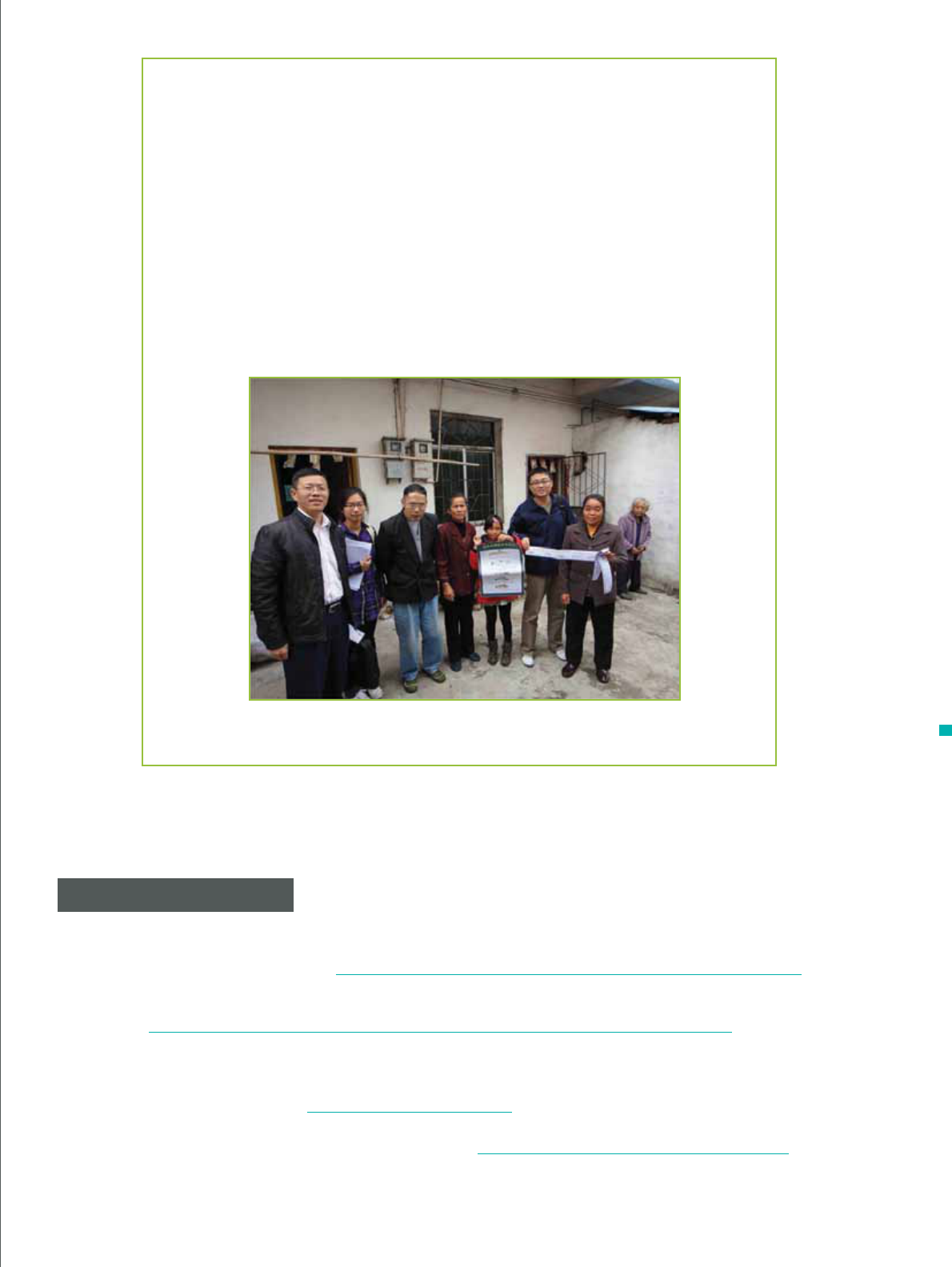
biodiversa stakeholder engagement handbook
97
0 CASE STUDY
POST PROJECT MONITORING
Where a specic output or tool is produced by a project for future use by stakehold-
ers it is important to put in place mechanisms to monitor its use beyond the end of
the research project. The FP7 HighARCS project produced integrated action plans for
each case study area and has monitored their implementation since the end of the
project. Certain aspects have successfully been taken forward while others have not.
In poor communities with few resources, such as those in HighARCS, it is necessary
to secure continuing support for implementation from higher level institutions. Find-
ing means of securing the legacy of biodiversity research should be a consideration
throughout the life of projects.
Stakeholders from a shing village in China with resources used to promote
participation in the protection of local sheries in the HighARCS project.
©
Professor Shimming
n REFERENCES-
1 WARBURTON, D., WILSON, R. and RAINBOW, E. Undated. Making a Dierence: A guide to evaluating public participation in central
government. INVOLVE. Available from: http://www.involve.org.uk/wp-content/uploads/2011/03/Making-a-Dierence-.pdf [Accessed
29 November 2013].
2 DUNCAN, S. and SPICER, S. 2010. The Engaging Researcher. Careers Research and Advisory Centre (CRAC) Limited. Available
from: http://old.certh.gr/libles/pdf/MOBIL-110-ENGAGING-RESEARCHER-by-DUNCAN-PP-20-Y-2010.pdf [Accessed 29 Novem-
ber 2013].
3 FISH, R., BURGESS, J., CHILVERS, J., FOOTITT, A., HAINES-YOUNG, R., RUSSEL, D. and WINTER, D.M. 2011. Participatory and
Deliberative Techniques to Embed an Ecosystems Approach into Decision Making: An introductory guide. (Defra Project Code:
NR0124), 107 pp. Available from: https://ueaeprints.uea.ac.uk/38121/ [Accessed 31 March 2014].
4 DIXON, J. and SINDALL, C. 1994. Applying Logics of Challenge to the Evaluation of Community Development in Health Promotion.
Health Promotion International, 9 (4), 297–309. Available from: http://heapro.oxfordjournals.org/content/9/4/297.short [Accessed 9
June 2014].
5 FAZEY, I., EVERLY, A.C., REED, M.R., STRINGER, L.C., KRUIJSEN, J.H.J., WHITE, P.C.L., NEWSHAW, A., LIN, J., CORTAZZI, M.,

biodiversa stakeholder engagement handbook
98
PHILLIPSON, J., BLACKSTOCK, K.L., ENTWISTLE, N., SHEATE, W.R., ARMSTRONG, F., BLACKMORE, C., FAZEY, J.A., INGRAM,
J., GREGSON, J., LOWE, P., MORTON, S. and TREVITT, C. in press. Knowledge Exchange: a review and research agenda for
environmental management. Environmental Conservation. Available from: http://www.esrc.ac.uk/my-esrc/grants/RES-240-25-0012/
outputs/Download/8bd5e33f-6803-4fa4-88f4-681f41c30331 [Accessed 23 March 2014].
6 ACCOUNTABILITY, UNITED NATIONS ENVIRONMENT PROGRAMME, and STAKEHOLDER RESEARCH ASSOCIATES. 2005. The
Stakeholder Engagement Manual: Volume 2: The Practitioner’s Handbook on Stakeholder Engagement. Beacon Press, Boston, 156
pp. Available from: http://www.accountability.org/images/content/2/0/208.pdf [Accessed 11 April 2014].
7 MCWILLIAM, C.L., COLEMAN, S., MELITO, C., SWEETLAND, D., SAIDAK, J., SMIT, J., THOMPSON, T. and MILAK, G. 2003. Build-
ing Empowering Partnerships for Interprofessional Care. Journal of Interprofessional Care, 17 (4), 363–375.
8 BOWEN, S. and MARTENS, P.J. 2006. A Model for Collaborative Evaluation of University–Community Partnerships. Journal of Epide-
miology and Community Health, 60, 902–7. Available from: http://www.ncbi.nlm.nih.gov/pmc/articles/PMC2566062/ [Accessed 23
March 2014].
9 BOWEN, S. and MARTENS, P.J. 2005. The Need to Know Team. Demystifying Knowledge Translation. Learning from the Community.
Journal of Health Research and Policy, 10(4), 203–11. Available from: http://www.ncbi.nlm.nih.gov/pubmed/16259686 [Accessed 23
March 2014].
10 SALAFSKY, N., MARGOLUIS, R. and REDFORD, K.H. 2001. Adaptive Management: a tool for conservation practitioners. Biodiversity
Support Program, Washington DC. Available from: http://www.fosonline.org/wordpress/wp-content/uploads/2010/06/AdaptiveMan-
agementTool.pdf [Accessed 23 March 2014].
11 ALLAN, C. and STANKEY, G.H. 2009. Adaptive Environmental Management: A practitioners Guide. CSIRO Publishing, Collingwood,
Australia.
12 ROUX, D.J., STIRZAKER, R.J., BREEN, C.M., LEFROY, E.C. and CRESSWELL, H.P. 2010. Framework for participative reection on
the accomplishment of transdisciplinary research programs. Environmental Science & Policy, 13, 733–741. Available from: http://
www.researchgate.net/publication/251677741_Framework_for_participative_reection_on_the_accomplishment_of_transdisci-
plinary_research_programs [Accessed 9 June 2014].
13 RESEARCH COUNCILS UK (RCUK). 2011. Evaluation: Practical Guidelines. A Guide for Evaluating Public Engagement Activities.
RCUK. Available from: http://www.rcuk.ac.uk/RCUK-prod/assets/documents/publications/evaluationguide.pdf [Accessed 31 March
2014].
14 LIVING WITH ENVIRONMENTAL CHANGE (LWEC). 2012. LWEC Knowledge Exchange Guidelines. Available from: http://www.lwec.
org.uk/ke-guidelines [Accessed 29 November 2013].
15 FORESTRY COMMISSION. 2011. Public Engagement in Forestry: a toolbox for public engagement in forest and woodland planning.
Forestry Commission, Edinburgh. Available from: http://www.forestry.gov.uk/toolbox [Accessed 5 April 2013].
16 INVOLVE. 2005. People and Participation: How to put citizens at the heart of decision-making. 61 pp. Available from: http://www.
involve.org.uk/wp-content/uploads/2011/03/People-and-Participation.pdf [Accessed 31 March 2014].
17 REVIT. 2007. Working Towards more Eective and Sustainable Browneld Revitalisation Policies: Stakeholder Engagement – A Tool-
kit. Torfaen County Borough Council, Torfaen, 38 pp. Available from: http://www.revit-nweurope.org/selfguidingtrail/27_Stakeholder_
engagement_a_toolkit-2.pdf [Accessed 11 April 2014].
18 ECONOMIC AND SOCIAL RESEARCH COUNCILS (ESRC). Undated. Impact toolkit. Available from: http://www.esrc.ac.uk/funding-
and-guidance/impact-toolkit/ [Accessed 29 November 2013].
19 GARDNER, J., DOWD, A.-M., MASON, C. and ASHWORTH, P. 2009. A Framework for Stakeholder Engagement on Climate Adapta-
tion. CSIRO Climate Adaptation Flagship Working Paper, No. 3, 32 pp. Available from: http://csiro.au/~/Media/CSIROau/Flagships/
Climate%20Adaptation/CAF_WorkingPaper03_pdf%20Standard.pdf [Accessed 6 December 2013].
20 LARSON, S. and WILLIAMS, L.J. 2009. Monitoring the success of stakeholder engagement: Literature review. In MEASHAM, T.G.
and BRAKE, L. (Eds), People, Communities and Economies of the Lake Eyre Basin, DKCRC Research Report 45. Desert Knowledge
Cooperative Research Centre, Alice Springs, Australia, 251–298. Available from: http://www.nintione.com.au/resource/DKCRC-
Report-45_Ch7_Monitoring-the-success-of-stakeholder-engagement-Literature-review_Larson-and-Williams.pdf [Accessed 23
March 2014].
21 INTERNATIONAL FINANCE CORPORATION (IFC). 2007. Stakeholder Engagement: A good practice handbook for companies doing
business in emerging markets. 201 pp. Available from: http://www.ifc.org/wps/wcm/connect/topics_ext_content/ifc_external_corpo-
rate_site/ifc+sustainability/publications/publications_handbook_stakeholderengagement__wci__1319577185063 [Accessed 11
March 2014].

99

biodiversa stakeholder engagement handbook
100
n AIMS
The aims of the stakeholder engagement case stud-
ies are to provide illustrative examples of stakeholder
engagement in practice in biodiversity research and to
draw on the methods used in these studies to design
a set of guides about best-practice methods.
n METHODS
Ten case study projects were used from a list of eigh-
teen selected projects that conducted biodiversity
research with varying levels of stakeholder engage-
ment (see Table A1.1 for details). Short-listed proj-
ects were identied by looking at project databases
of a range of funding organisations. These were
BiodivERsA, Darwin, Defra, DIVERSITAS, EU FP7,
and LIFE+. The nal ten were all funded by EU FP7,
BiodivERsA and one from EU FP5 (BIOSCENE) which
was identied later in the project as a more-suitable
case study than one of those originally selected. We
focussed on projects that had either recently been
completed or that were ongoing so that researchers
and stakeholders would have fresh recollections of
their engagement experiences.
The nal case studies were selected to capture a
range of project contexts which we determined by
reading project websites and reports. We attempted
to capture a range of the following characteristics to
understand how stakeholder engagement works in
dierent biodiversity research contexts:
✴ Geographic: case studies in Europe and in the
developing world.
✴ Socio-economic: case studies cover a range of
socio-economic conditions.
✴ Spatial scale: case studies carried out stakeholder
engagement over dierent spatial scales from local
communities to national and international level.
✴ Conict: The issues being researched were inu-
enced by dierent levels of conict.
We interviewed a researcher from each of the ten case
study projects. We also interviewed four stakehold-
ers from three of the projects: FIREMAN, CONNECT
and HUNT to give us their perceptions of the ways in
which they were engaged with biodiversity research.
One of the FIREMAN stakeholders had experience of
working on a range of biodiversity research projects
and provided additional insights from other projects
to elaborate on the eectiveness of certain methods.
We carried out semi-structured telephone interviews
using the following questions:
Interviews with researchers
✴ What were the purposes of stakeholder engage-
ment in this project?
✴ What methods did you use for 1) selecting stake-
holders, 2) engaging stakeholders?
Appendix 1
Approach used to develop case studies to
demonstrate the dierent stages in stake-
holder engagement in biodiversity research

biodiversa stakeholder engagement handbook
101
✴ What methods were successful/unsuccessful and
what were the reasons for this? What was done to
overcome these diculties?
✴ How did you decide when to involve stakeholders?
✴ Were there areas of conict in the project and how
were stakeholder engagement methods used to
overcome these?
✴ What was the overall impact of stakeholder engage-
ment and how did you assess this? Were the aims
and objectives met?
✴ What would you have done dierently to improve
outcomes?
Interviews with stakeholders
✴ Why did you get involved with the project?
✴ At what stage were you involved in the project?
✴ What methods of stakeholder engagement did you
experience and how successful/unsuccessful were
these? What was done to overcome these dicul-
ties?
✴ Were there areas of conict in the project and how
well did stakeholder engagement overcome this?
✴ What was the overall impact of stakeholder
engagement?
✴ Did stakeholder engagement have eects that
lasted beyond the life of the project (or do you think
it will if the project is still ongoing)?
✴ What do you think should have been done dier-
ently to improve outcomes?
Interviews were recorded and then transcribed by a
professional transcription service. A content analy-
sis was used to analyse the transcripts. Material was
collated in such a way as to reect the structure of
the BiodivERsA draft Handbook and thus provide
evidence for the dierent aspects of stakeholder
engagement covered. Similarly, information was gath-
ered to evaluate the use of a range of engagement
methods commonly applied in the case study proj-
ects. A summary of the general topics and methods
discussed with researchers and stakeholders from
each project is shown in Table A1.2. Research teams
were given the opportunity to provide comments on
the case study feature boxes in the text, which have
been edited accordingly.
The methods guides were designed based on the
commonly discussed methods in the case study
interviews and project documents. Certain methods
that were not discussed by case study research-
ers and stakeholders are also included as guides to
ensure that the Handbook presents a diverse range
of approaches to stakeholder engagement. The inter-
views were limited in length and could not cover the
entire scope of the case study research projects or
methods used so we could not include researcher and
stakeholder perspectives on them all.
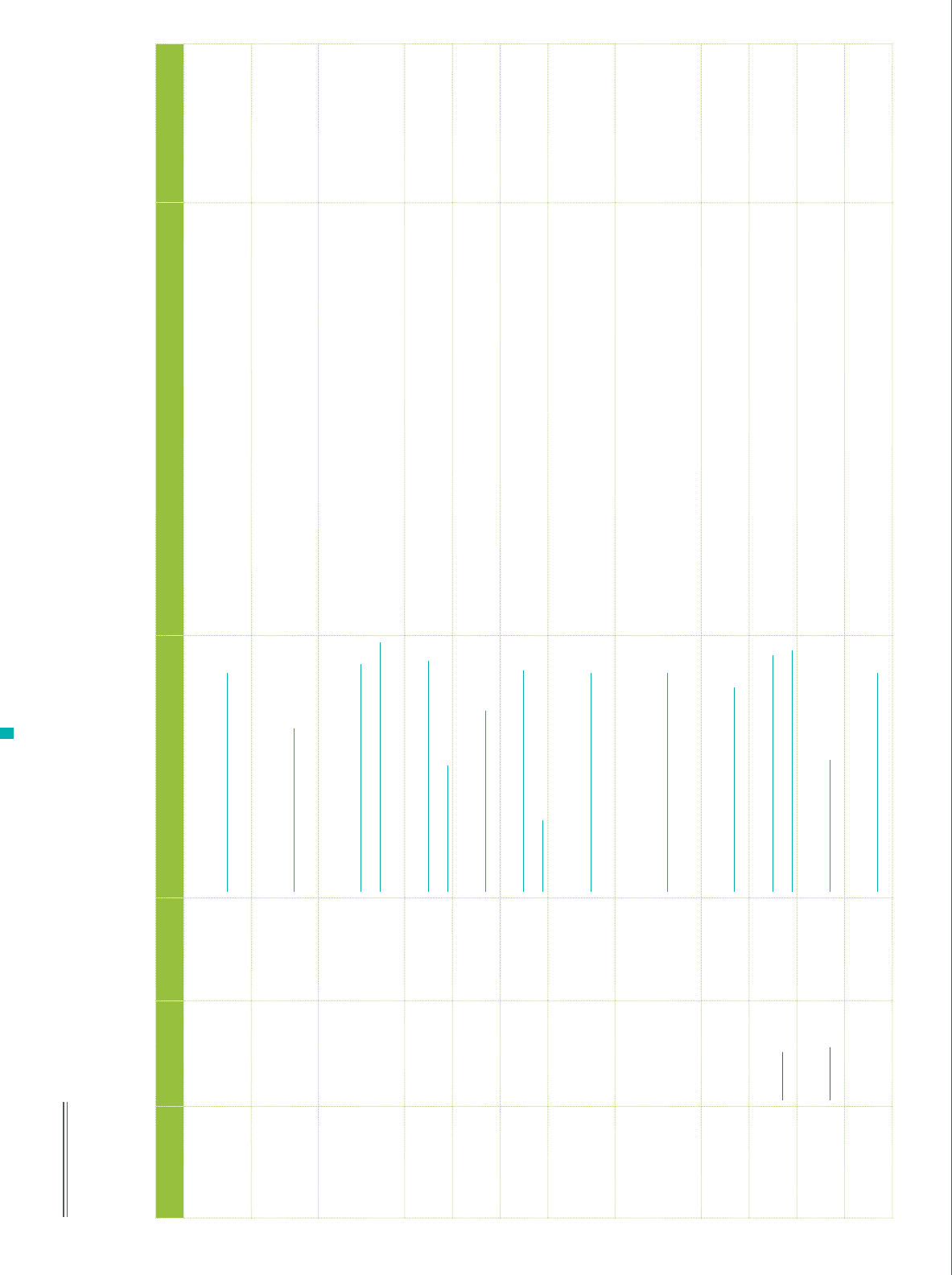
biodiversa stakeholder engagement handbook
102
PROJECT FUNDER DURATION WEB-LINK DESCRIPTION REGION
INVALUABLE BiodivERsA
1/1/2012-
31/12/14
http://www.biodiversa.org/492
Integrating valuations, market and policies for biodiversity
and ecosystem services
Europe, Central/
South America,
Europe, Asia
BeFoFu BiodivERsA
1/5/2010 -
1/5/2013 -
http://www.befofu.org/
Evaluating the ecological and institutional background for
beech forest conservation and management , taking into
account challenges arising from climate change
Europe
VITAL BiodivERsA
1/1/2009 -
1/1/2013
http://www.project-regards.org/
VITAL/VITAL_ProjectSummary.html
Study into the role of plant and soil microbial diversity in the
provision of ecological services in semi-natural grasslands,
and the impacts of agricultural practices on these relation-
ships.
Europe
HighARCS EU FP7
1/12009-
21/12/13
http://www.wraptoolkit.org/proj-
ect_overview.php
Highland Aquatic Resources Conservation and Sustainable
Development
Asia
MOTIVE EU FP7
1/5/2009-
20/4/13
http://motive-project.net/
Models for Adaptive Forest Management Europe
BESAFE EU FP7
1/9/2011-
31/8/2015
http://www.besafe-project.net/
index.php
Biodiversity and Ecosystem Services: Arguments for our
future environment
Europe
Ecocycles BiodivERsA
1/3/2009-
1/3/2012
http://www.biodiversa.org/126
Interacting impacts of land use and climate change on
ecosystem processes: from cyclic herbivores to predators of
conservation concern
Europe: case study
Northern Spain
CONNECT* BiodivERsA
1/1/2012-
31/12/2014
http://www.biodiversa.org/489
Linking biodiversity and ecosystem processes
Europe: case study
North-west delta
landscape (Ijselmeer,
Netherlands)
FORCE EU FP7
1/1/2010-
31/5/2014
http://www.force-project.eu/
Future of reefs in a changing environment Caribbean
BIOSCENE
EUFP5
12/01/2002-
11/30/2005
http://www.edinburgh.ceh.ac.uk/
projectpages/bioscene_page.htm
Scenarios for reconciling biodiversity conservation with
declining agricultural use in the mountains of europe
Europe
HUNT*
EU FP7
1/11/2008-
30/4/2012
http://fp7hunt.net/
HUNTing for Sustainability: research on the wider meaning
of hunting
Europe and Africa
FIREMAN* BiodivERsA
1/3/2009-
1/2/2013
http://www.biodiversa.org/127
Fire management to maintain biodiversity and mitigate
economic loss
Europe
Table A1.1
Case study projects (*stakeholders were interviewed for these projects)
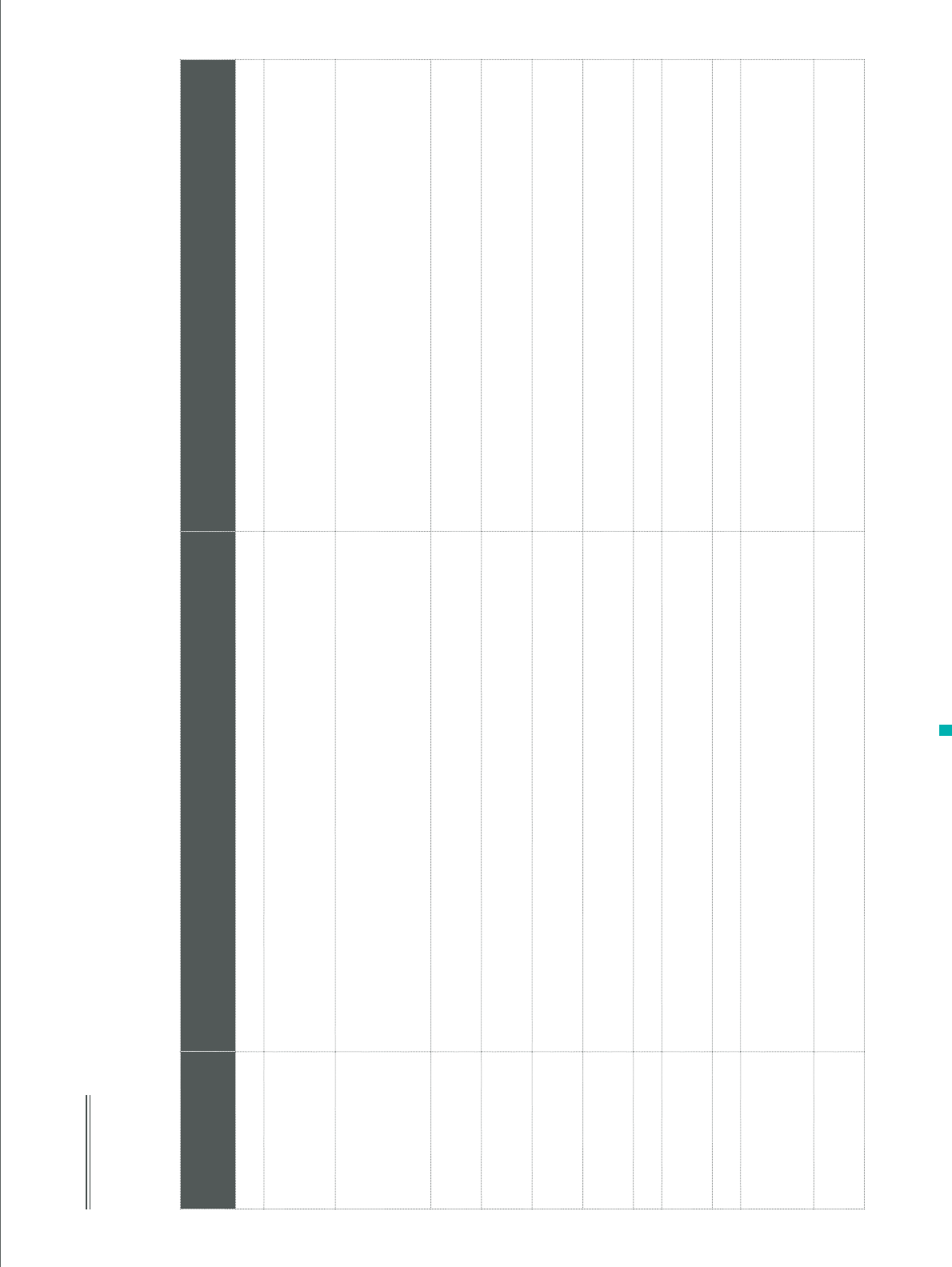
biodiversa stakeholder engagement handbook
103
PROJECT FUNDER DURATION WEB-LINK DESCRIPTION REGION
INVALUABLE BiodivERsA
1/1/2012-
31/12/14
http://www.biodiversa.org/492
Integrating valuations, market and policies for biodiversity
and ecosystem services
Europe, Central/
South America,
Europe, Asia
BeFoFu BiodivERsA
1/5/2010 -
1/5/2013 -
http://www.befofu.org/
Evaluating the ecological and institutional background for
beech forest conservation and management , taking into
account challenges arising from climate change
Europe
VITAL BiodivERsA
1/1/2009 -
1/1/2013
http://www.project-regards.org/
VITAL/VITAL_ProjectSummary.html
Study into the role of plant and soil microbial diversity in the
provision of ecological services in semi-natural grasslands,
and the impacts of agricultural practices on these relation-
ships.
Europe
HighARCS EU FP7
1/12009-
21/12/13
http://www.wraptoolkit.org/proj-
ect_overview.php
Highland Aquatic Resources Conservation and Sustainable
Development
Asia
MOTIVE EU FP7
1/5/2009-
20/4/13
http://motive-project.net/
Models for Adaptive Forest Management Europe
BESAFE EU FP7
1/9/2011-
31/8/2015
http://www.besafe-project.net/
index.php
Biodiversity and Ecosystem Services: Arguments for our
future environment
Europe
Ecocycles BiodivERsA
1/3/2009-
1/3/2012
http://www.biodiversa.org/126
Interacting impacts of land use and climate change on
ecosystem processes: from cyclic herbivores to predators of
conservation concern
Europe: case study
Northern Spain
CONNECT* BiodivERsA
1/1/2012-
31/12/2014
http://www.biodiversa.org/489
Linking biodiversity and ecosystem processes
Europe: case study
North-west delta
landscape (Ijselmeer,
Netherlands)
FORCE EU FP7
1/1/2010-
31/5/2014
http://www.force-project.eu/
Future of reefs in a changing environment Caribbean
BIOSCENE EUFP5
12/01/2002-
11/30/2005
http://www.edinburgh.ceh.ac.uk/
projectpages/bioscene_page.htm
Scenarios for reconciling biodiversity conservation with
declining agricultural use in the mountains of europe
Europe
HUNT* EU FP7
1/11/2008-
30/4/2012
http://fp7hunt.net/
HUNTing for Sustainability: research on the wider meaning
of hunting
Europe and Africa
FIREMAN* BiodivERsA
1/3/2009-
1/2/2013
http://www.biodiversa.org/127
Fire management to maintain biodiversity and mitigate
economic loss
Europe
PROJECT TOPICS COVERED AS REGARD STAKEHOLDER ENGAGEMENT METHODS OF STAKEHOLDER ENGAGEMENT DISCUSSED
INVALUABLE Barriers to engagement, expectations Policy briefs, newsletters
BeFoFu
Analyse management and conservation strategies, assess climate change
impacts, understand policies and political structures, evaluate impacts of
market-based instruments, and develop policy recommendations
Delphi Interviews, stakeholder advisory board, workshop, website,
project leaets, publications
VITAL
Develop conceptual model of relationships functional diversity and ecosys-
tem service delivery, determine how management changes alter the services
agro-ecosystems can provide, and demonstrate impacts on development
potential for local economies.
Workshops, focus group discussions, role-playing games, expert
interviews, publications, project leaets
HighARCS
Stakeholder representation, monitoring of management plan implementa-
tion Delphi method, participatory mapping,
MOTIVE
Project stakeholder engagement protocol, stakeholder identication, social
learning, expectations Co-development of climate-forestry models with stakeholders
BESAFE
Snowball stakeholder identication, stakeholder input to research direc-
tion, local culture Co-development of web-based tool, policy briefs, workshops
Ecocycles
Planning outputs of research, managing conict, barriers between science
and management
Co-production of adaptive protocol for management, consultative
forum
CONNECT Informing government decision making Co-design of choice experiment for specic environmental context
FORCE
Scoping activities, systematic stakeholder mapping, bounding communi-
ties for stakeholder identication
Community workshops, interviews, construction of historical time-
lines
BIOSCENE Stakeholder identication according to views, managing conict Semi-structured interviews, scenario analysis workshops
HUNT
Managing conict, assessing long term change in stakeholder relations,
continuity of engagement, language dierences between researchers and
stakeholders
National Consultative fora, scenario analysis, multi-criteria decision
analysis
FIREMAN
Conict management, benets of international meetings for stakeholders
and eld based meetings
International project conference, scenario analysis, workshops with
eld demonstrations, historical analysis
Table A1.2
A summary of the topics covered and methods discussed during interviews

PHOTOGRAPHS
Cover page: Path to the Lac des Vaches looking towards the Aiguille de la Vanoise,
Vanoise National Park, Savoie, France, August. By Benjamin Barthelemy/
naturepl.com
Part 1 (p.9): Lowland bog landscape seen from the air. South Estonia, Europe, October
2010 by Sven Zacek/ naturepl.com
Part 2 (p.25): Danube Delta sherman Florin Moisa shaking weed o traditional fyke nets,
Danube Delta, Romania, June 2013. By Lundgren / Wild Wonders of Europe/
naturepl.com
Part 3 (p.35): Two farmers in a traditional horse drawn cart near Codrii Reserve, Central
Moldova, July 2009 By Wild Wonders of Europe/Geslin/ naturepl.com
Part 4 (p.53): Cornowers (Centaurea cyanus) and poppies (Papaver rhoeas) growing on
fallow elds near Orvieto, Umbria, Italy. June 2010. By Paul Harcourt Davies/
naturepl.com
Part 5 (p.61): Balearic Green Toad (Pseudepidalea balearica / Bufo balearicus) in prole.
Mallorca, The Mediterranean. By Bert Willaert/ naturepl.com
Part 6 (p.71): Carpet of Bluebells (Endymion nonscriptus) in Beech (Fagus sylvatica)
woodland, Micheldever Woods, Hampshire, England, UK, April. By Guy
Edwardes / 2020VISION/ naturepl.com
Part 7 (p.79): Bank vole {Clethrionomys glareolus} portrait in snow. UK. By Jane Burton/
naturepl.com
Part 8 (p.91): Sheep in a eld near the Dorset Gap, Dorset, UK June 2012. By David
Noton/ naturepl.com
Copyrights

ICONS
p.8: Group designed by Lucian Dinu from the thenounproject.com
p.15: Fence, Public Domain, available at thenounproject.com
p.24: Question designed by Anas Ramadan from the thenounproject.com
p.33: Communication designed by Mister Pixel from the thenounproject.com
p.34: Crosshair designed by Ryan Beck from the thenounproject.com
p.40: Vote designed by Luis Prado from the thenounproject.com
p.47: Agreement designed by Stephanie Wauters from the thenounproject.com
p.52: Hour Glass designed by Arthur Shlain from the thenounproject.com
p.59: Clock designed by Cris Dobbins from the thenounproject.com
p.60: Gears designed by Hubert Orlik–Grzesik from the thenounproject.com
p.70: Architect designed by Luis Prado from the thenounproject.com
p. 78: Tug of war, Public Domain, available at thenounproject.com
p.86: Arrow designed by Michael Harman from the thenounproject.com
p.90: Compass, Public Domain, available at thenounproject.com
LAYOUT
Layout by Angélique Berhault, Belgian Biodiversity Platform/ BELSPO - 2014

BIODIVERSA2 PARTNERS
Fondation pour la Recherche sur la Biodiversité (FRB), FRANCE [coordinator]
Fonds zur Forderung der Wissenschaftlichen Forschung (FWF), AUSTRIA
Belgian Science Policy Oce (BELSPO), BELGIUM
Bulgarian National Science Fund (BNSF), BULGARIA
Estonian Research Council (ETAG), ESTONIA
Agence National de la Recherche (ANR), FRANCE
Ministère de l’Ecologie, du Développement Durable et de l’Énergie (MEDDE), FRANCE
Bundesministerium für Bildung und Forschung (BMBF)/ Projektträger im Deutschen Zentrum für Luft-und
Raumfahrt e.V. (PT-DLR), GERMANY
Deutsche Forschungsgemeinschaft (DFG), GERMANY
Ministry of Rural Development (VM), HUNGARY
Research Council of Lithuania (RCL), LITHUANIA
Nederlandse organisatie voor Wetenschappelijk Onderzoek (NWO), THE NETHERLANDS
Research Council of Norway (RCN), NORWAY
Fundação para a Ciência e a Tecnologia (FCT), PORTUGAL
Ministerio de Economia y Competitividad (MINECO), SPAIN
Swedish Research Council for Environment, Agricultural Sciences and Spatial Planning (FORMAS), SWEDEN
Swedish Environmental Protection Agency (SEPA), SWEDEN
Ministry of Food, Agriculture and Livestock (MFAL), TURKEY
Department for Environment, Food and Rural Aairs (DEFRA), UNITED KINGDOM
Joint Nature Conservation Committee (JNCC), UNITED KINGDOM
Natural Environment Research Council (NERC), UNITED KINGDOM
Partners
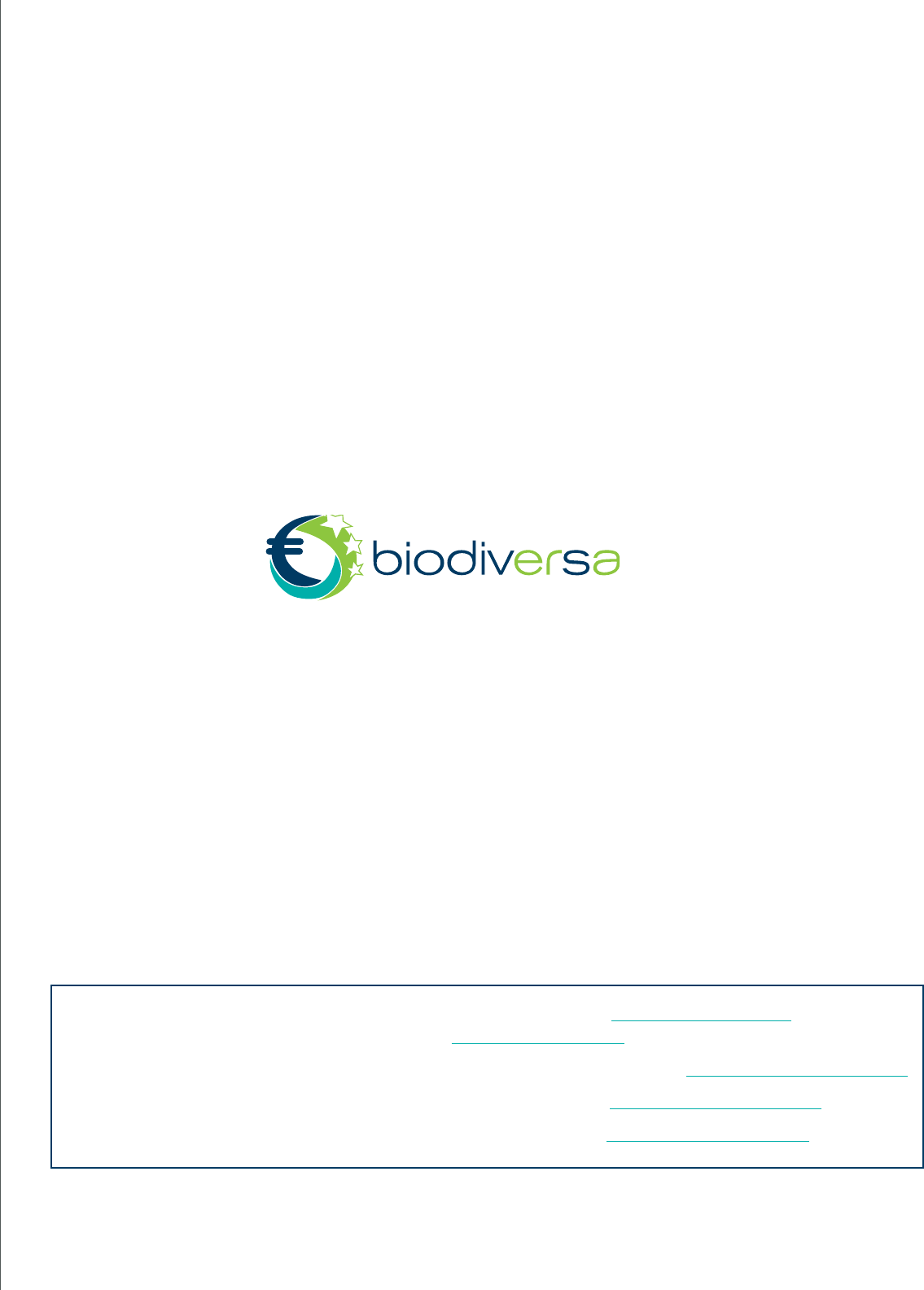
The ERA-NET promoting European research on biodiversity
For further information on this report, contact: Helen Baker ([email protected].uk)
or Matt Smith ([email protected].uk)
The templates mentioned in this report and the annexes can be downloaded from http://www.biodiversa.org/577
For further information on BiodivERsA funded projects, refer to http://www.biodiversa.org/75
More information on the BiodivERsA database is available at http://www.biodiversa.org/8
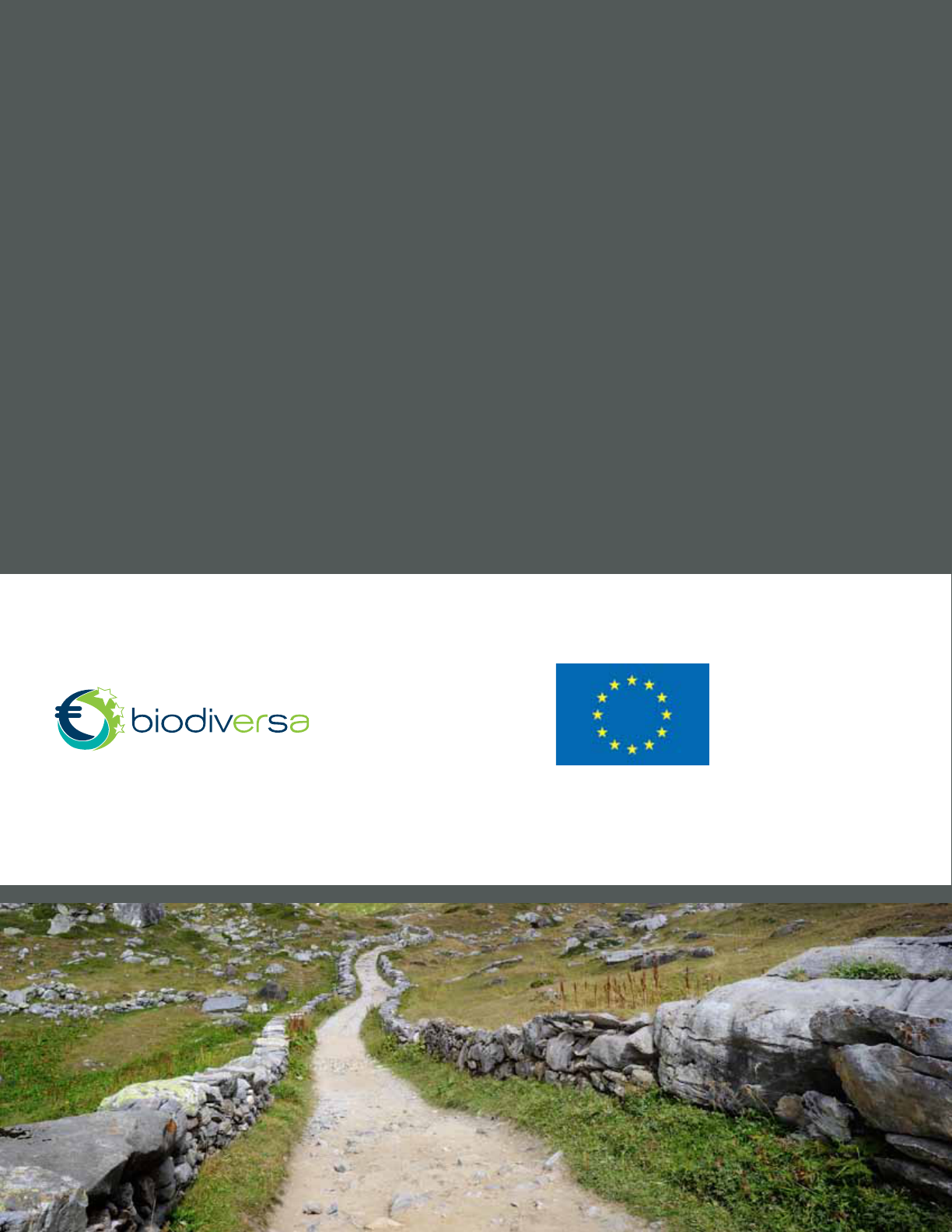
BiodivERsA is funded by the
European Commission
The ERA-NET promoting European research on biodiversity
